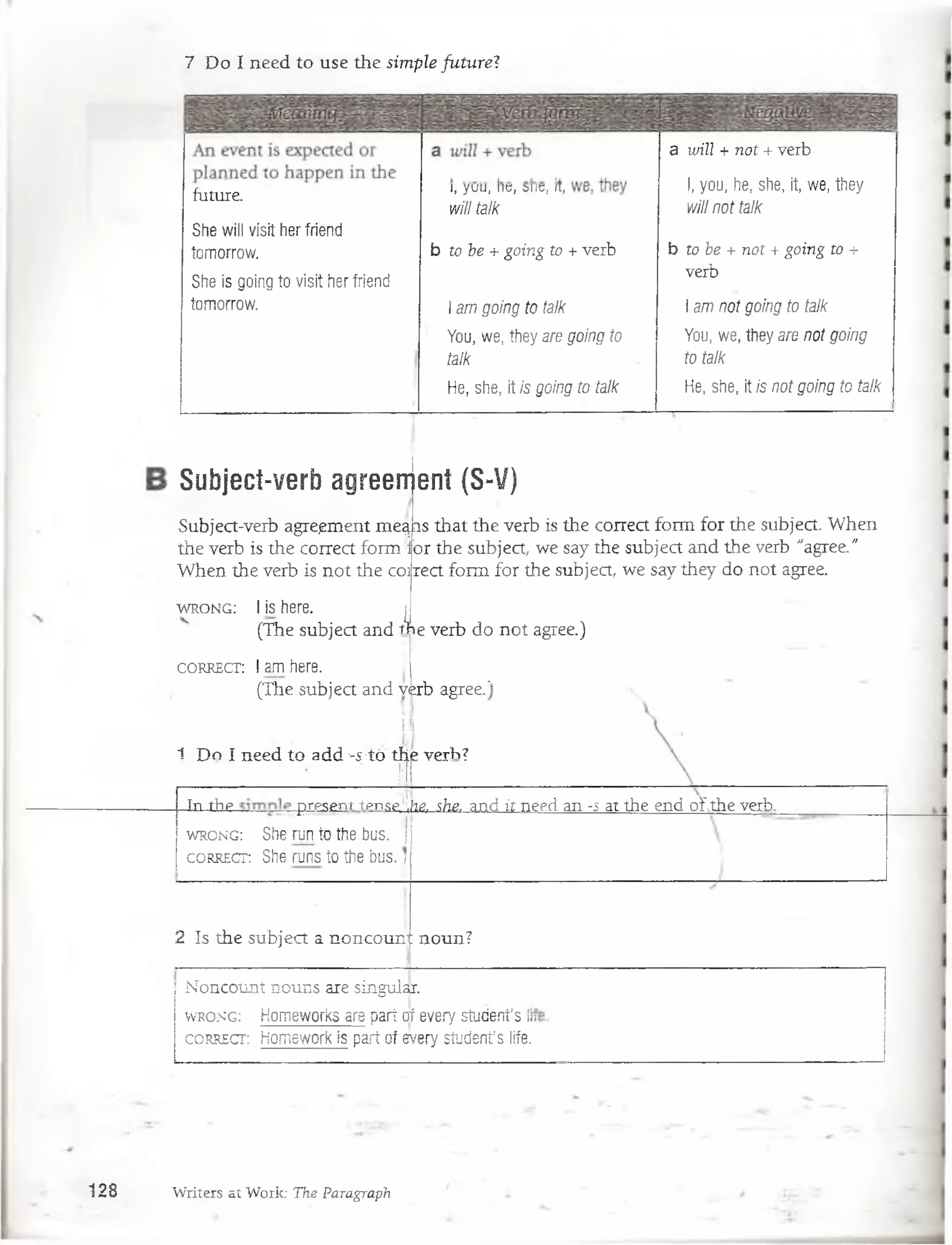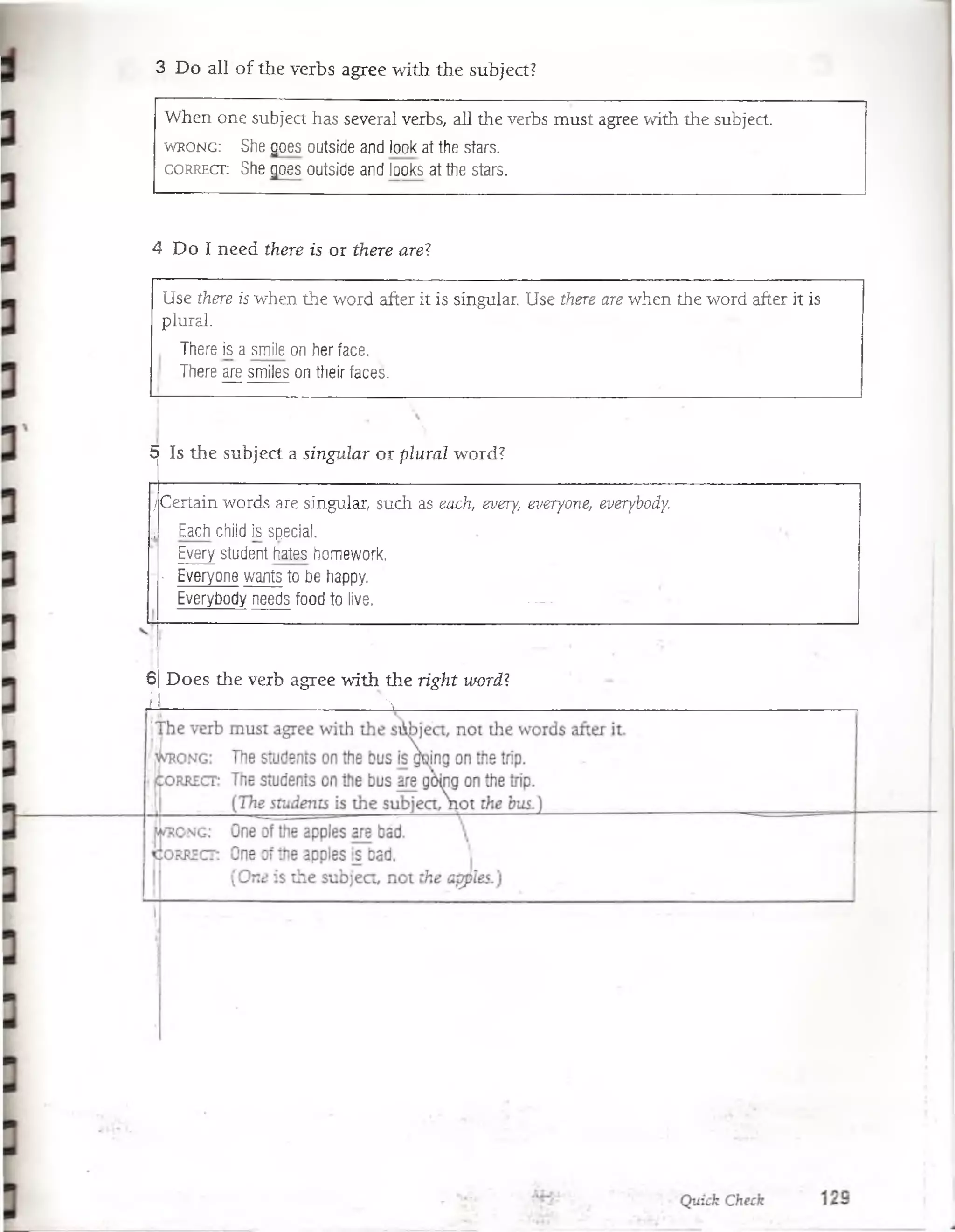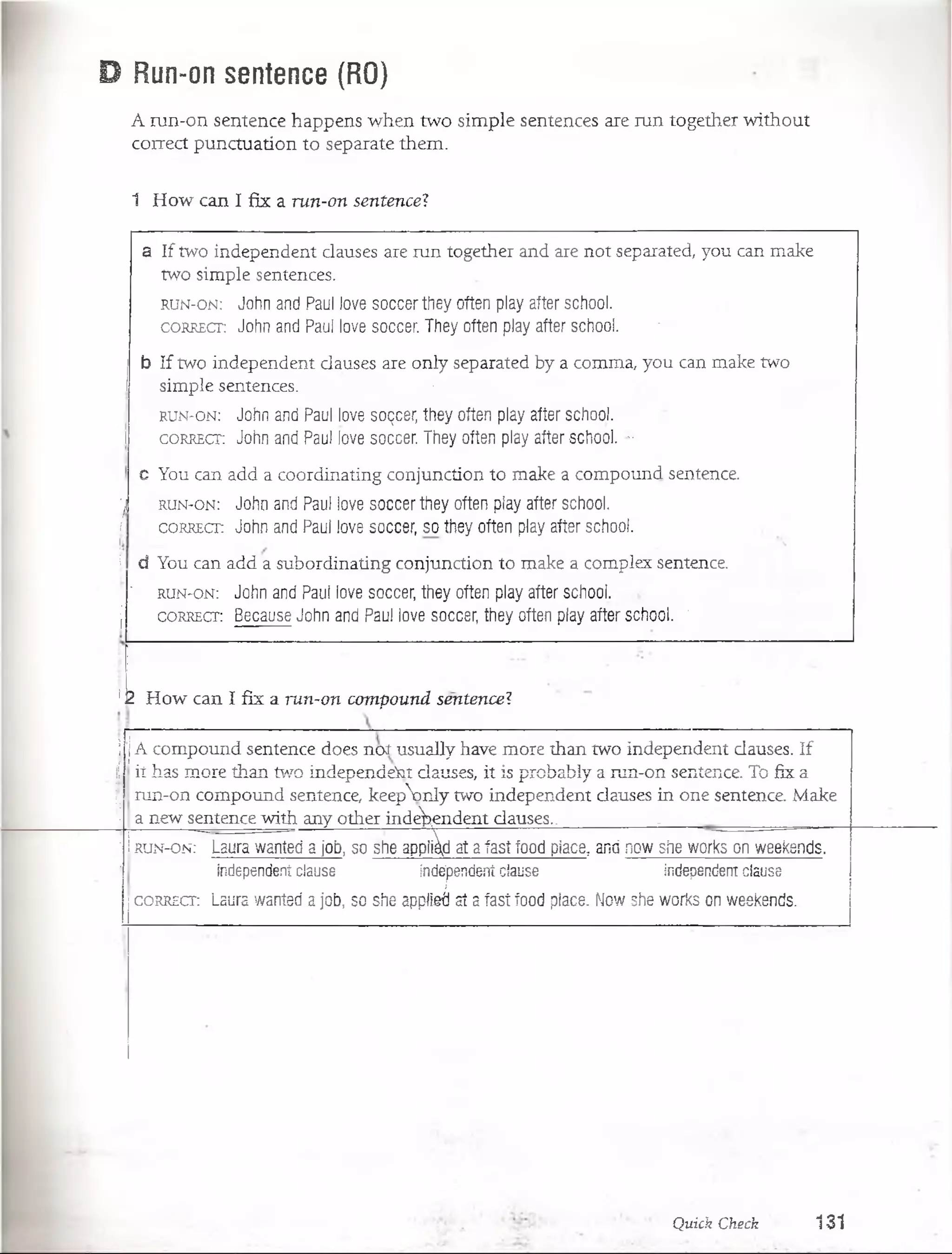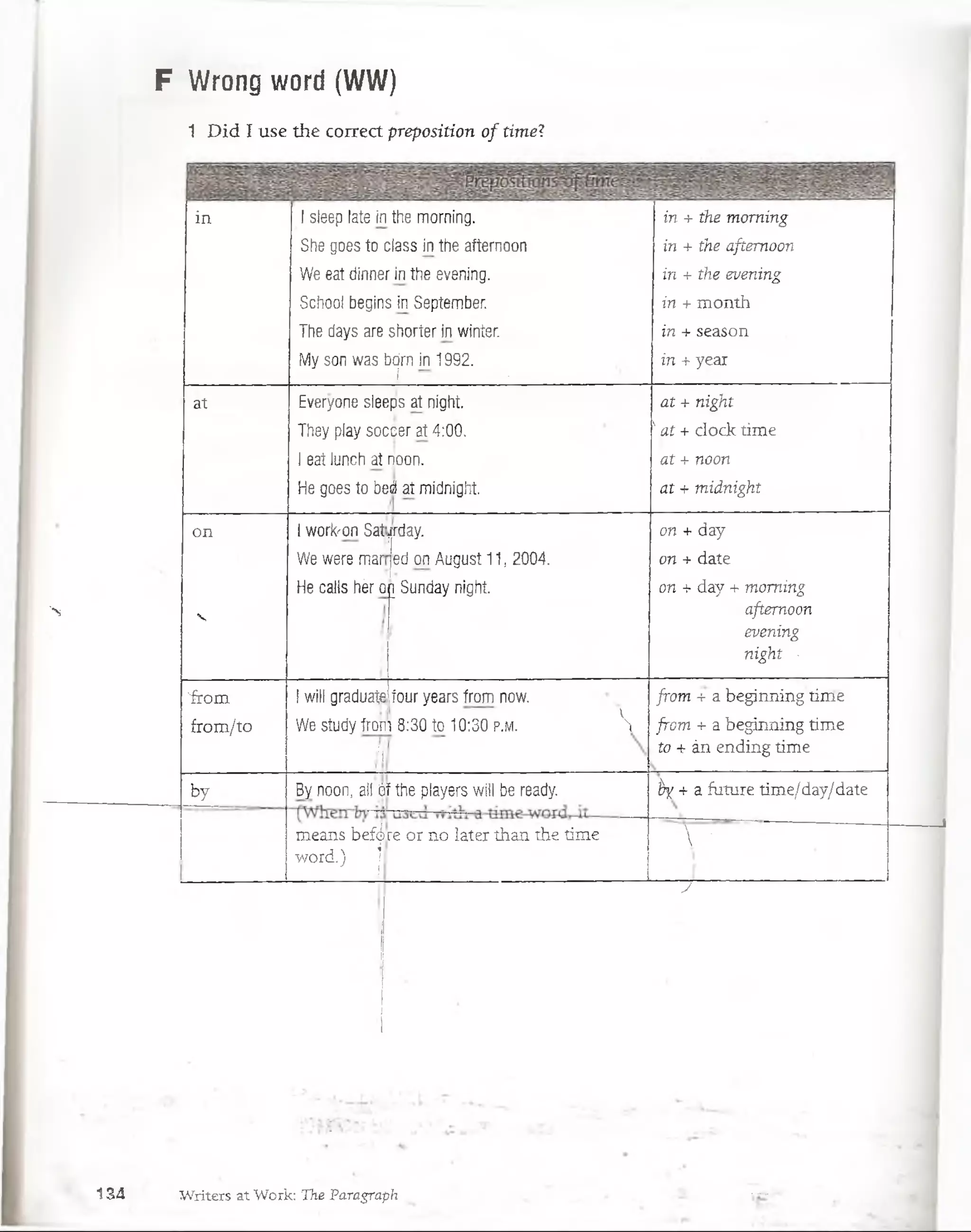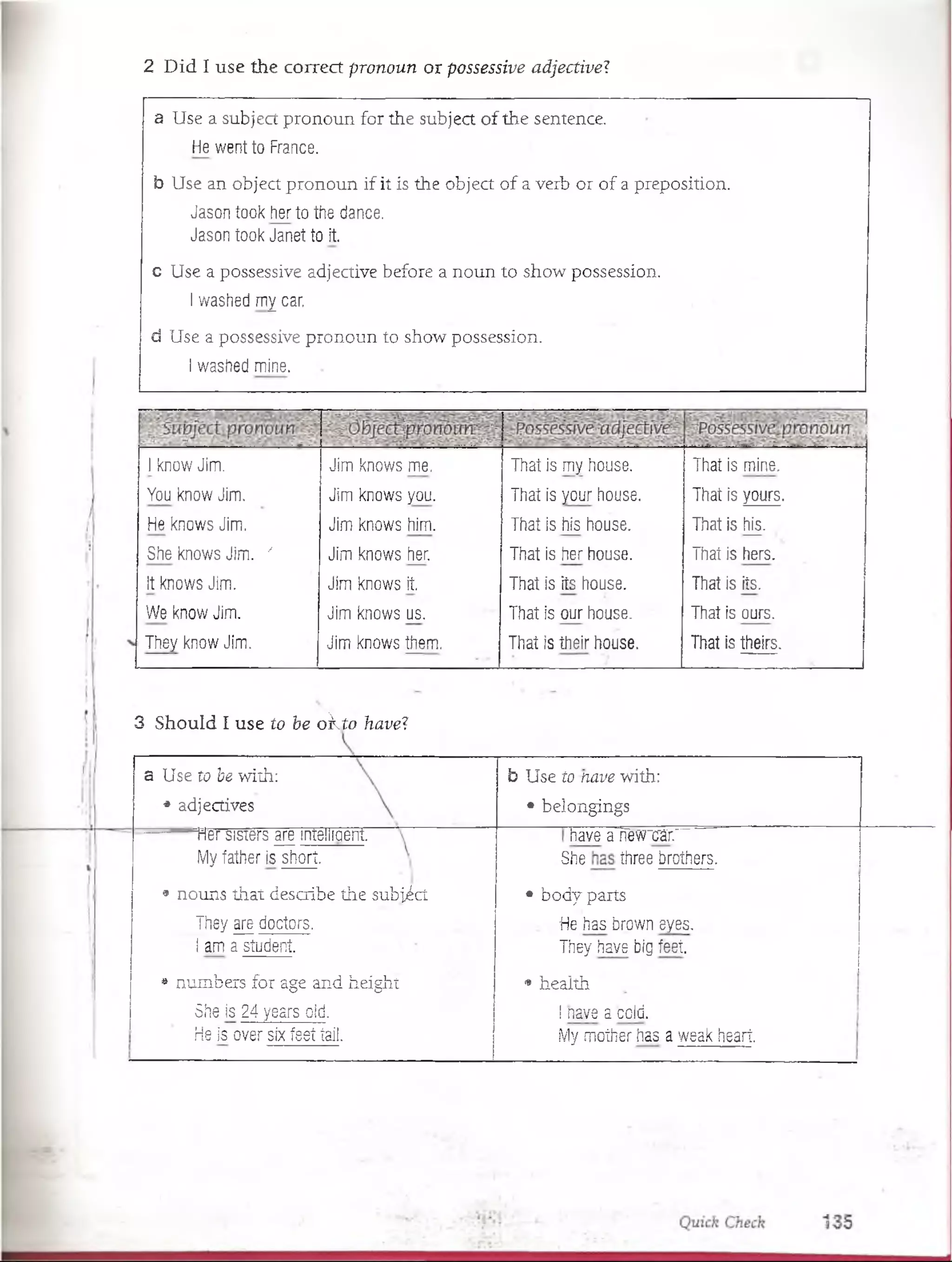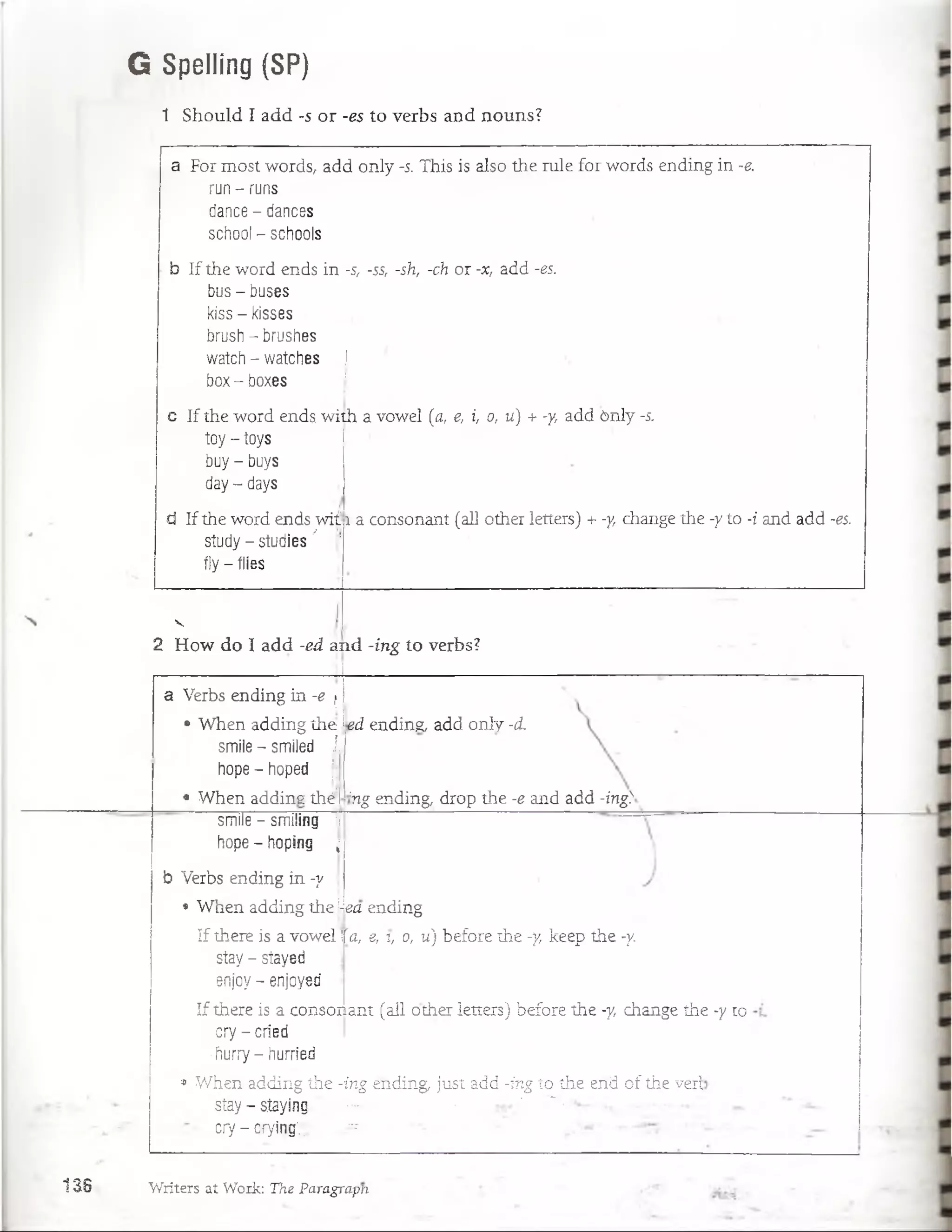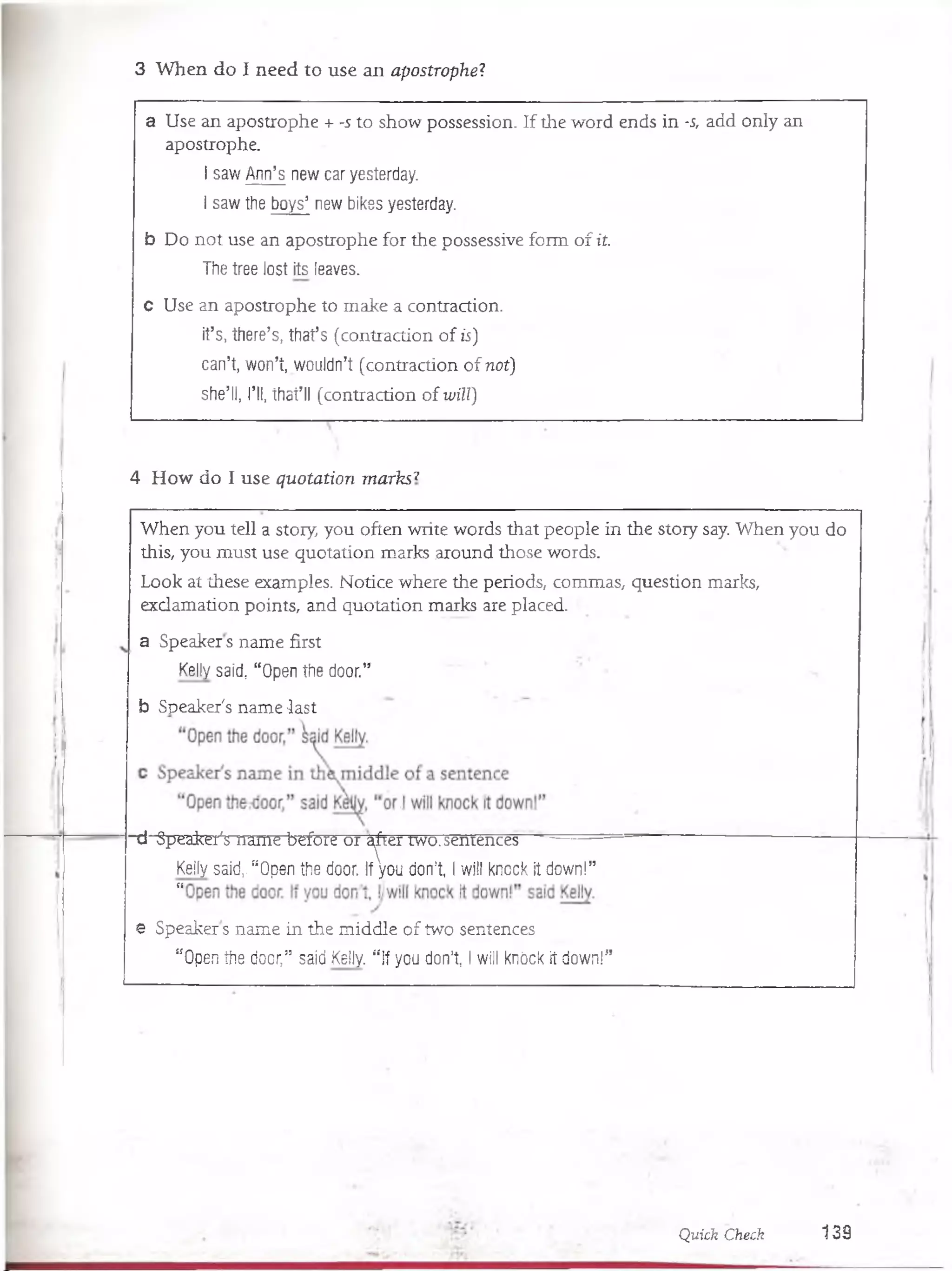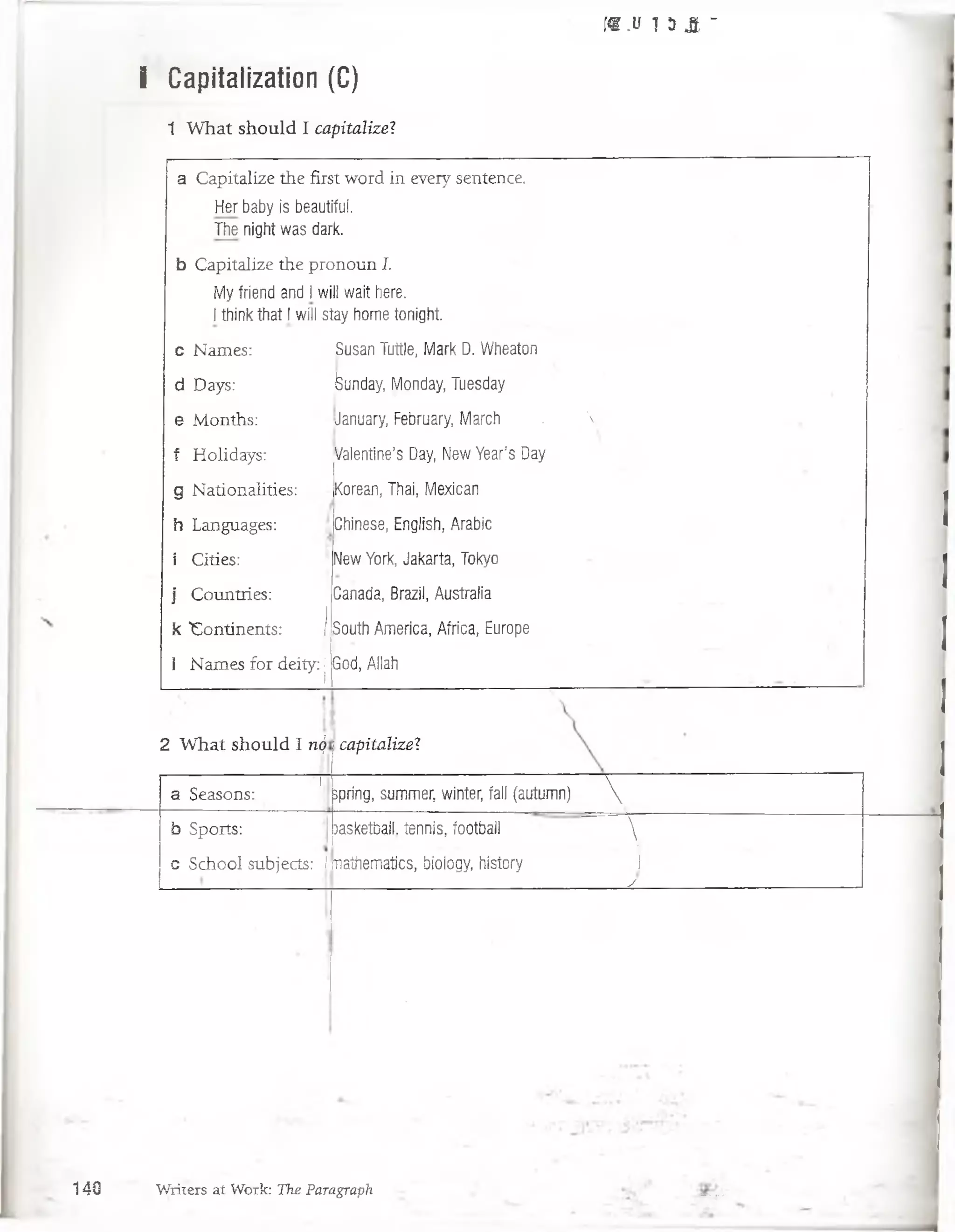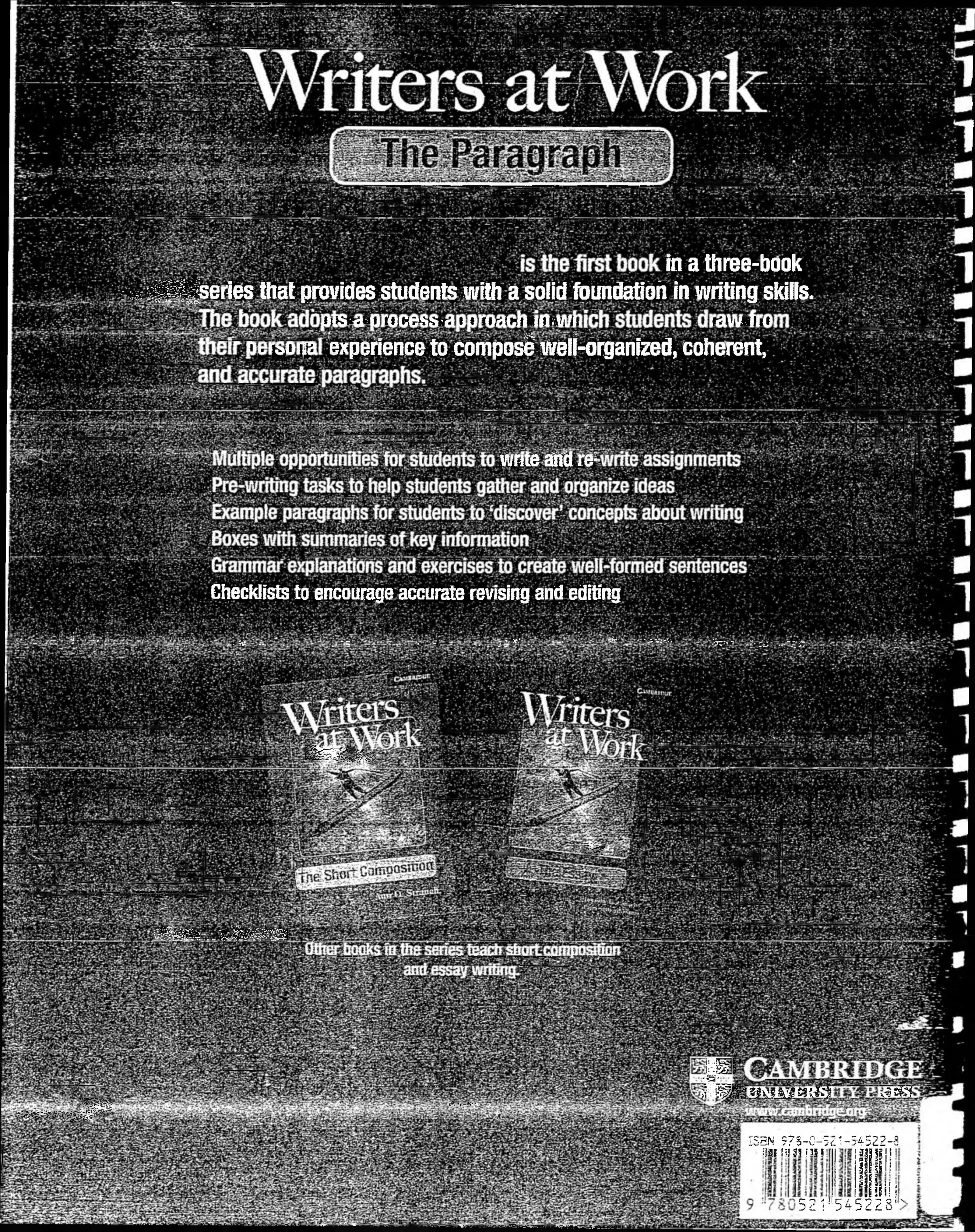This document provides an overview and table of contents for the book "Writers at Work: The Paragraph" by Jill Singleton. It introduces the book's purpose of teaching readers how to write effective paragraphs and outlines the book's contents. The book is divided into 9 chapters that cover various paragraph writing topics and walking readers through the writing process. Each chapter also includes exercises and self-checks to help readers practice and improve their paragraph writing skills.
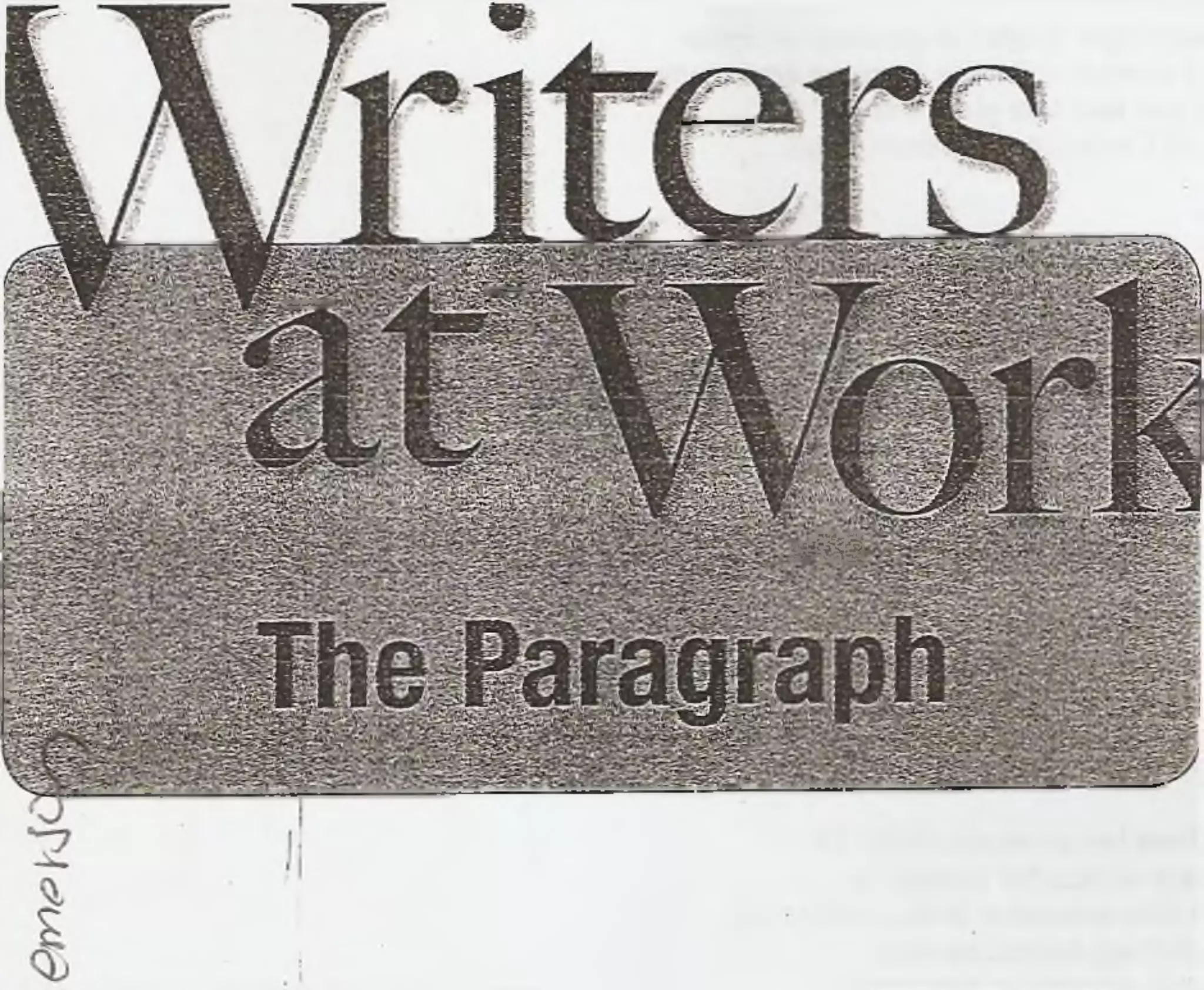
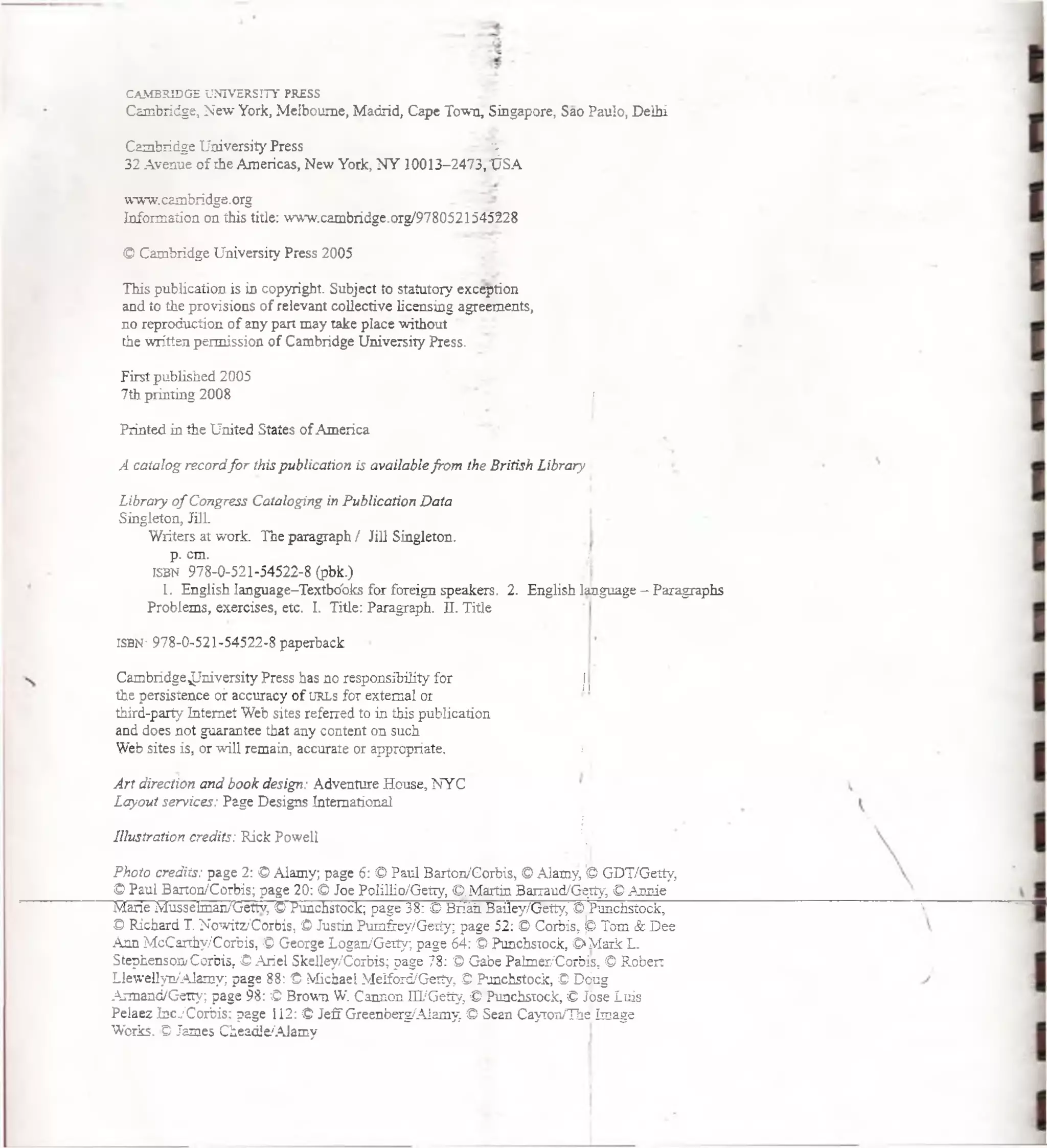
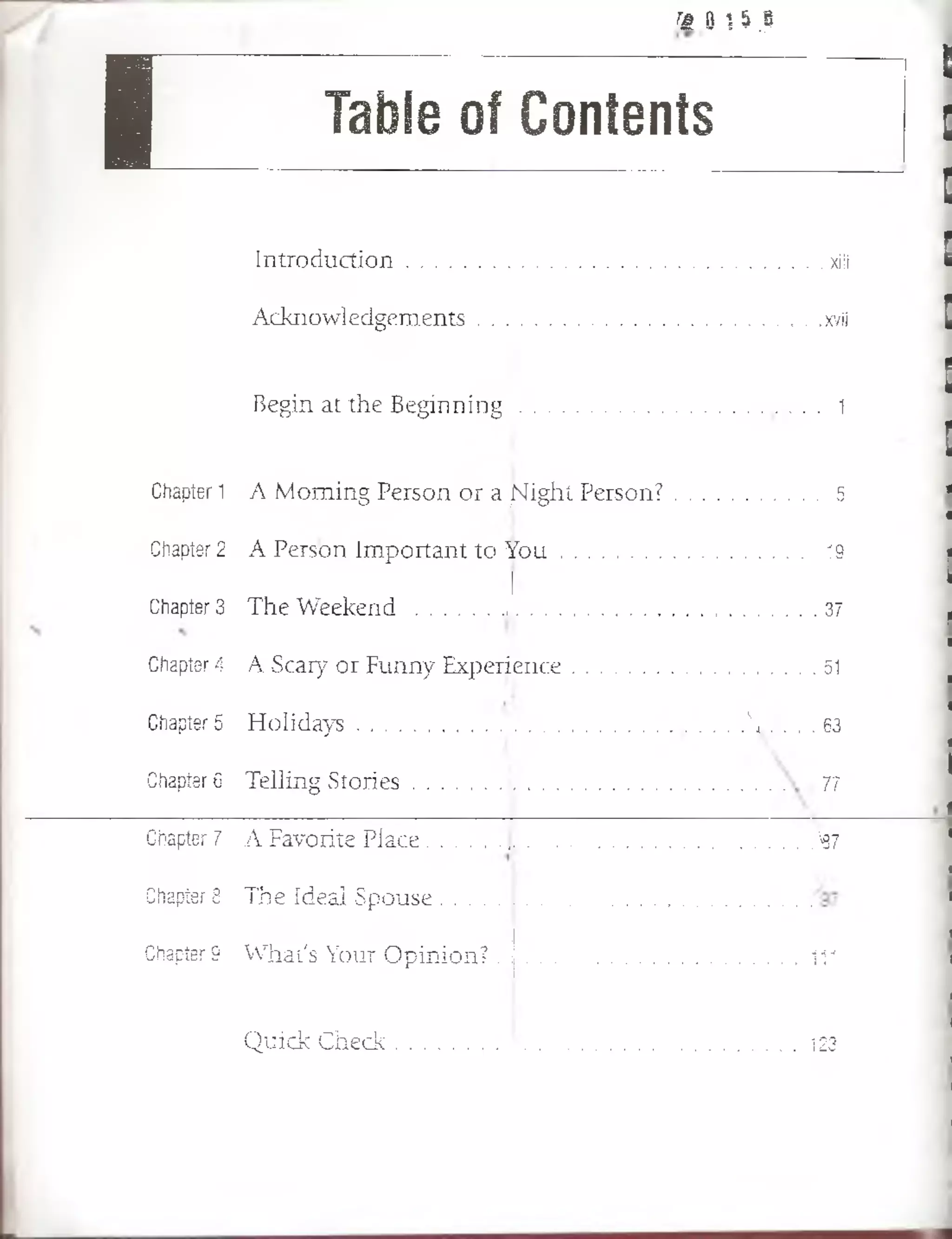
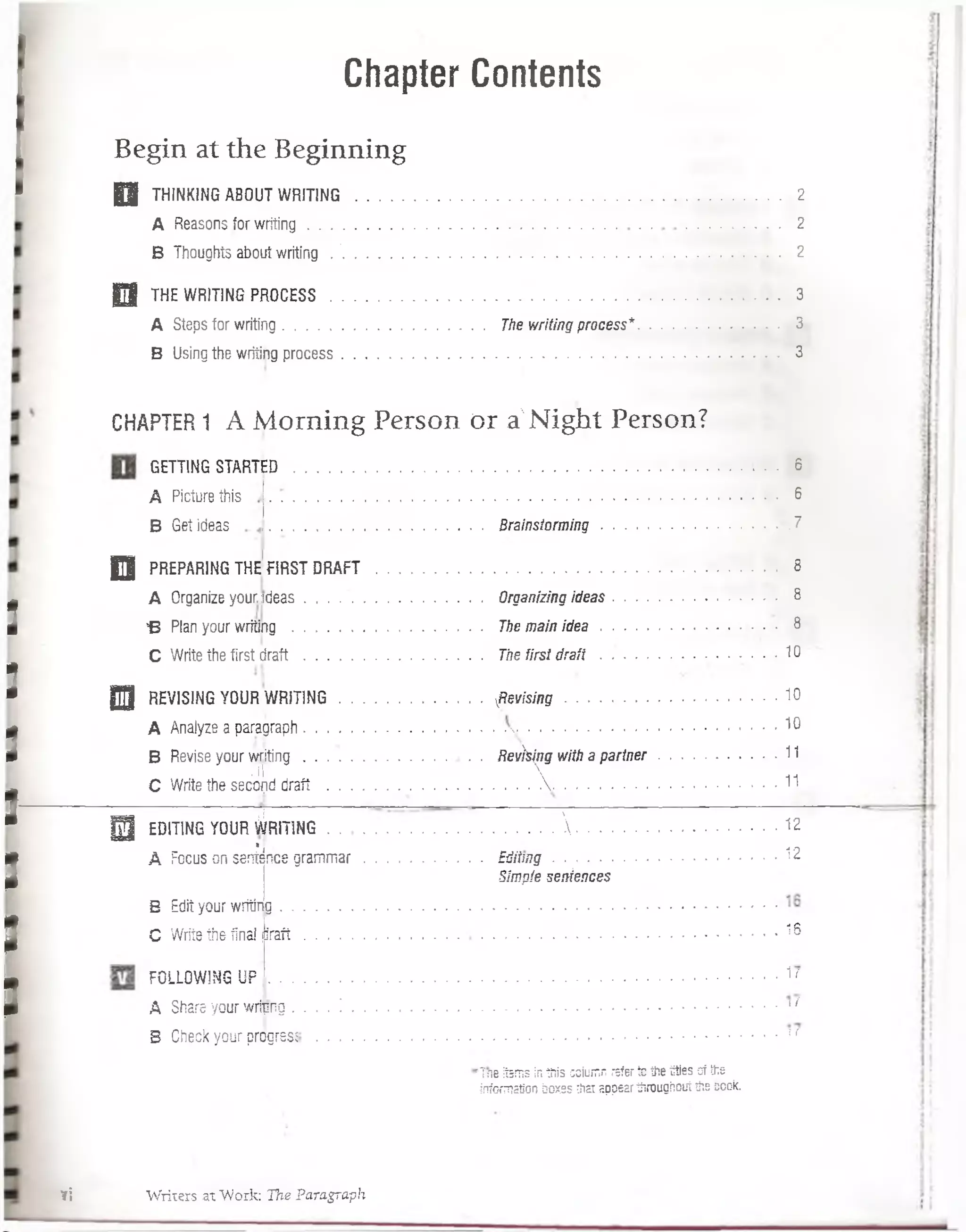

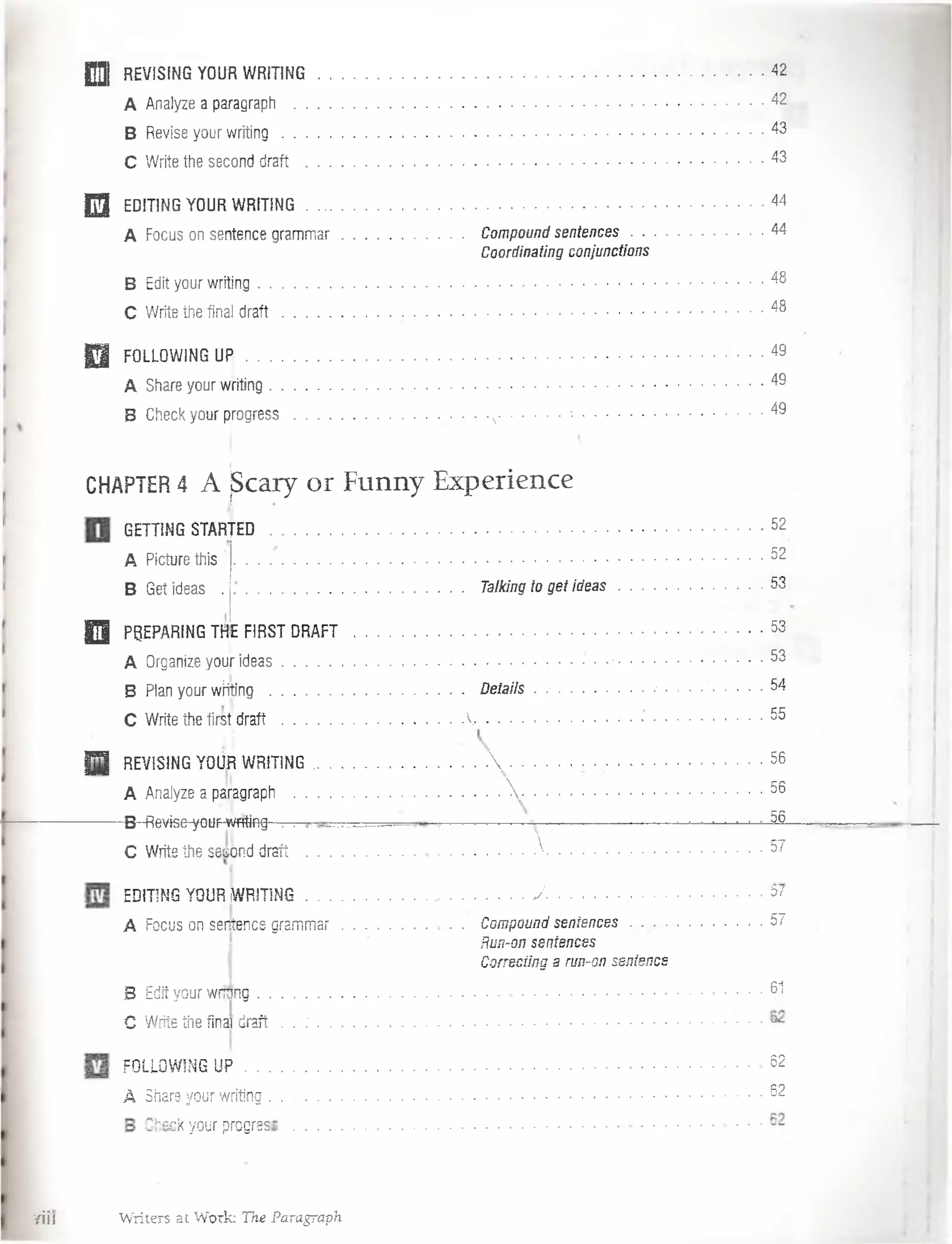

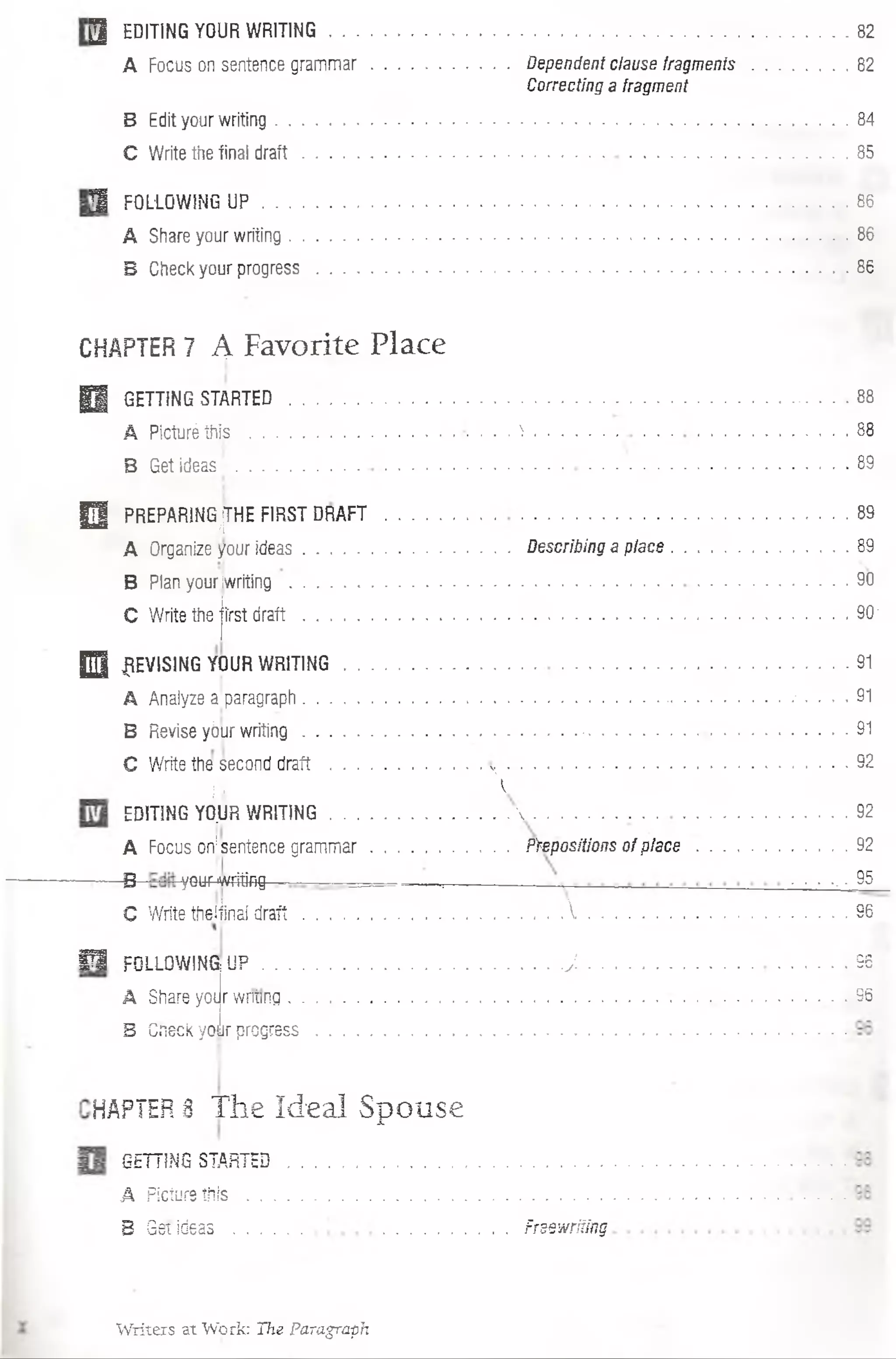
![O PREPARING THE FIRST D R A F T ........................................................................................................ 100
A Organize your ideas . ...................... Organizingbyim portance.......................100
B Plan your writing ................................................... Transitions................................................... 101
C Write the first d ra ft...........................................................................................................................103
D ] REVISING YOUR W RITING....................................... 103
A Analyze a paragraph..................................... 103
B Revise your w ritin g ...........................................................................................................................104
C Write the second draft ................................. 104
E l EDITING YOUR W RITING..................................................................... 105
A Focus on sentence gram m ar i . . . . . Sentence varieiy. . . ............................ 105
B Edit your writing.................................. .*...................................................................................... 108
C Write the final d ra ft..............................•.............. ............... v ........................108
H FOLLOWINGUP .................. . '.................................................................................. 109
A Share your writing .......................I .......................................................................................... 109
B Check your progress........................./ I ..........................................................................................109
CHAPTER9 W hat's Your O pinión?
vGETTING STARTED............................./I......................................................................................112
A Picturethis ......................................... ; .......................................................................................... 112
B Get ideas ..........................■.............J ' ....................................... 113
1 •
PREPARING THE FIRST DRAFT ....................................................... I .......................... 114
A Organize your ideas............................í¡¡..............Quilines . . . . . . . . . . ...................... 114
B Plan your writing ............................j ’| ......................................................................V . . . . 118
-C - Write4he--áfs^daft - , . : . . . . : ...................... ^ - - ^ — 1-1^
REVISING YOUR WRITING
A Analyze a paragraph . . .
B Revise your writing . . .
C Write the second draft .
EDITING YOUR W RITING.......................... ¡................................................... 120
!
A Focus on sentence gram m ar.I ................................................................... 1 2 0
B Edit vcur writing.................................................................................................. 121
C Write the finaJ d ra ft................................................. .................................... 121
Table of Contents](https://image.slidesharecdn.com/writersatwork-130924081026-phpapp02/75/Writers-at-work-9-2048.jpg)
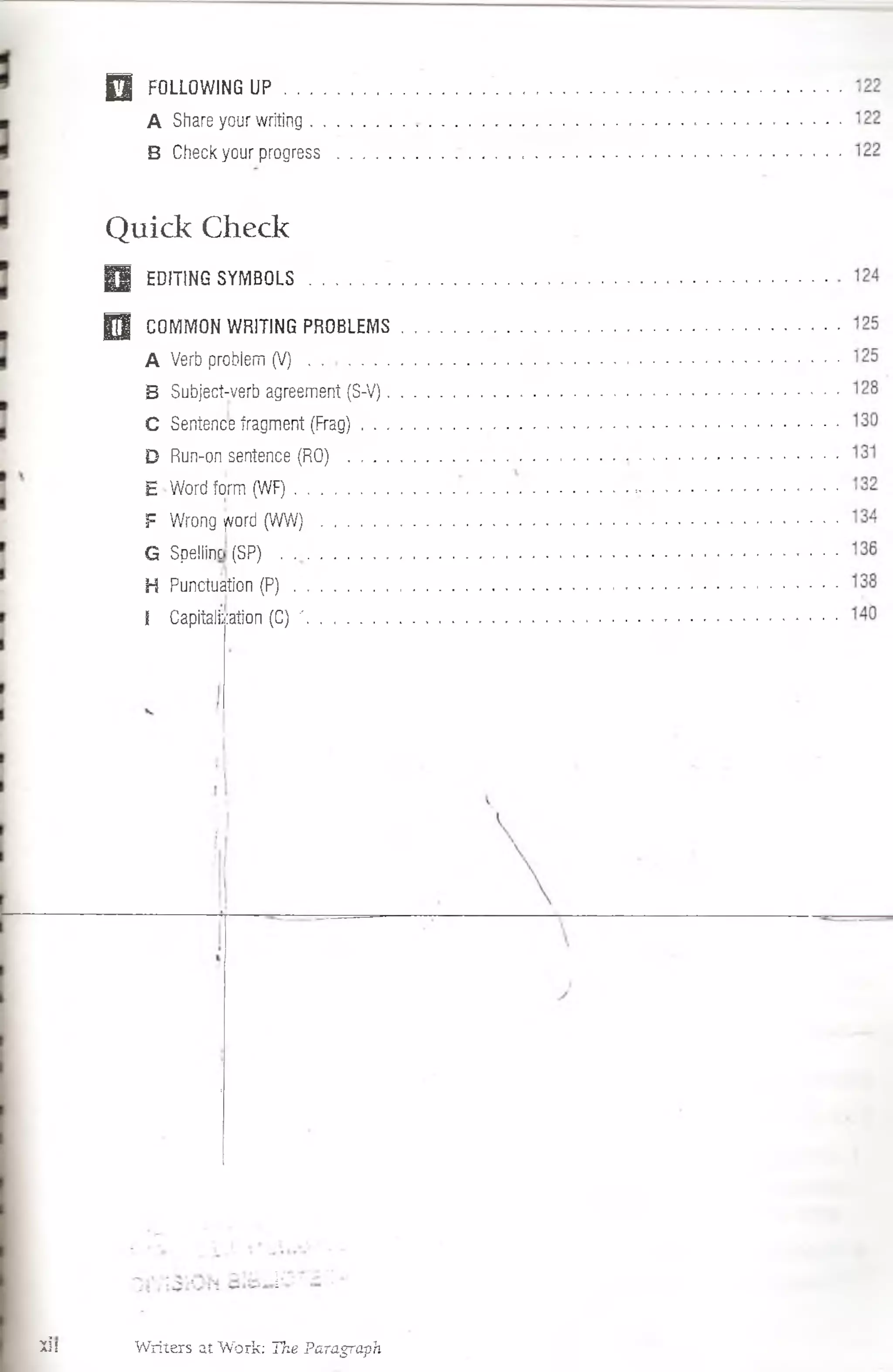
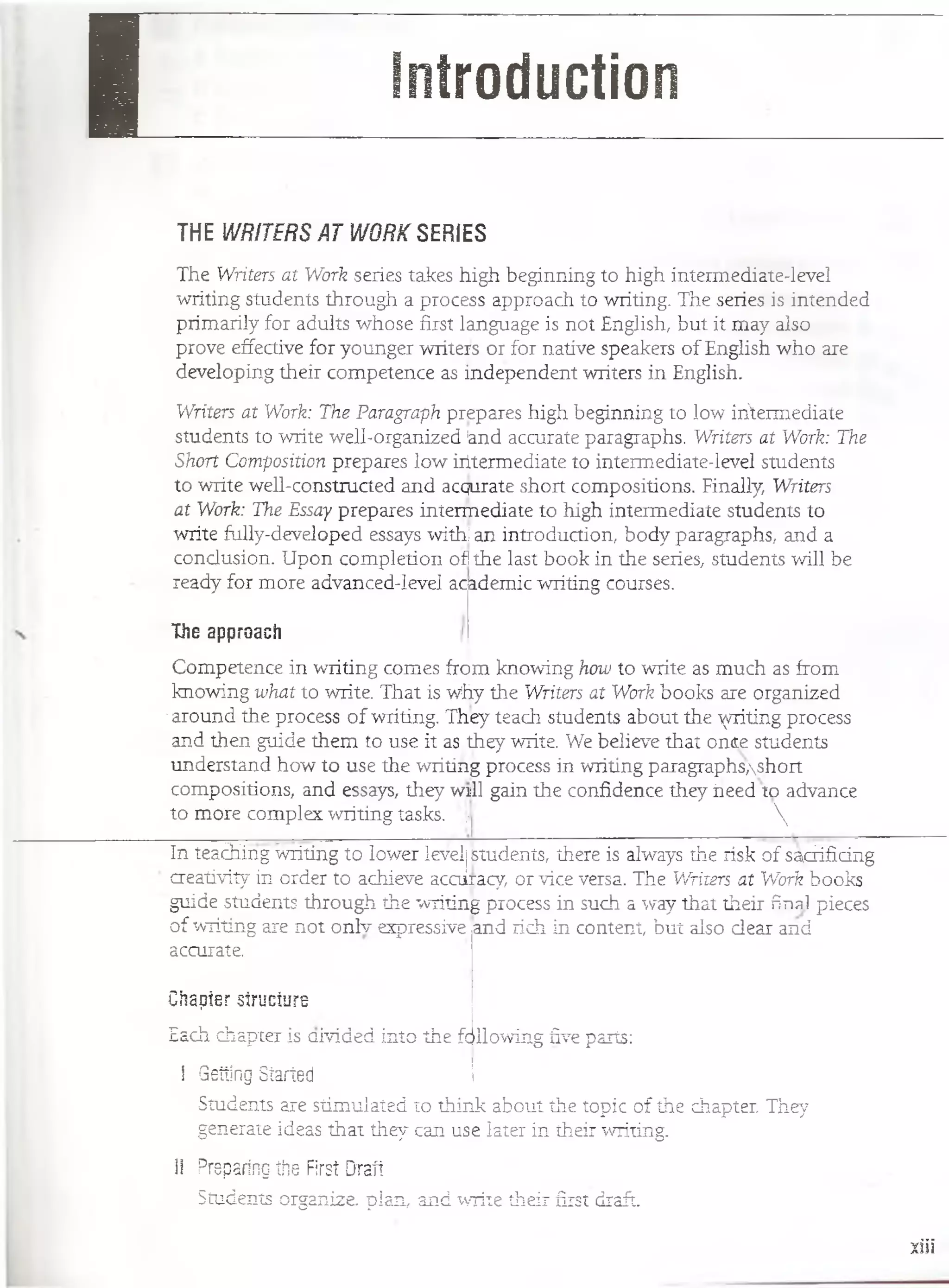

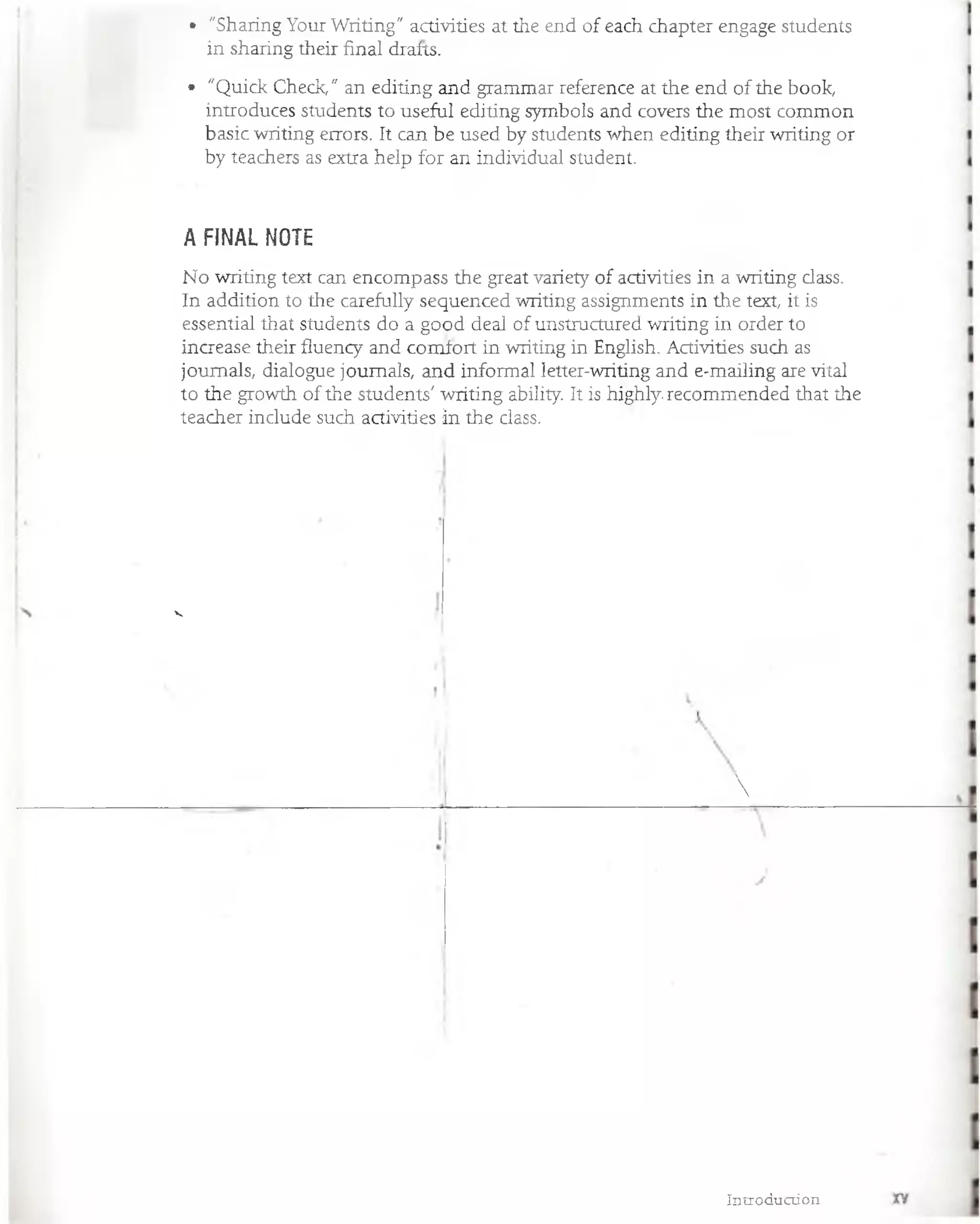
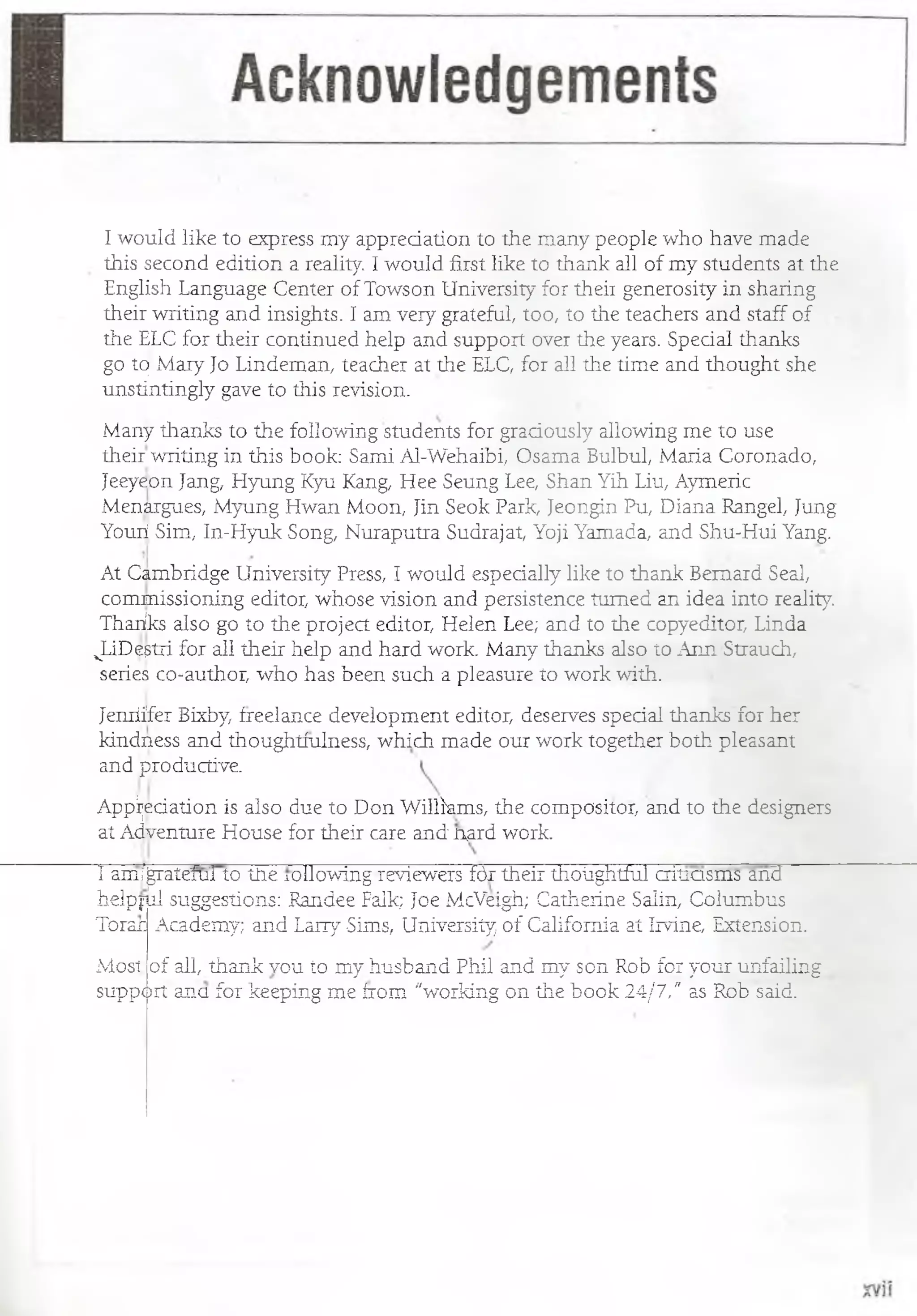
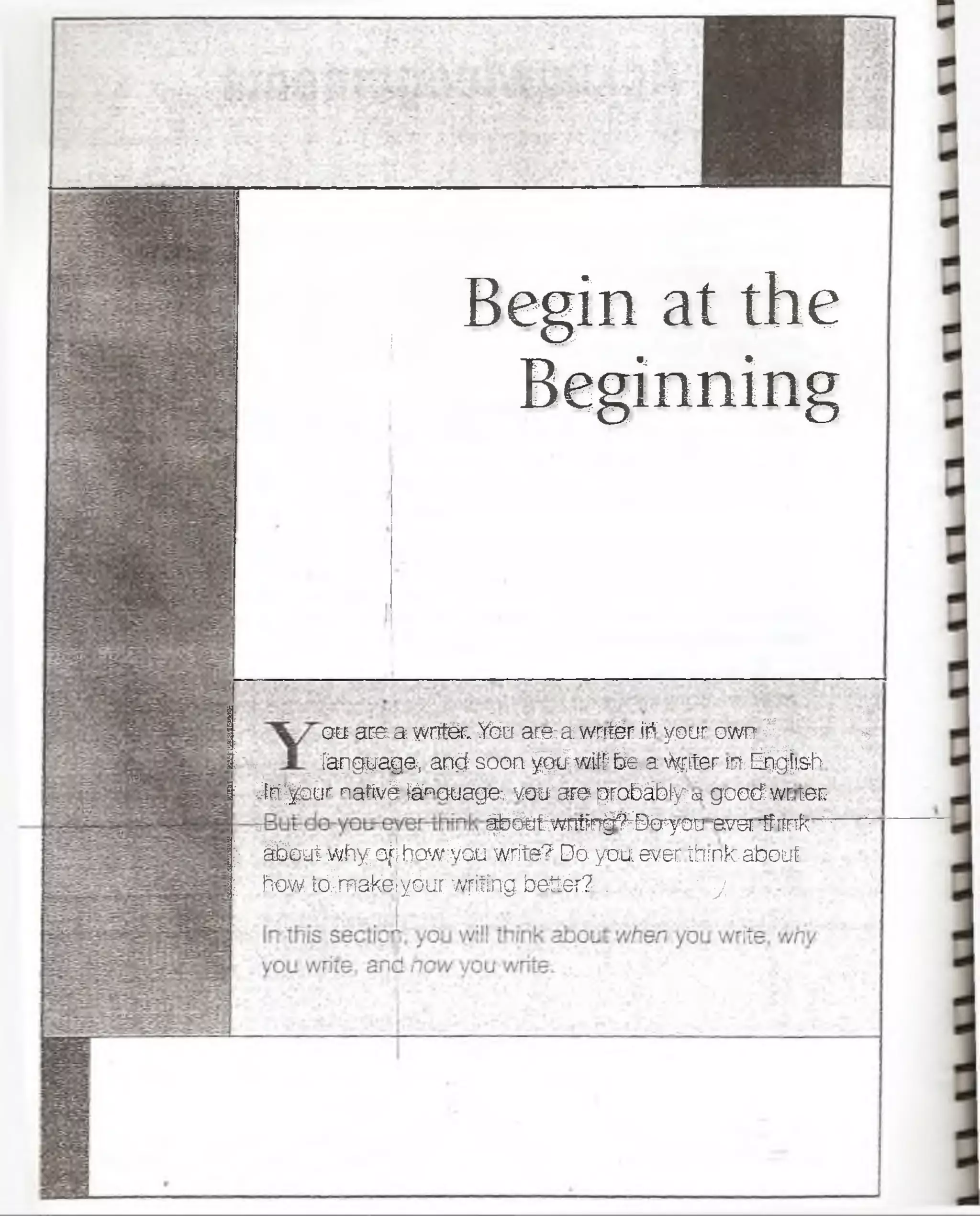
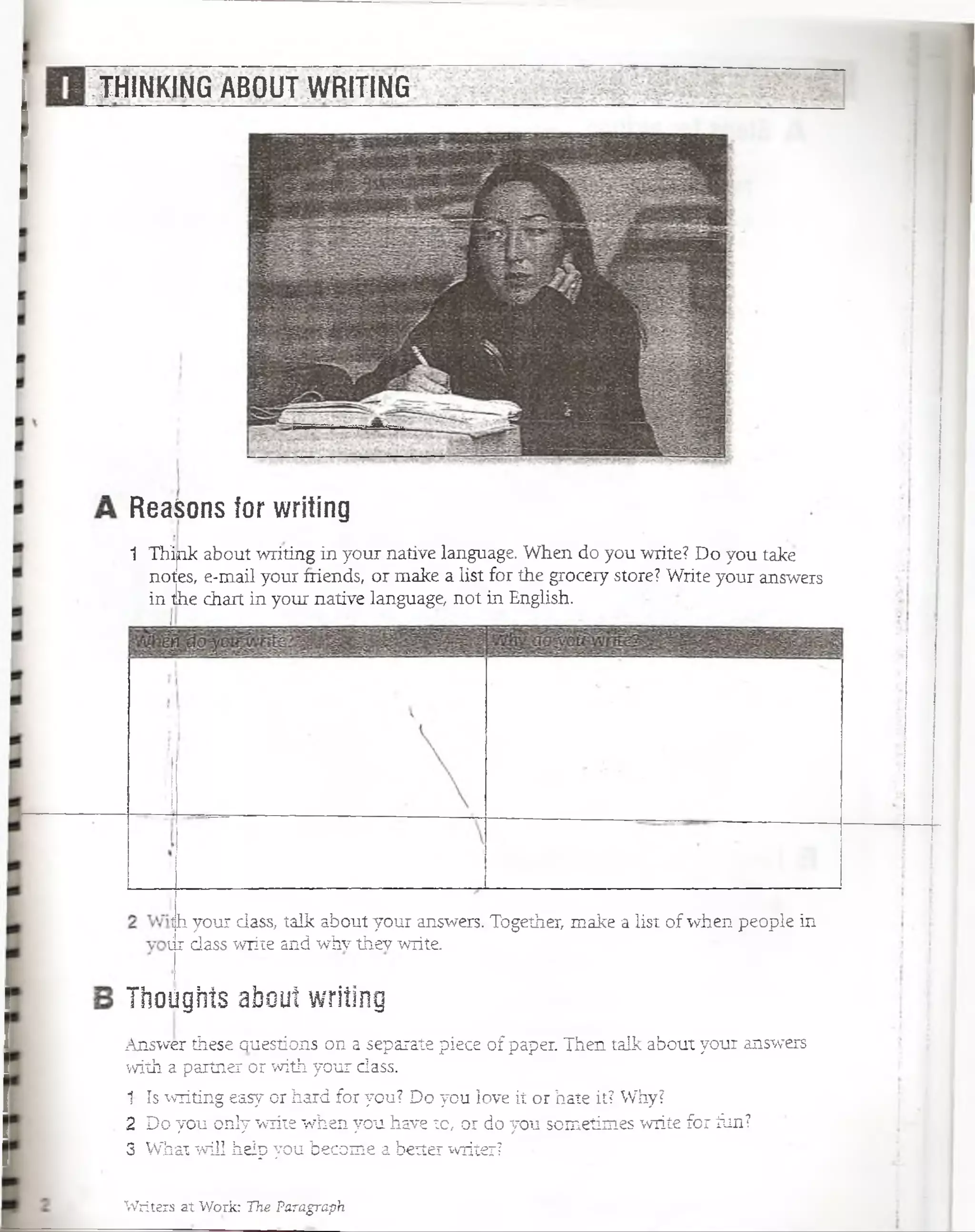
![revise organize]
(check ideas) ideas aiíd
plan writing
Step:.
write
C8SS
edit^check get ideas
grammar)
Answer these questions on a piece of paper. Then talk about your answers with a
partner or with your dass.
1 Do you use any of these s;:eps when you write something for a dass? Which steps
do you use?
2 Good writers do not use tie writing process for eveiy tánd of writing. For example,
if you write a phone message, you do not revise and edit. What other kinds of
writing do not need the writing process? Give several examples.
A Steps for writing
Look at these pictures. They show the steps that good writers use when they write a
paragraph or short composition, but they are not in the correct order. Number the
pictures to show the correct order. 1](https://image.slidesharecdn.com/writersatwork-130924081026-phpapp02/75/Writers-at-work-17-2048.jpg)

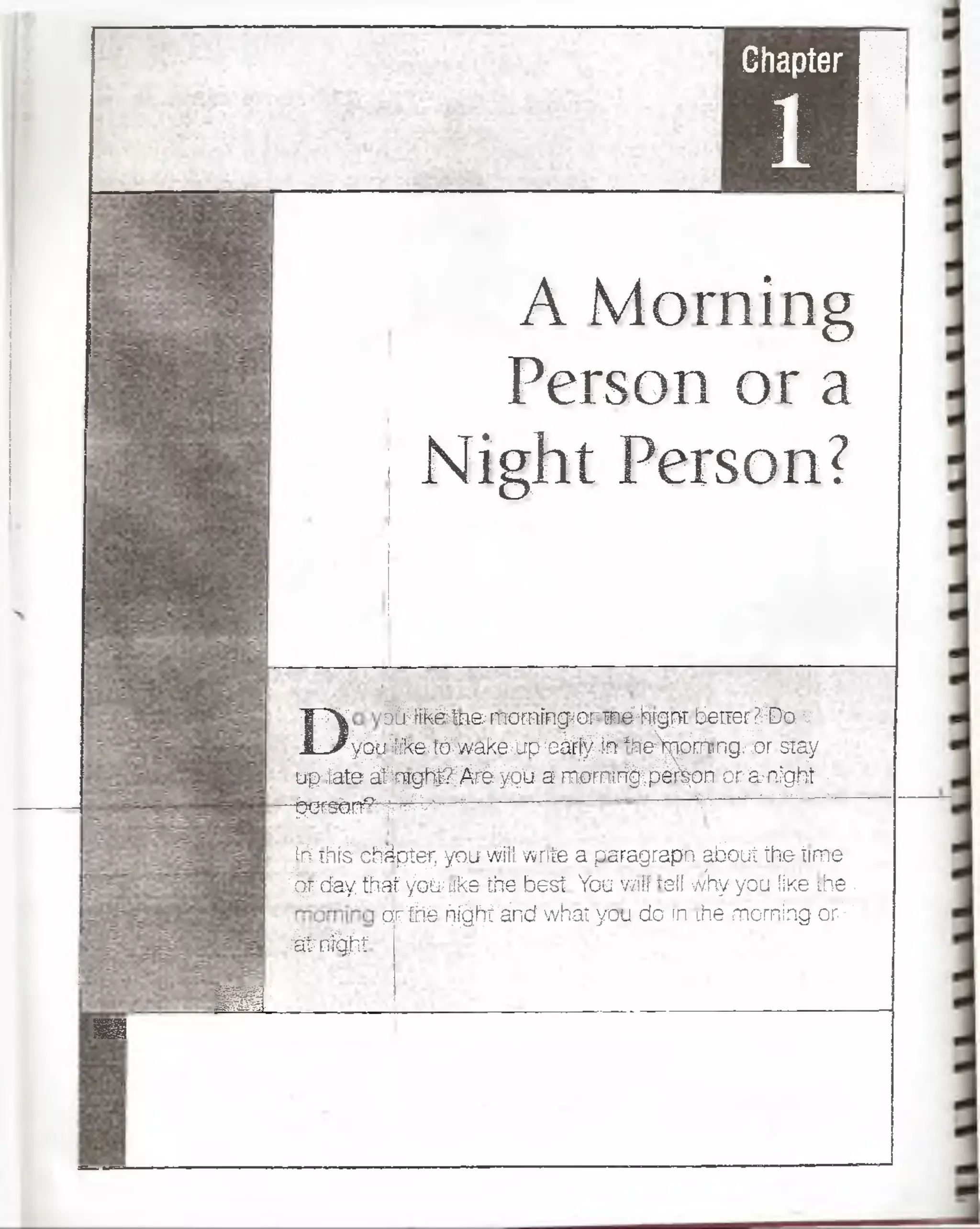

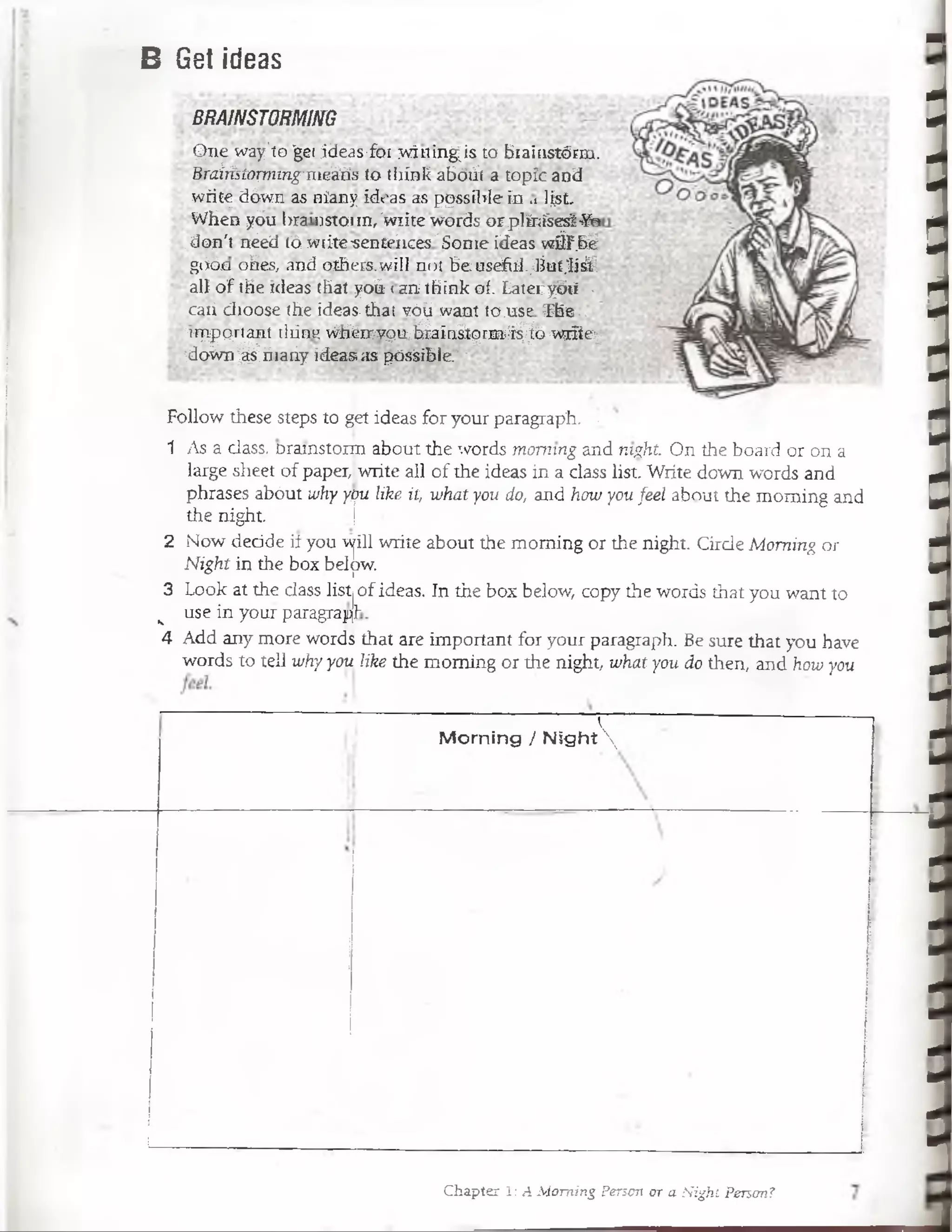
![U PREPARING THE FIRST DRAFT
A Organize your ideas
ORGANIZING IDEAS
Aftex-you brainsiprm /^u^íí; Ea^-jiíany^idéásoiLyourpaper. But you .are not
yoü: need write
rábout &st, seGond/ anci tlurd? V^én yóü thinlc about'and deade th^ethings,
ypu áre organizing yot^ idéas/ ]:j<¿j.
Circle your topic, Moming person or Night person. Then use the chart to heip you
¡ organize your ideas. Write yoür words from the box ón page 1 into the difíerent
i categories. You can add more ideas.
Morning person / Night person
^ W £ * I * f S
V
V,
■-------- :---
V
Plan your writing
THEMAIN IDEA
In English/ each paragraph shouid be about only one main idea. The mam idea
is what the paragraph is about All of the sentences in the paragraph shouid
be about the main ideaL'Jfaseñférice is"abóüí- themain idea,; it is' a relevant
sentence: Relevant means related to or about the main idea. If a sentence is not
about the main idea, the sentence. is.inelevani;(not relevant).. You shouid always.
take íiielevant sentences. but of your paragraph. •
Writers at Work: The Paragraph](https://image.slidesharecdn.com/writersatwork-130924081026-phpapp02/75/Writers-at-work-22-2048.jpg)



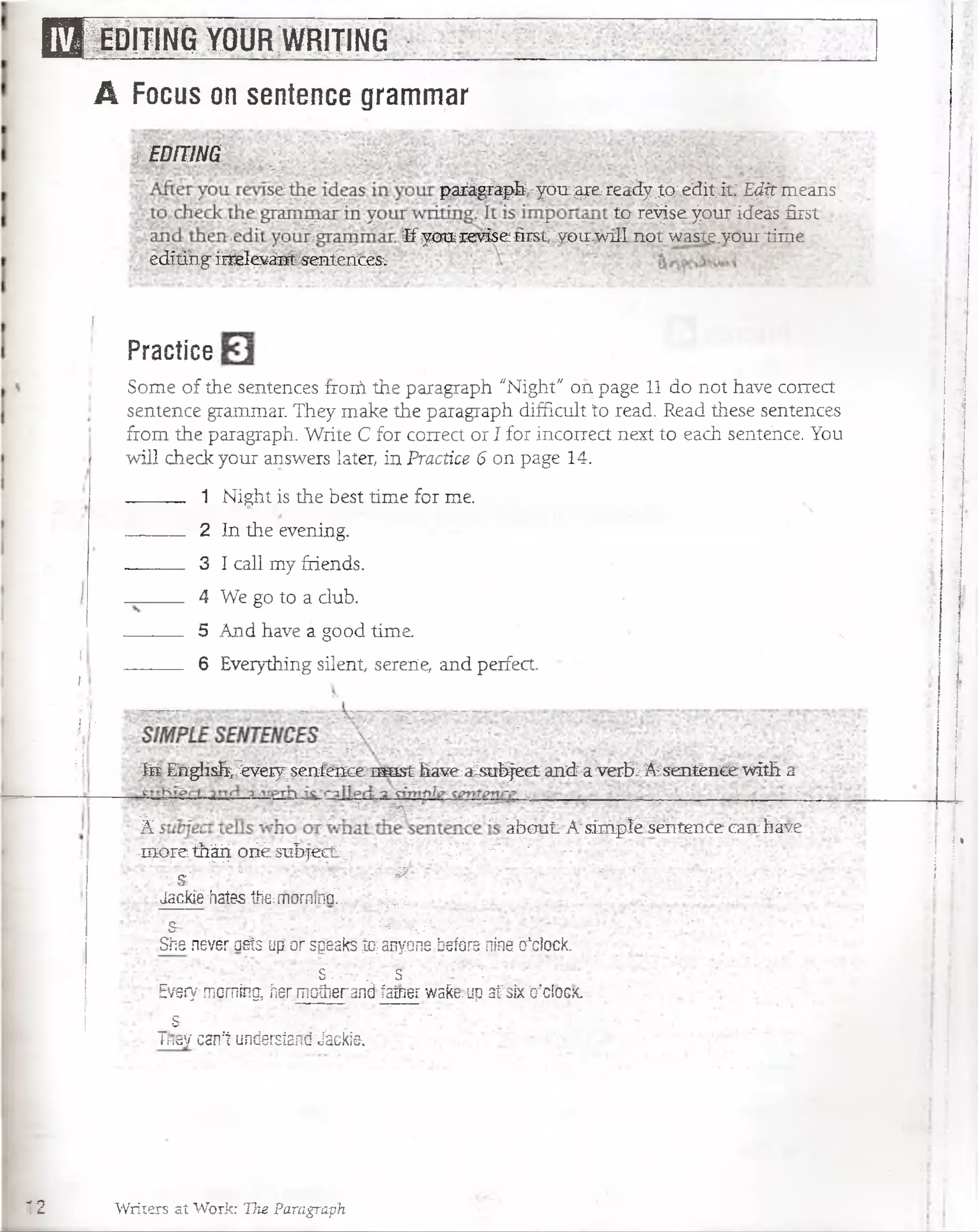



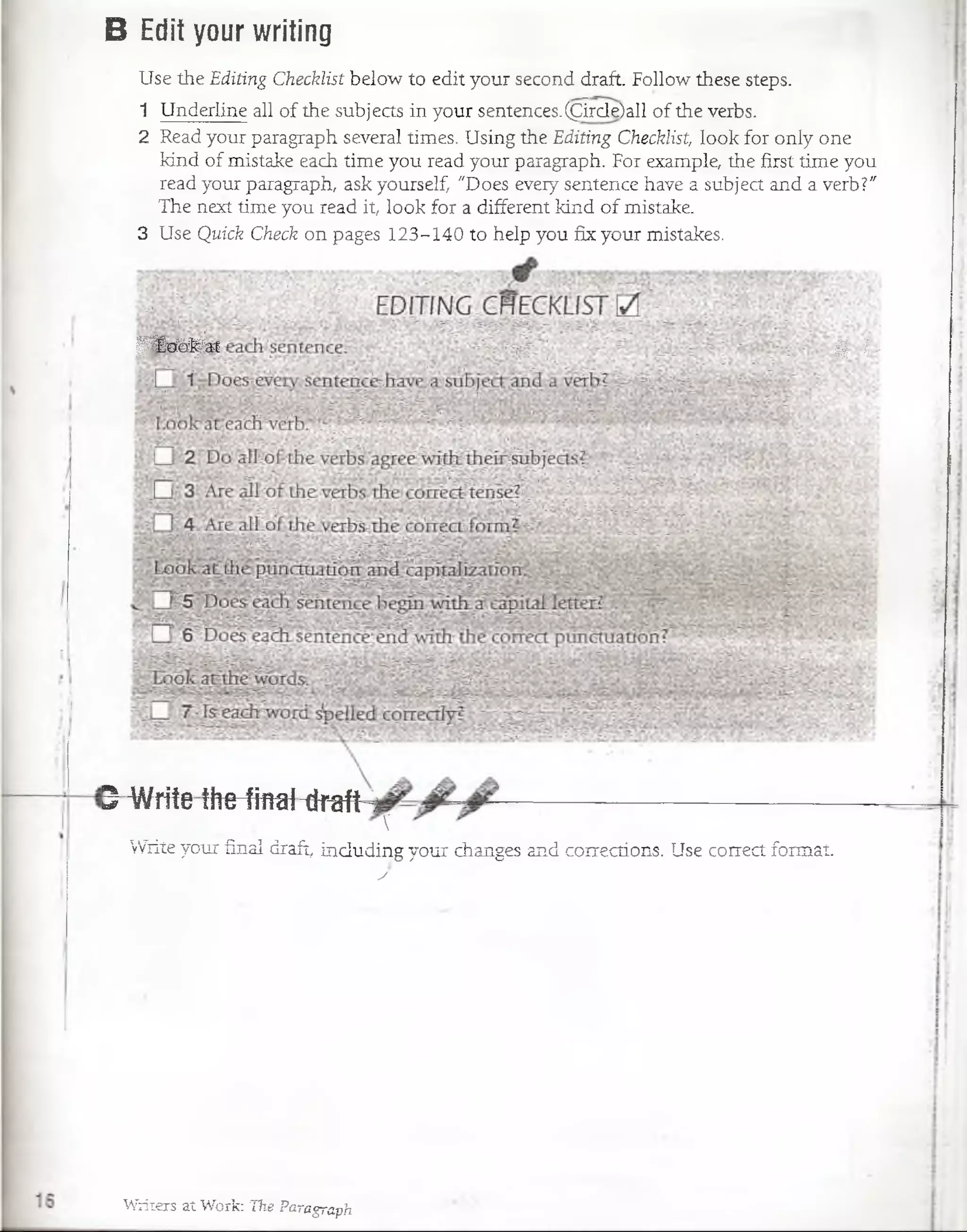
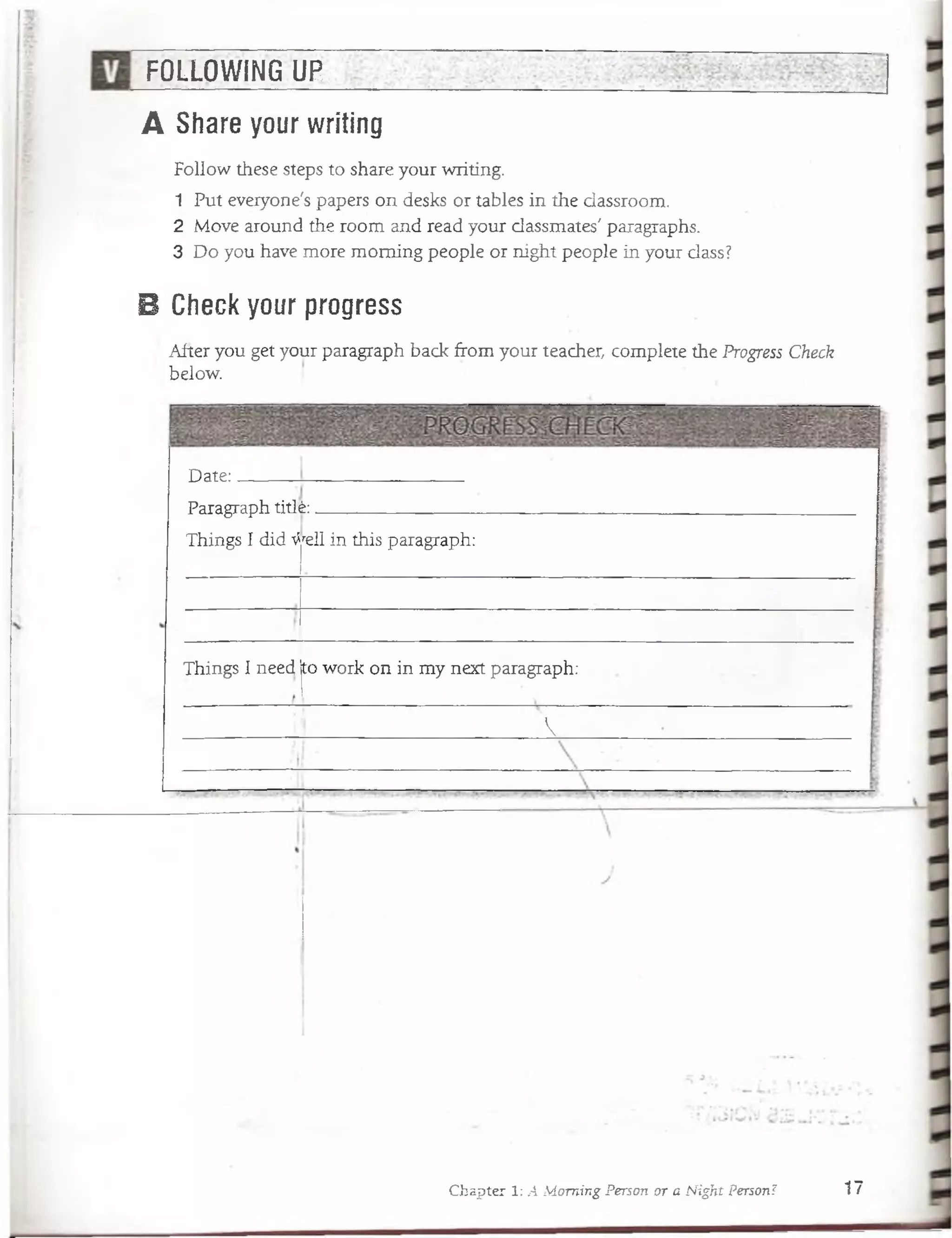
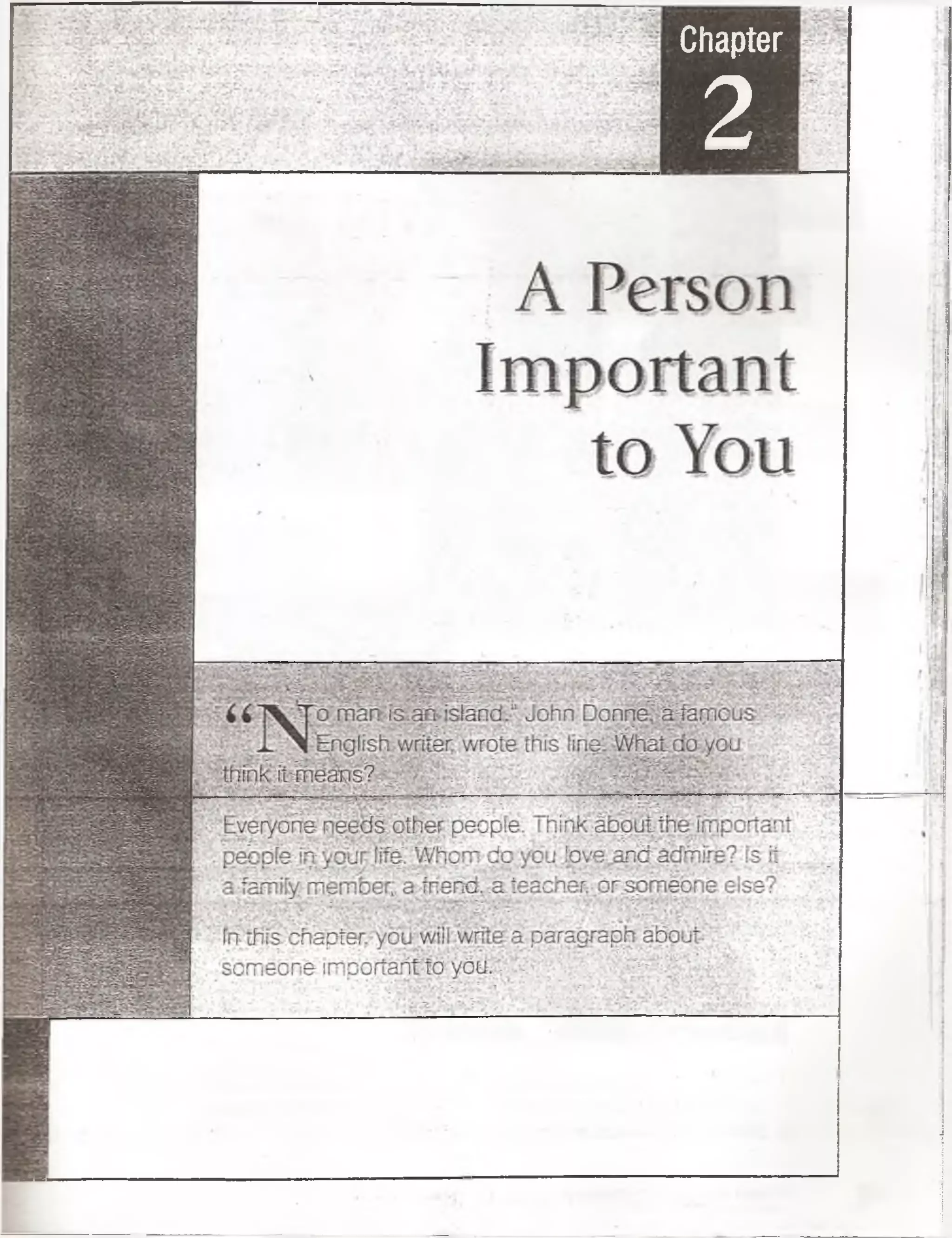


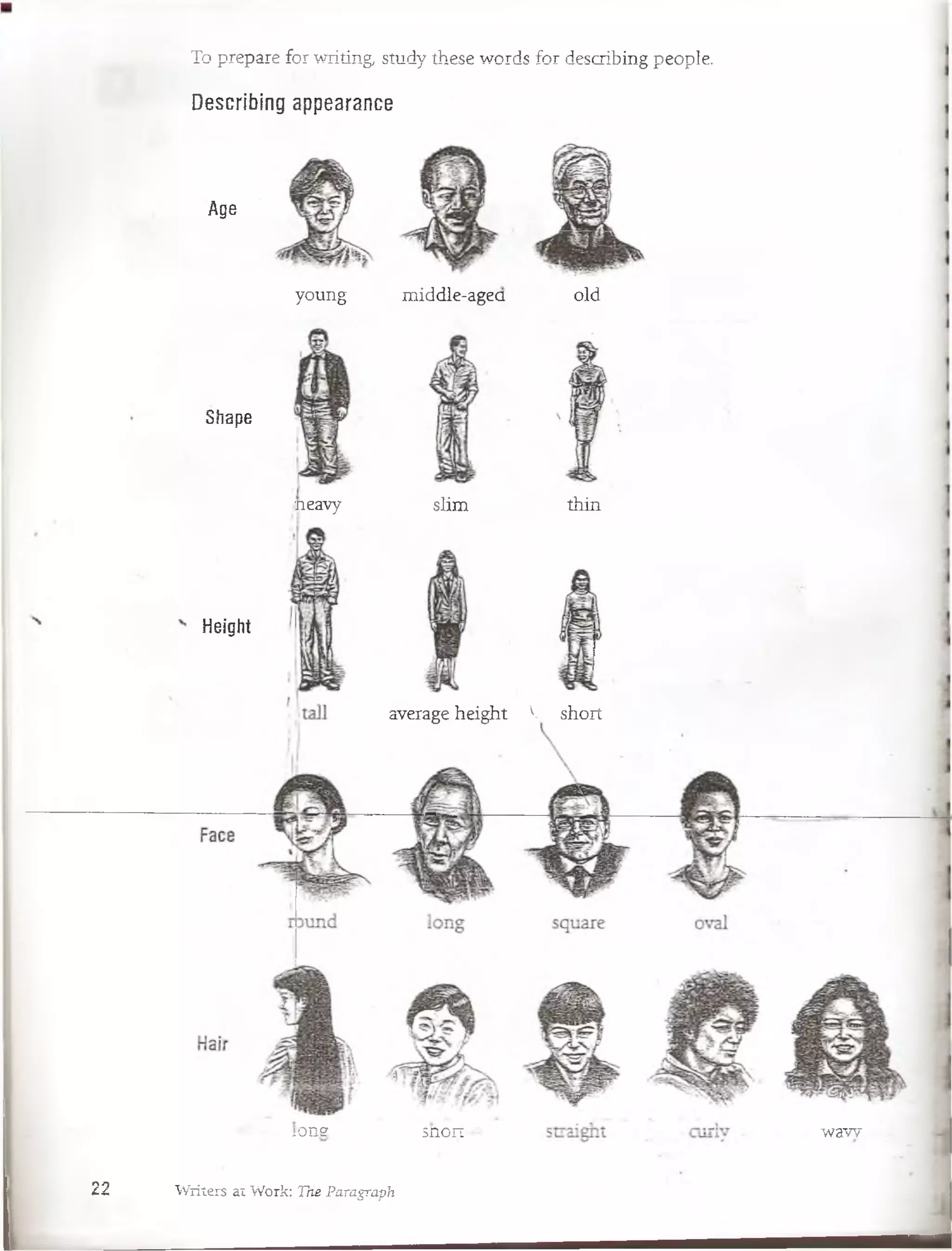
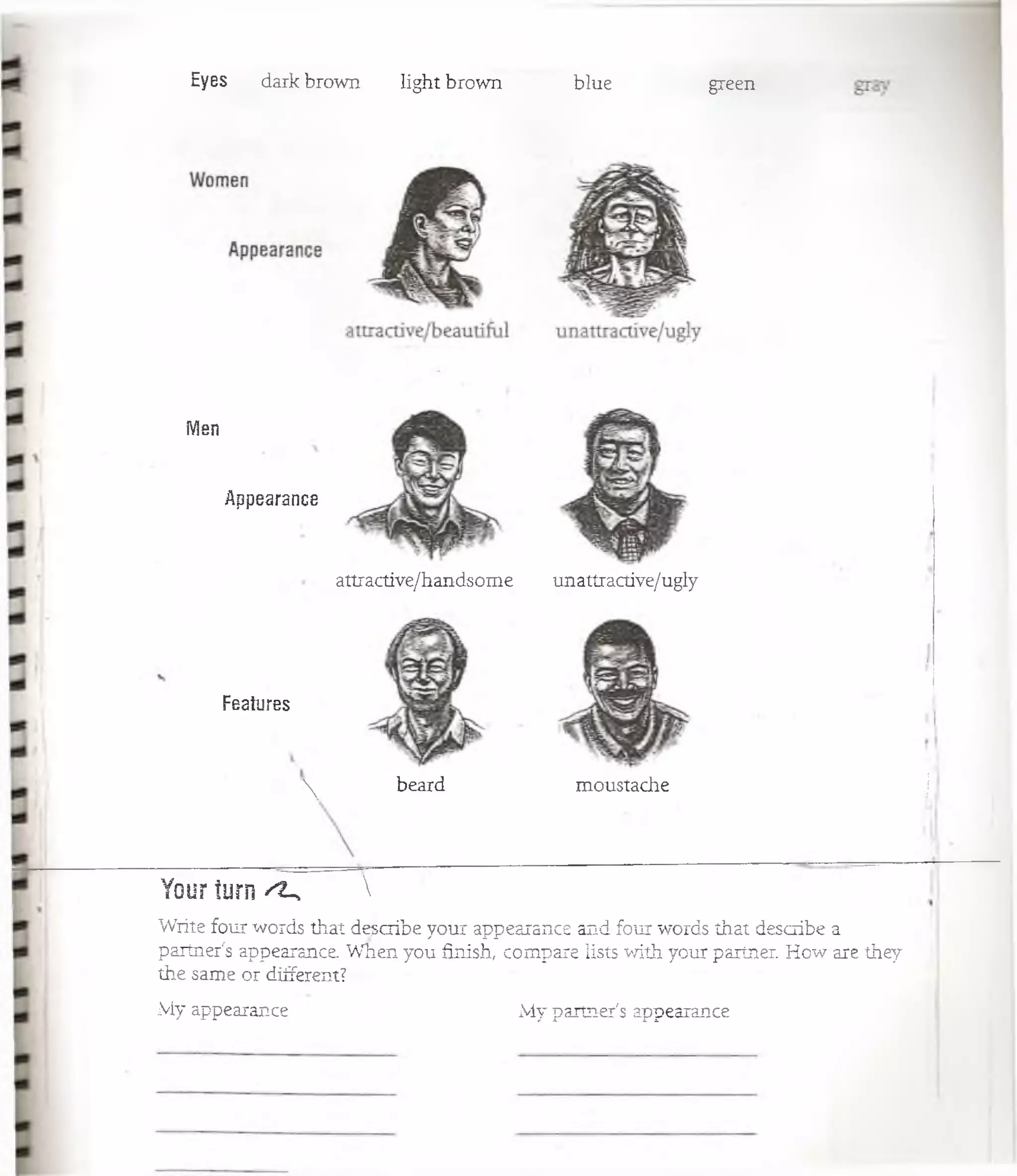

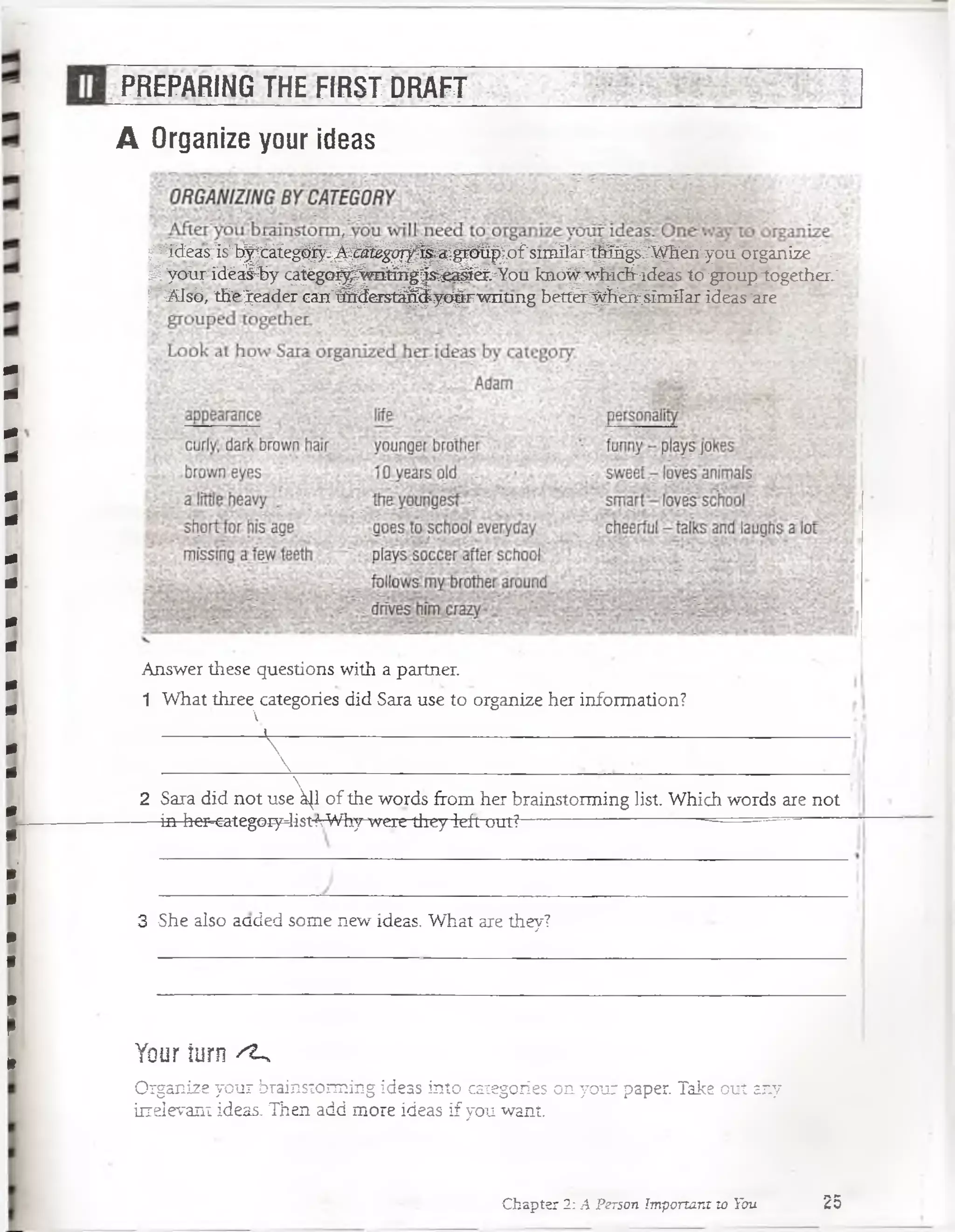

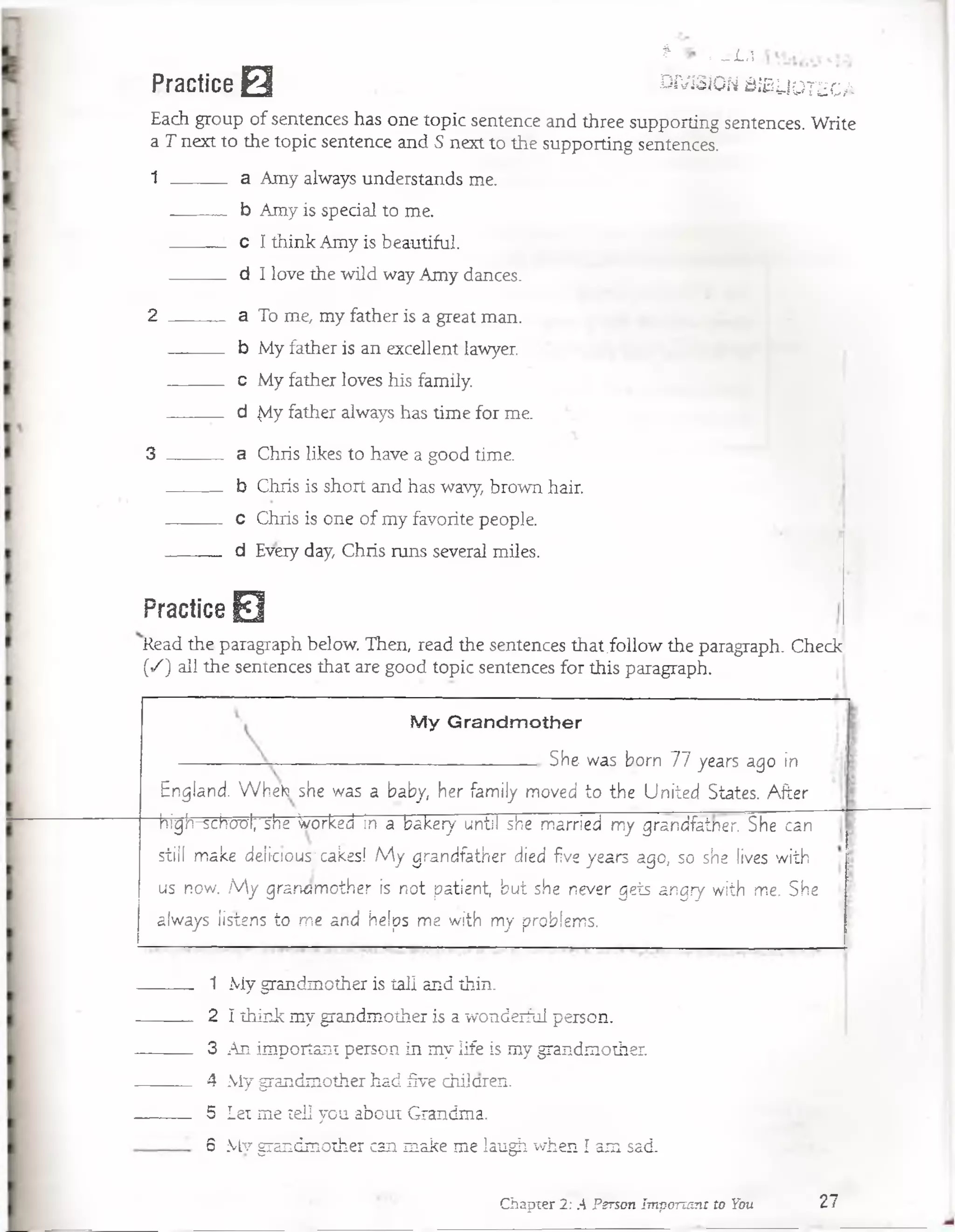
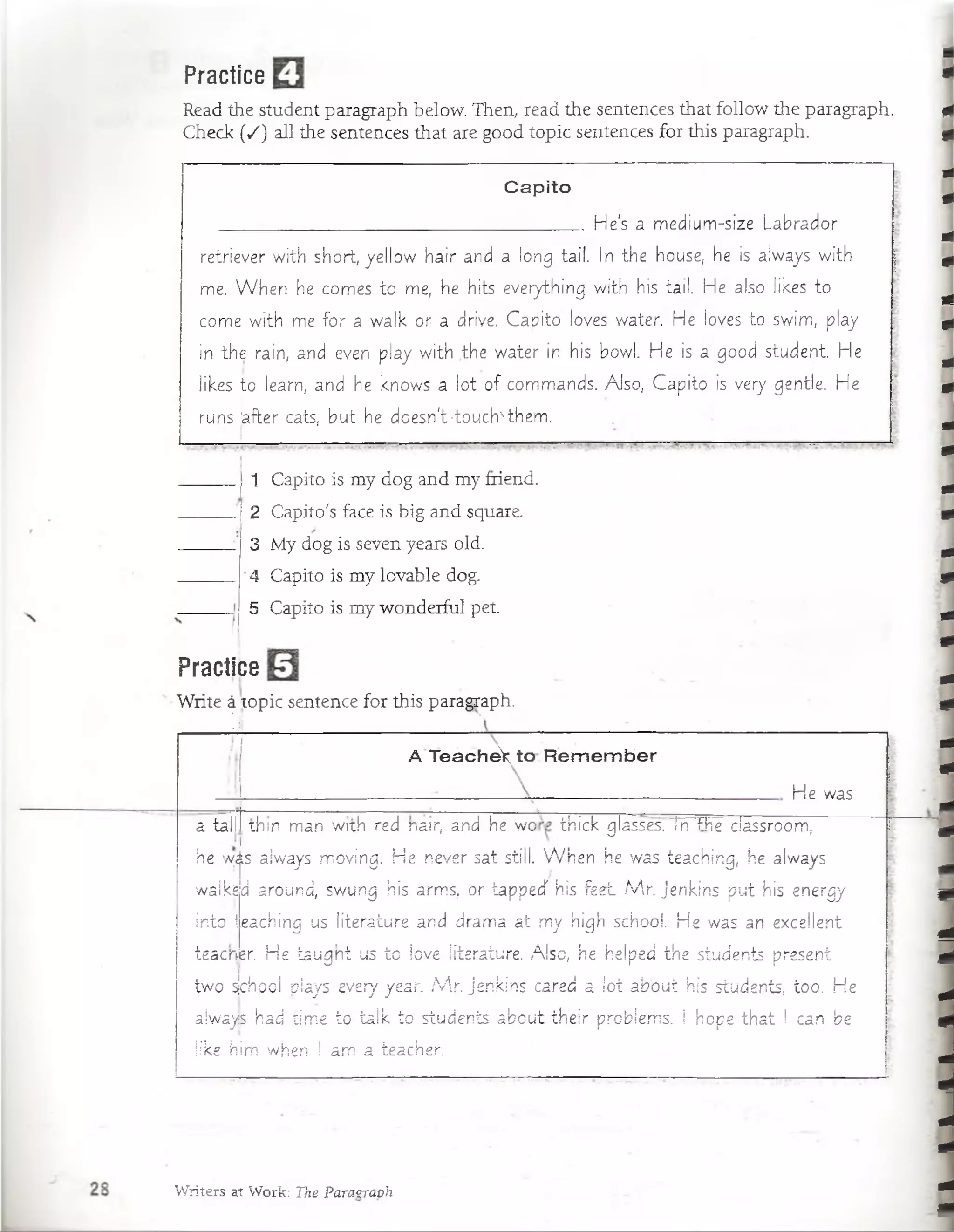
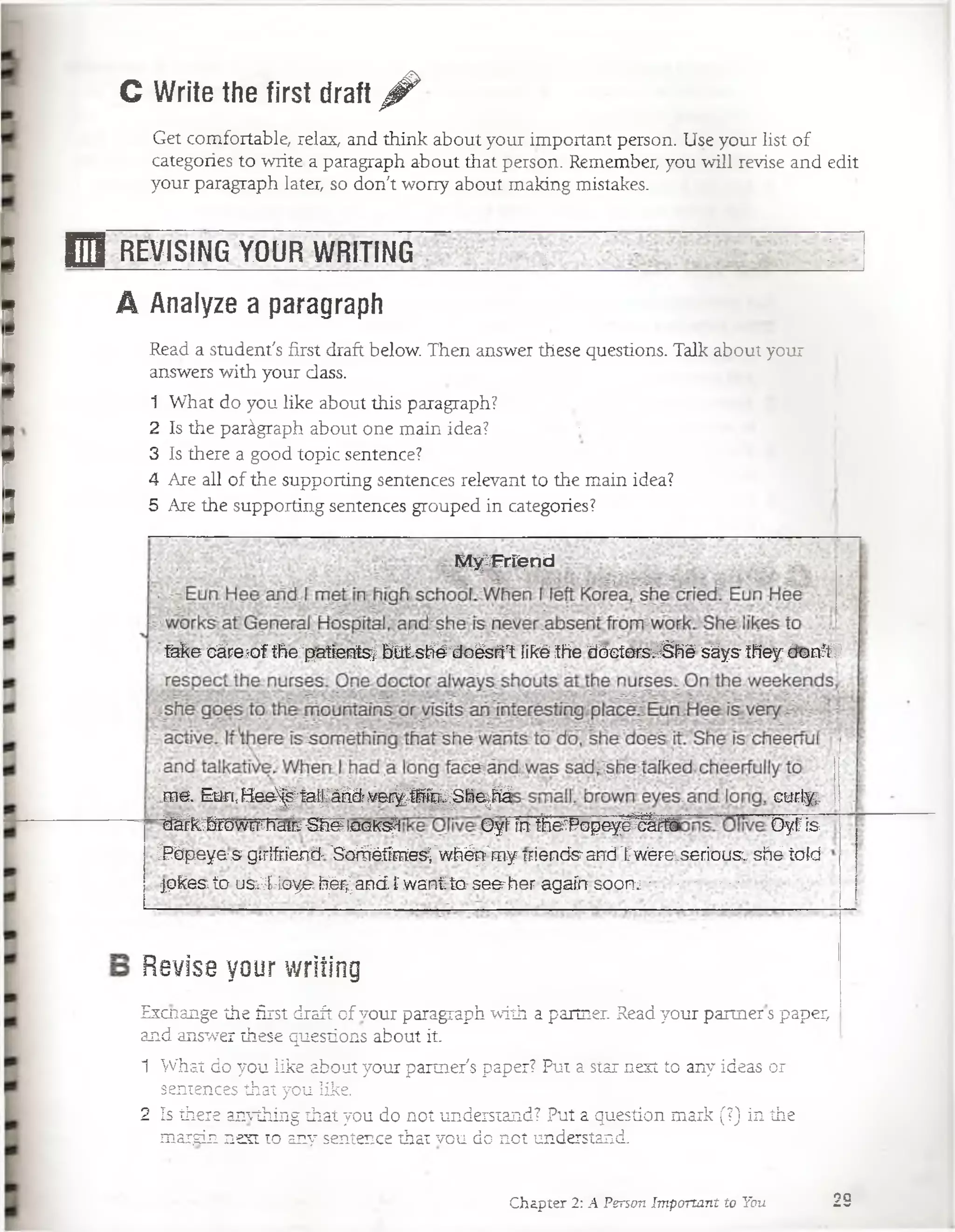




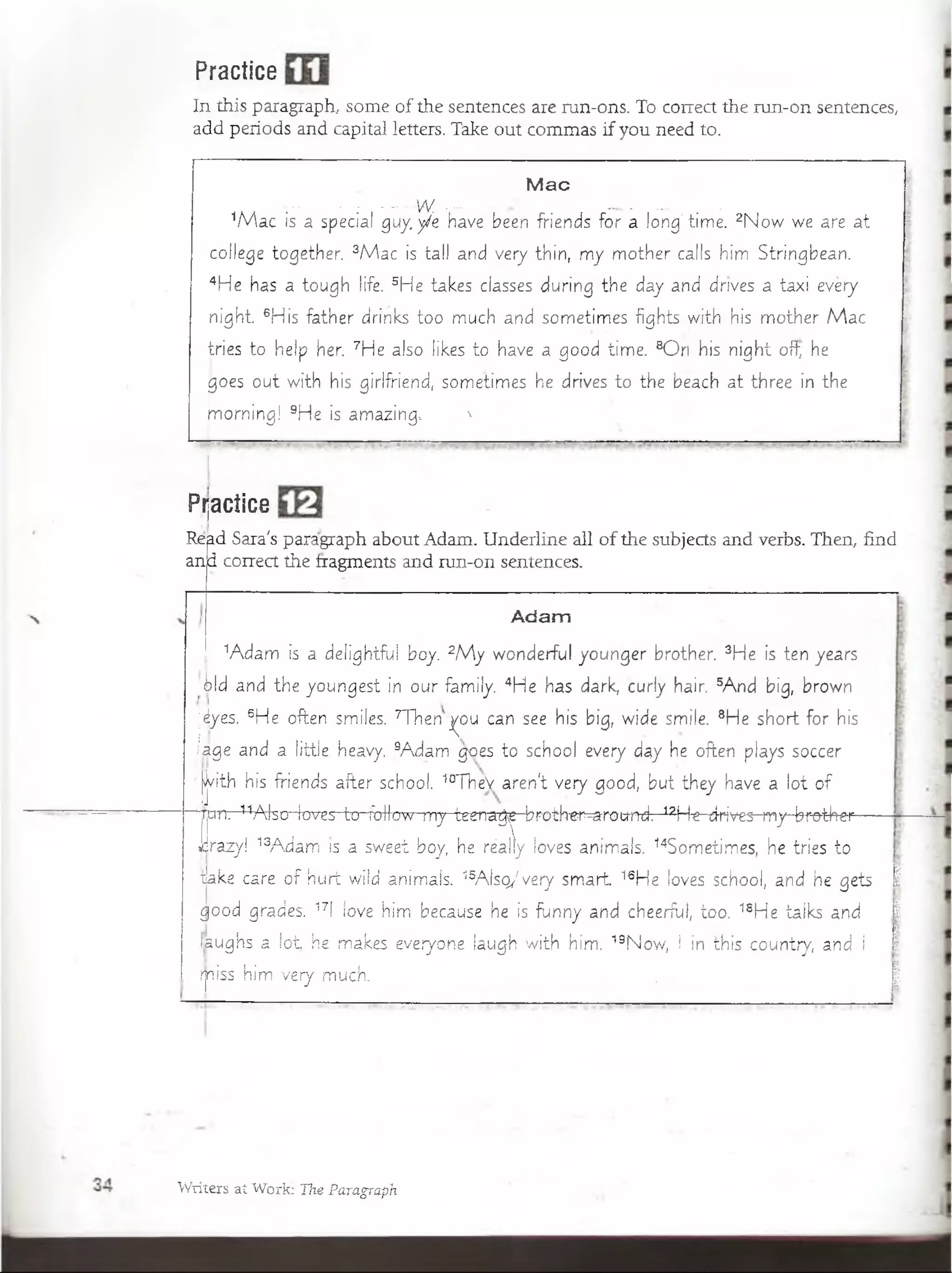
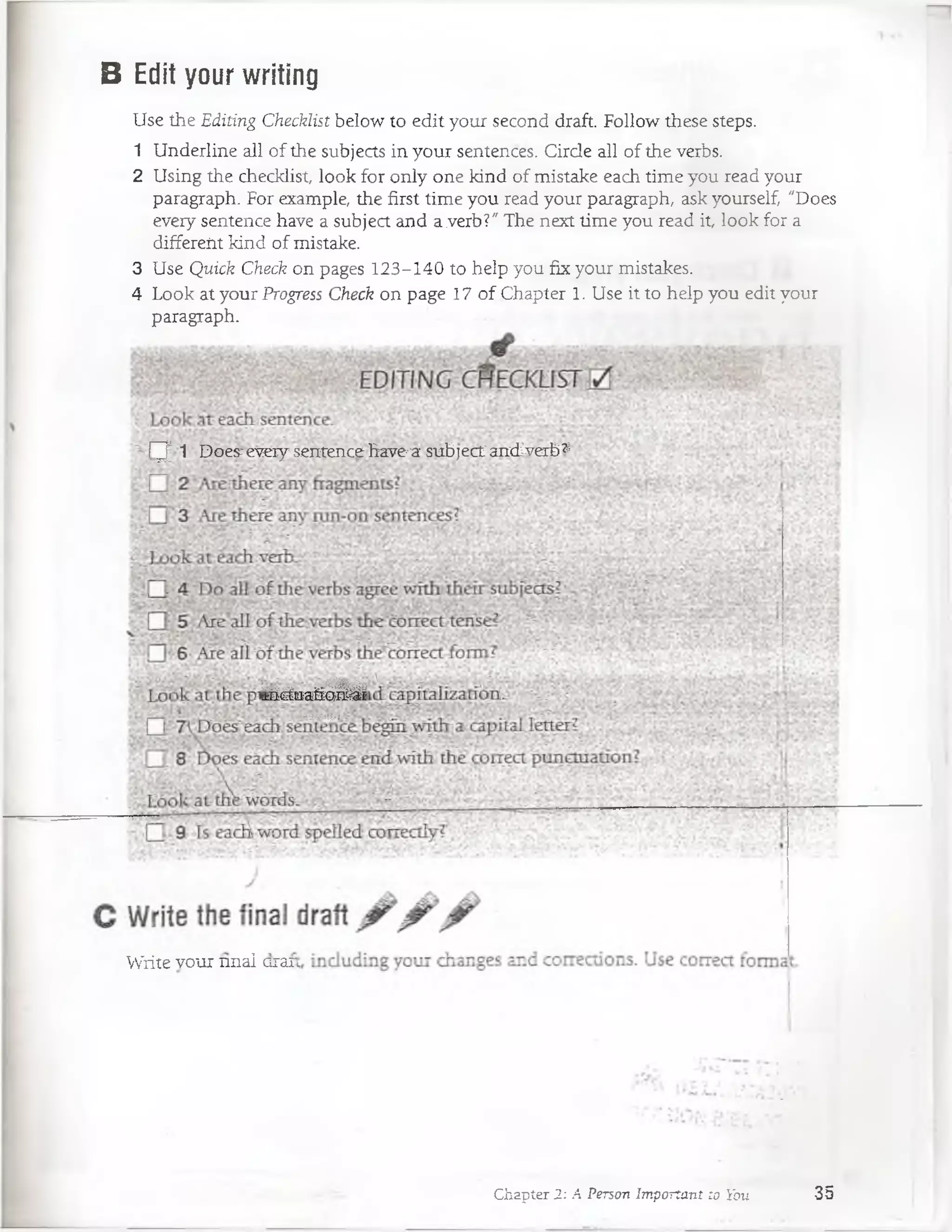

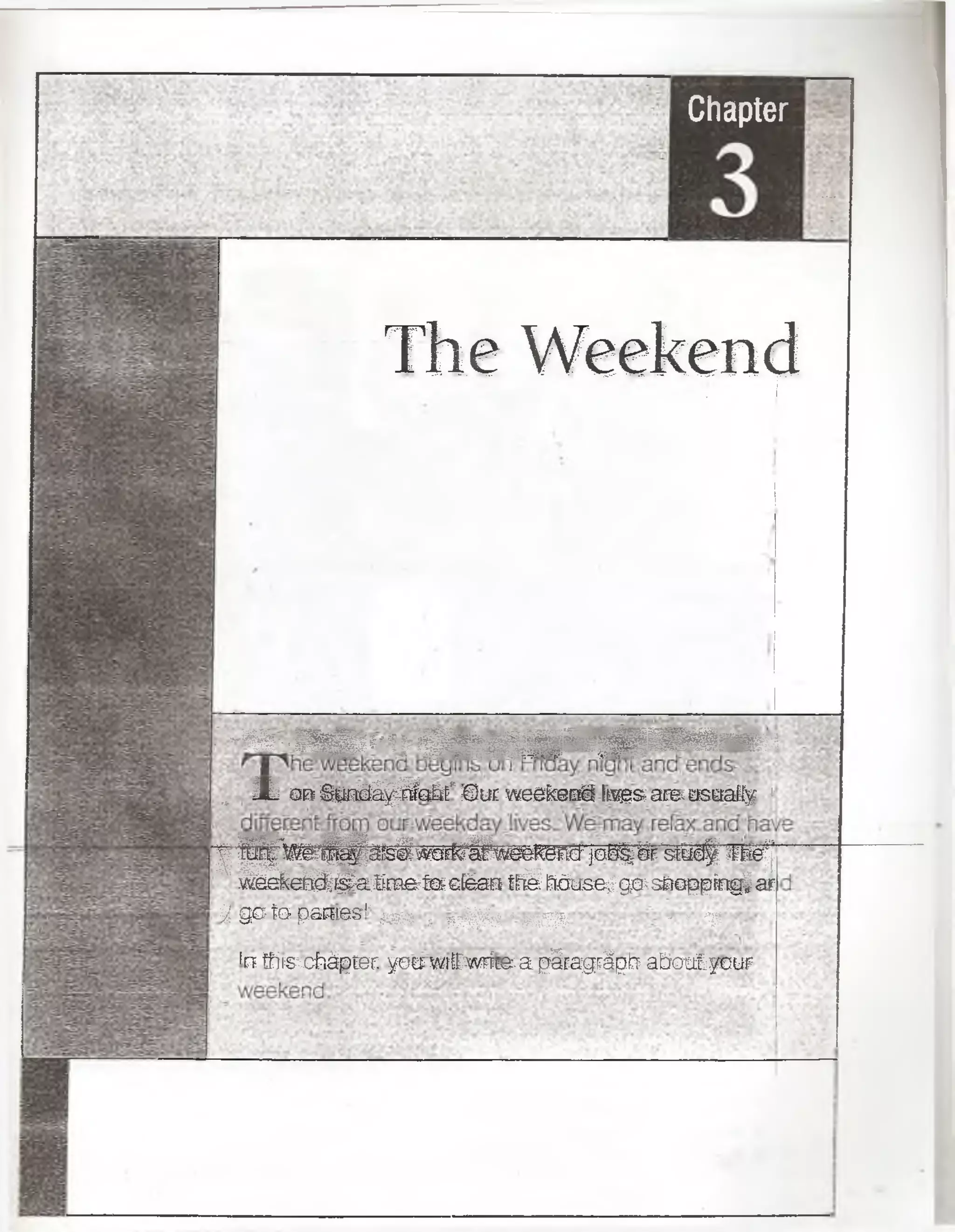
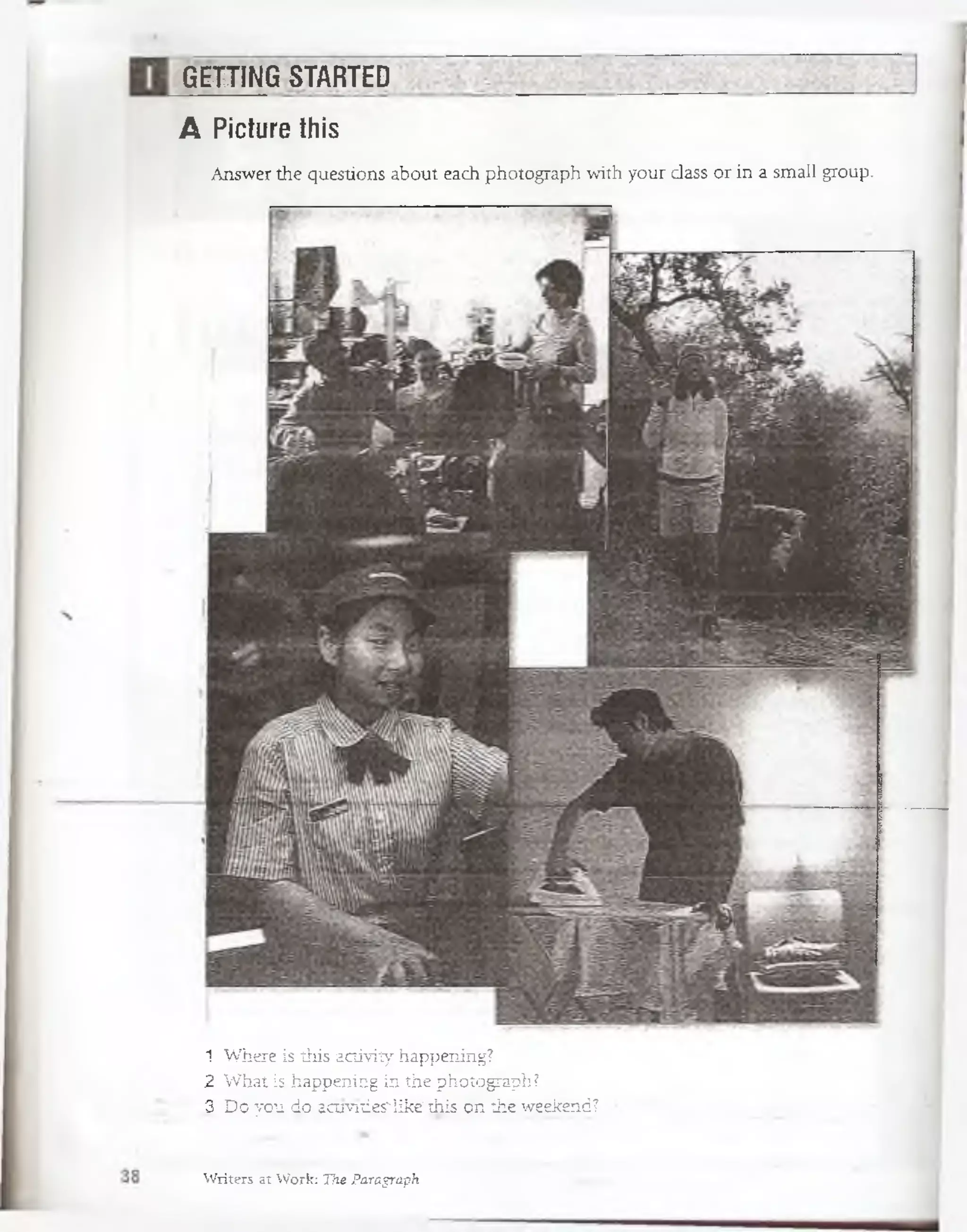
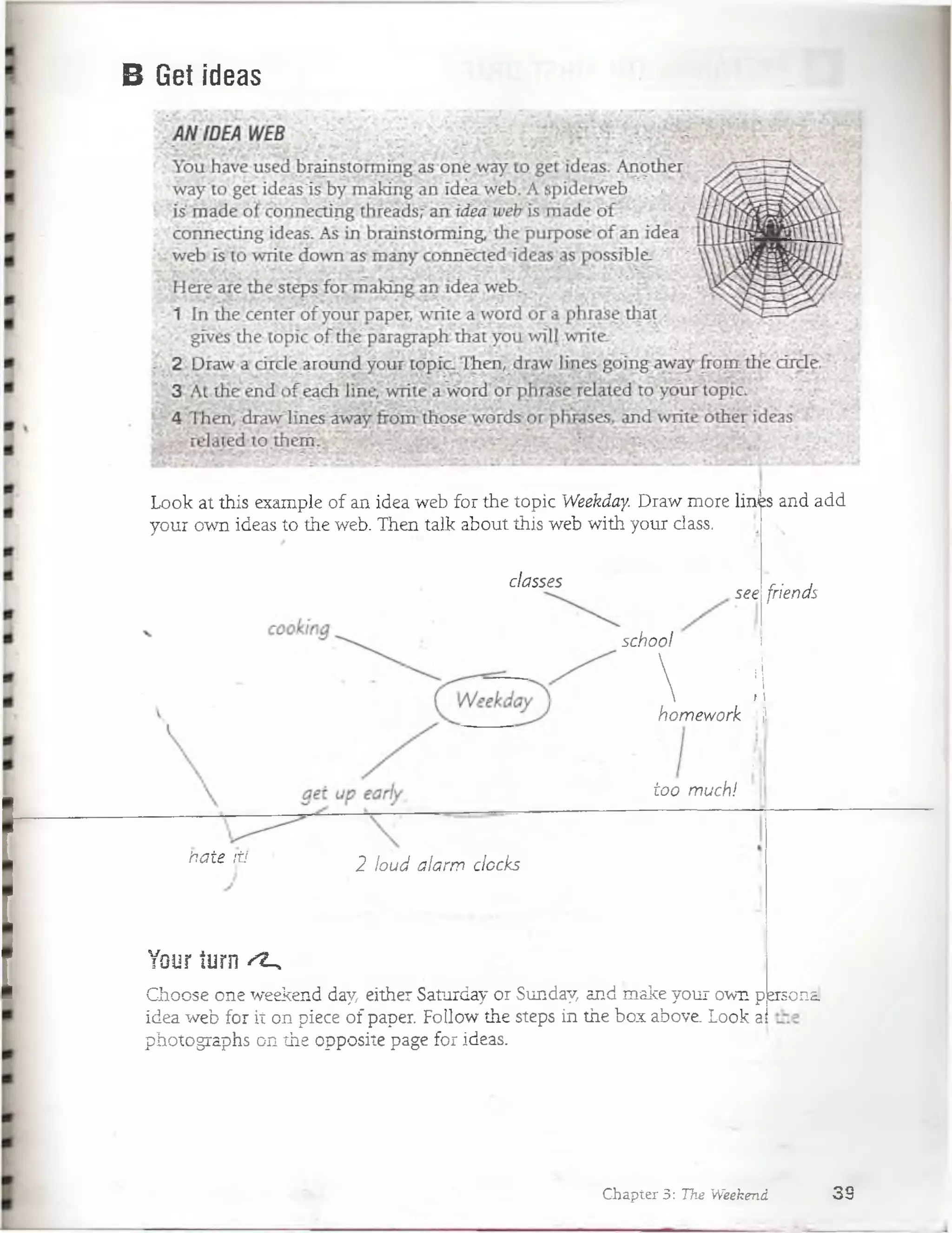
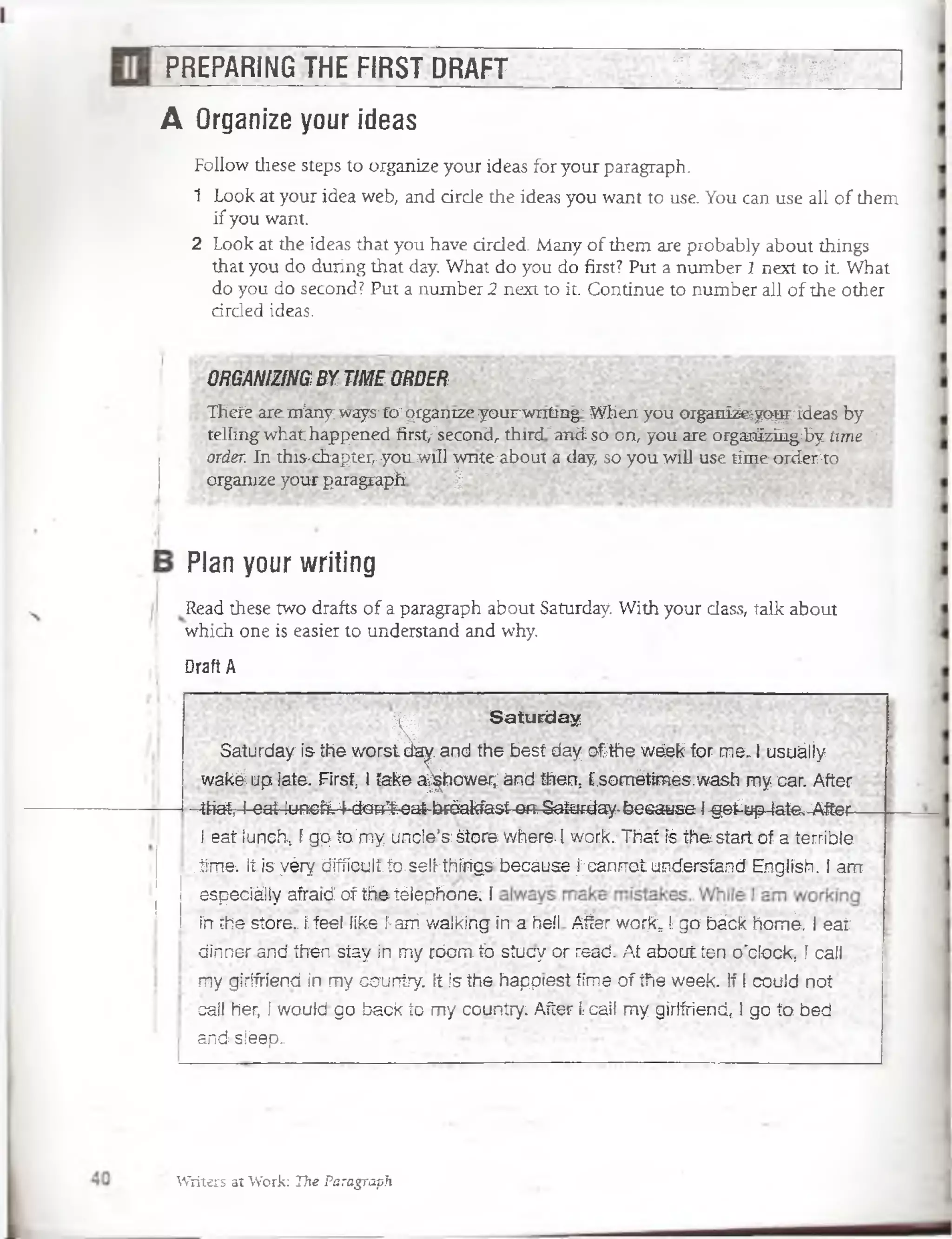
![Draft B
Saturday
' of the week for me. í usually;
wáke üp wash my car. f eat lunch. I ; ;
:d ó ñ 't eat breákfasí¡op; Saturday béeaüsé 1’g e t up laté: I go to m y uhcfé’s storej
is very difiicult to sell things
becáüse I eañnot bndérstánd English.-1 am éspeciáíly afraid of the téíephpne. f
afvvays make mistákes^^Vhilé I arn wprRing in the store, I feei like f am walking
fny^room to study or
T^adyL.ealí rnyygjr{frtécicí in.my country. it i^ the happfest time of the .week. If I
£pü£d-;nÓi: eall tóy.j% outd g a b aé k'ía m yfe^ n try . i. go to- bed and-siéép^
TRANSITIONS
When you write your paragraph, you need 1o use words to tellthe readerwhat
you. do- first. secondr4and¿ó;3on- Most.wnr.ei-s; use,words -called transilions to telí
the"ordér that soniethfng happénéd,in, Tfansitipn meánsl"¿hanget=ándjweluse' •:
ttansitipns;.ta^how,a-timechañge;fntR^j^rágfapfí
Theseword'srand pircases ar^transitipns'C §|
J¡¡ i iiílfefOGming^'|
r^jB tte afterjioaa|
tfrén: % _ j
afteríhati;;C
íátér' | atiW Q’ciock <
finally §| / ;.atpdhigti^ y
^^otÍGe,üiaMhe-®Rs-ÍTk)n--i-]Sí:ia}]y-coíT3es--airt]ie-begmRÍ^g ofa-^enTence^and-ií
fo llo w e d by a com rna. ' -. ' . f Jf£ : " - /: "í . ; ' . 5 i |
Affert&a^ir’s'atlUhcfe^
-. :;--tran^oort'^ •• v
I Alten o'cioc^j caii-my girifrientíírr my:-cotmífy.g■
transflor!
Chapter 3: The Weekend](https://image.slidesharecdn.com/writersatwork-130924081026-phpapp02/75/Writers-at-work-54-2048.jpg)
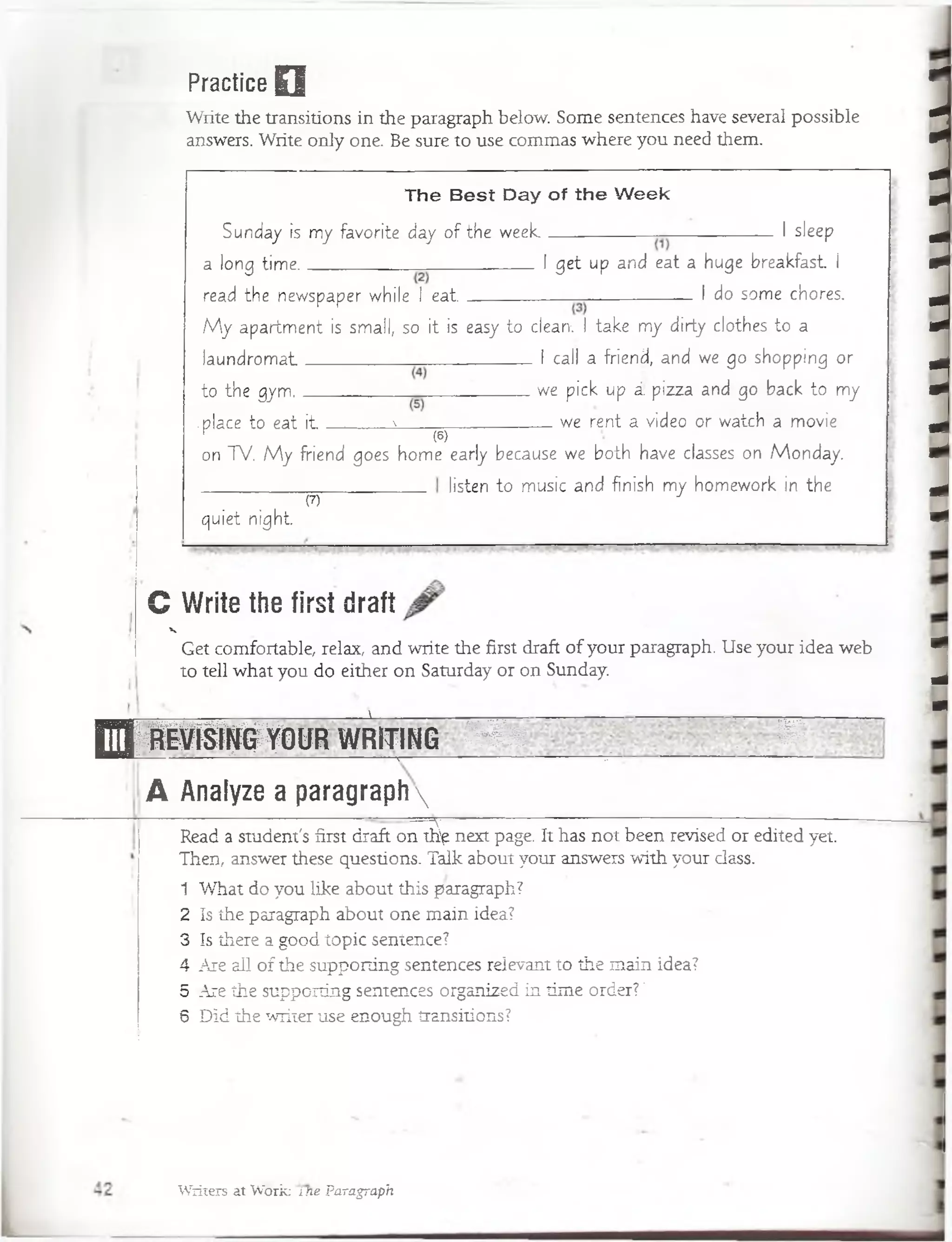

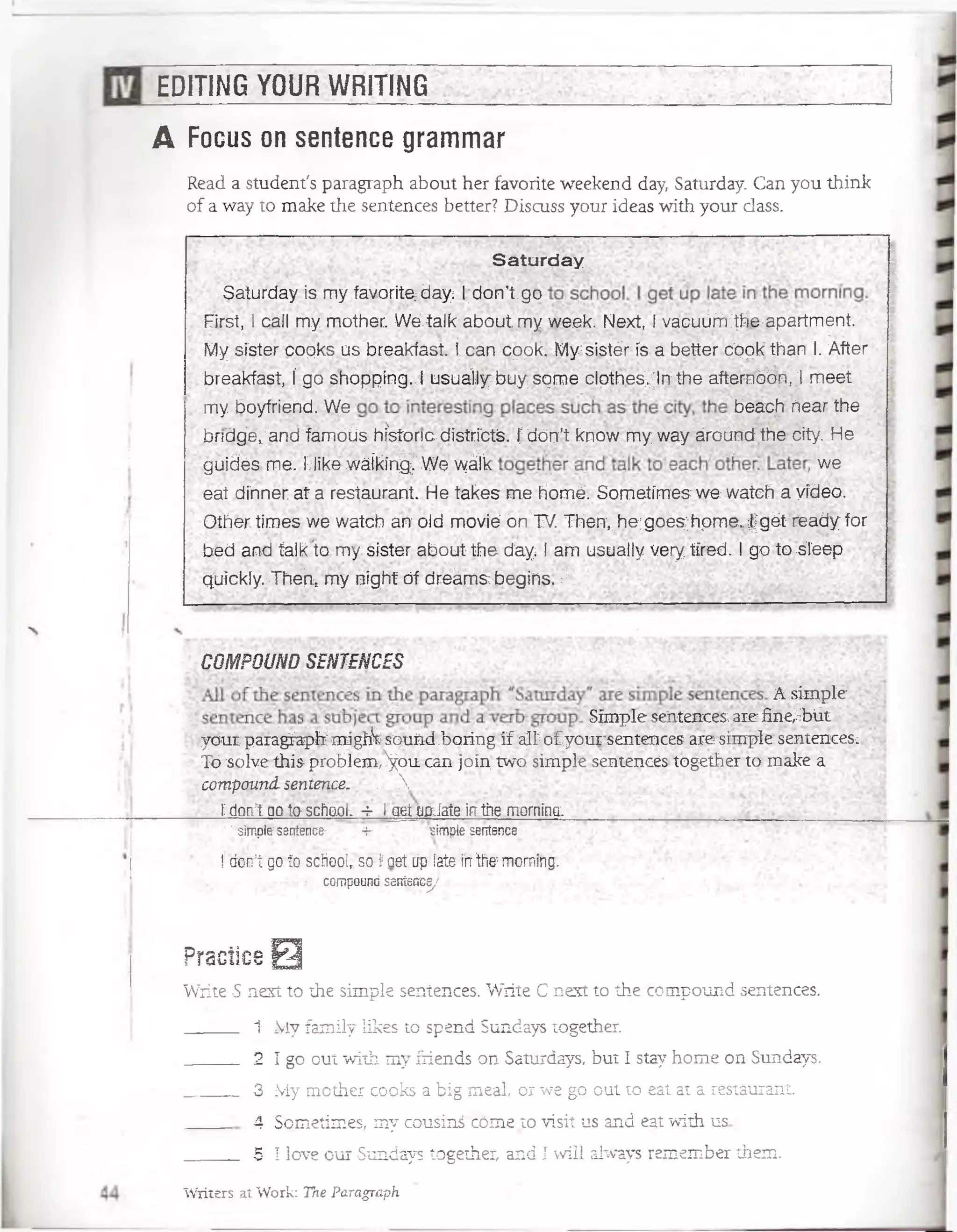


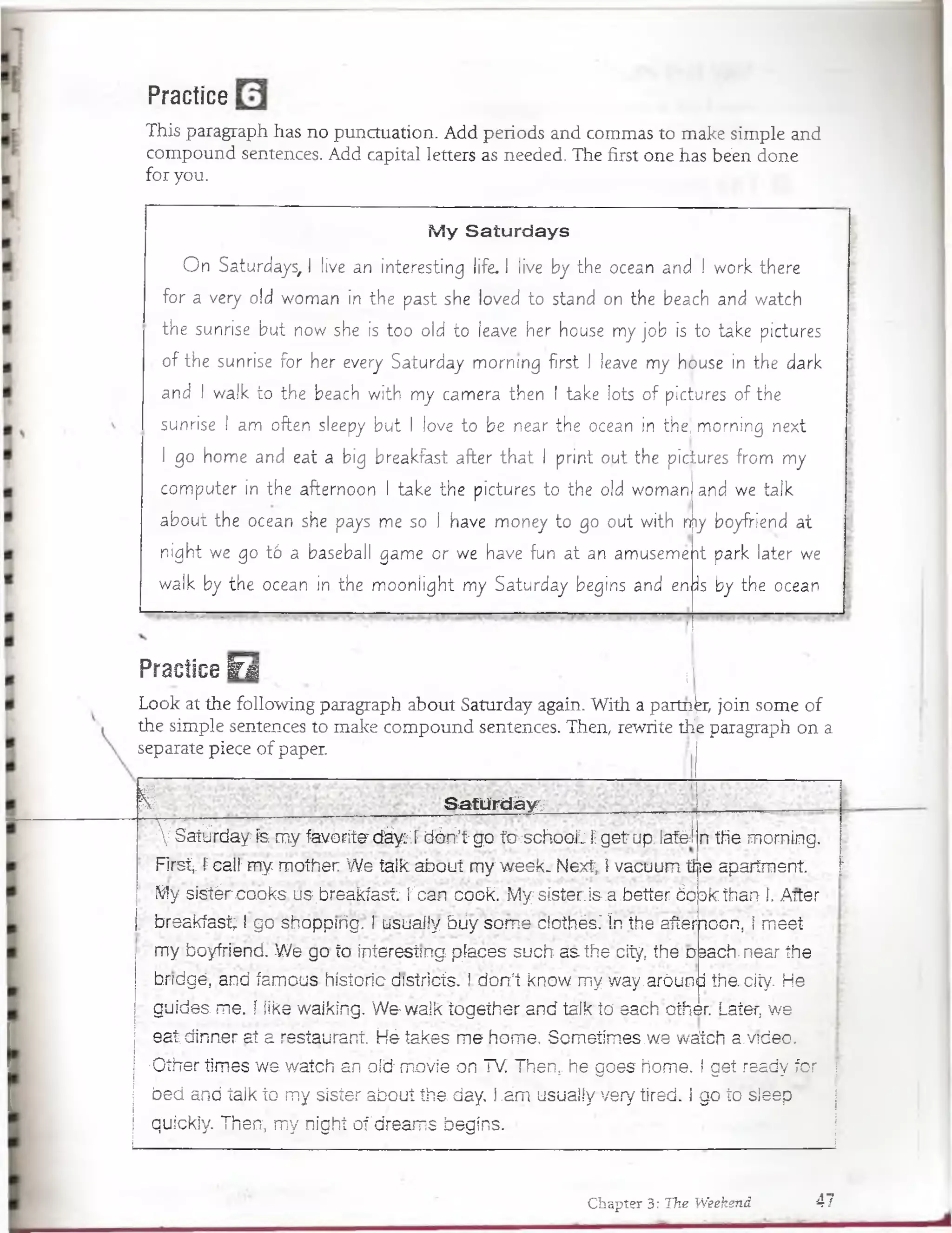
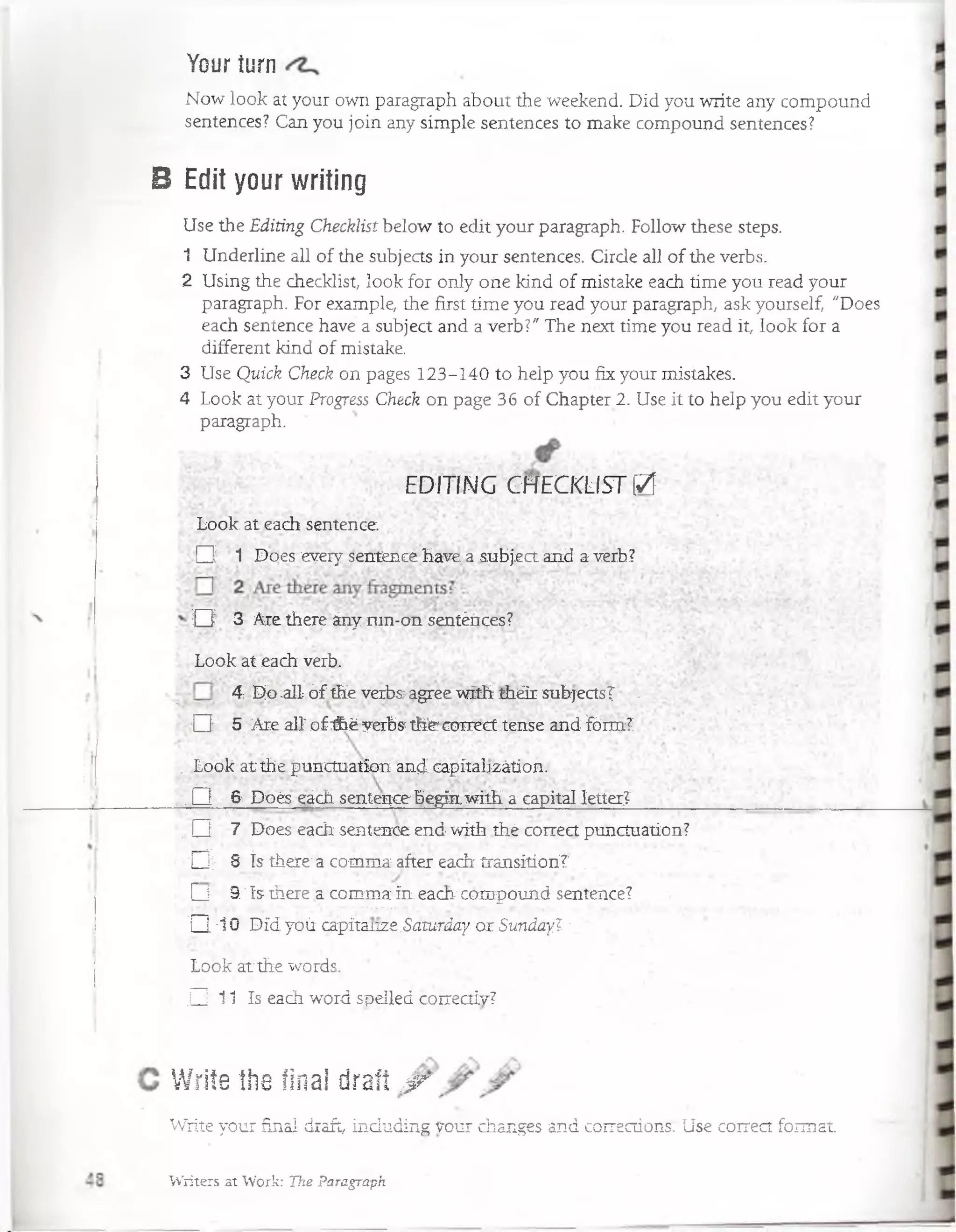

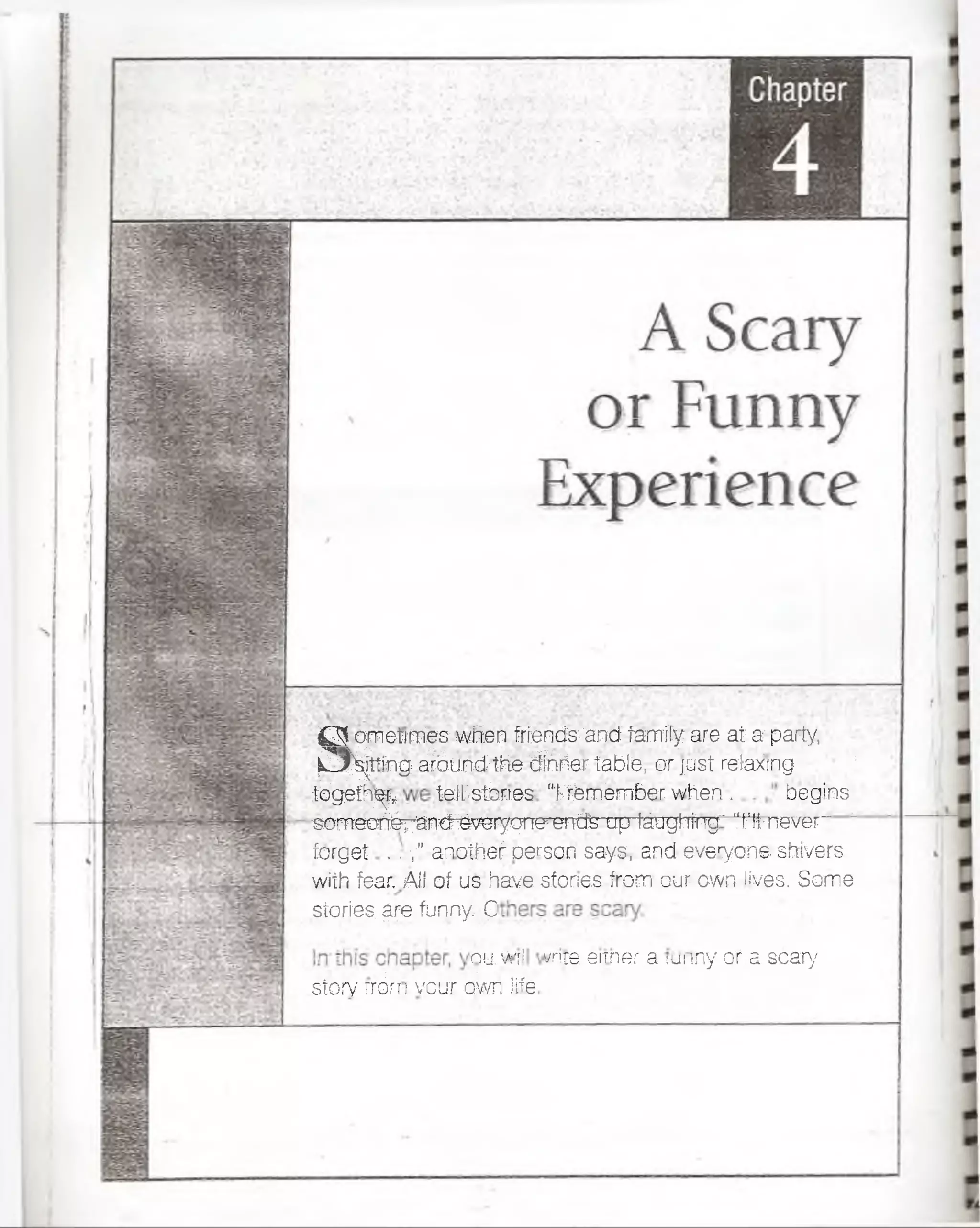


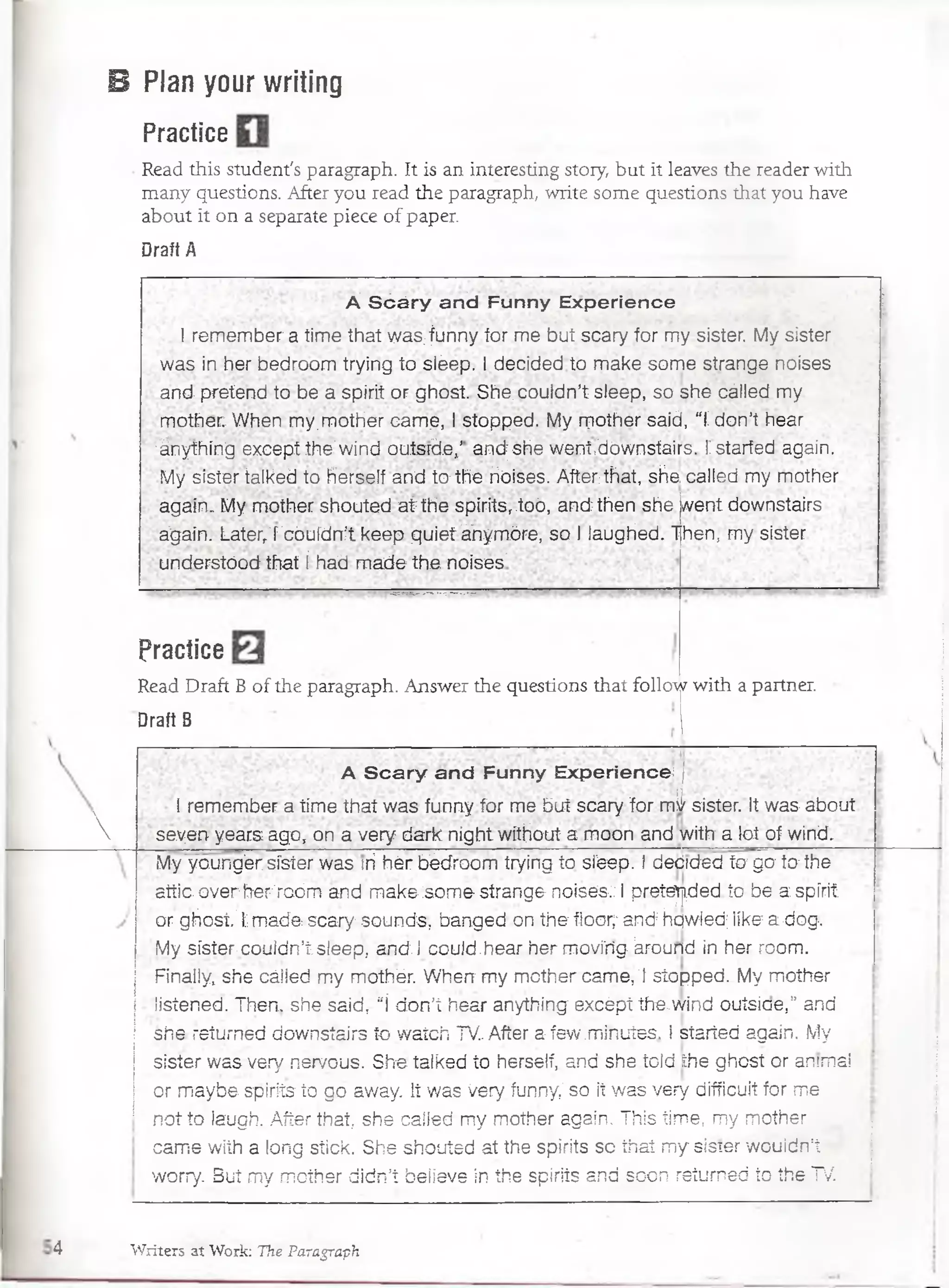
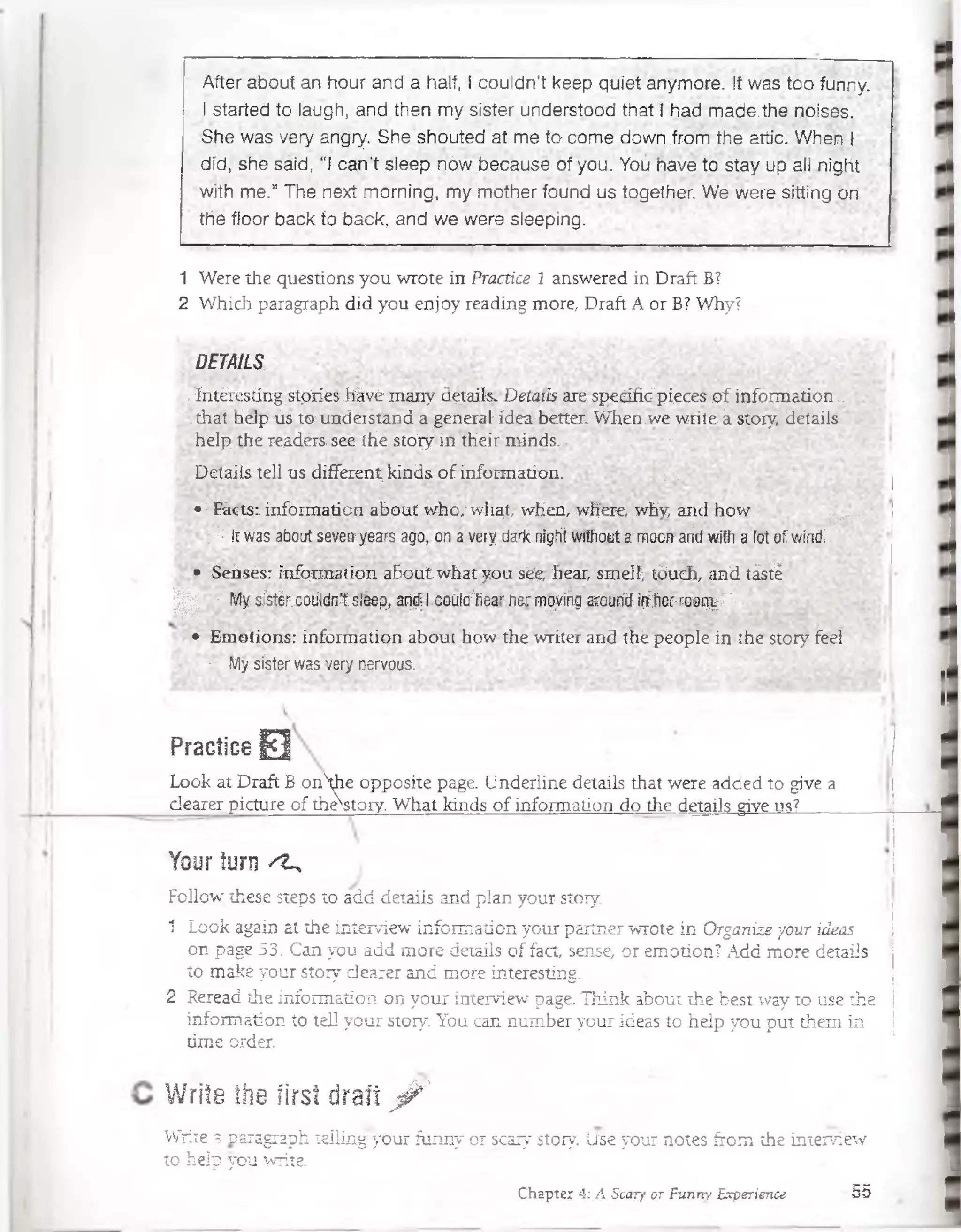
![E l REVISING YOUR WRITING
A Analyze a paragraph
Read a students first draft below, and answer the questions. Then, talk about your
answers with your dass.
1 What do you like about this paragraph?
2 Is the paragraph about one main idea?
3 Is there a good topic sentence?
4 Are all of the supporting sentences relevant to the main idea?
5 Are the supporting sentences in good time order?
6 Underline any transitions. Did the writer use enough transitions?
7 Did the writer give three different kinds of details: facts, senses, and emotions?
A S c a ry Story
V l: remember about ten yeai;s ago. when t stayed witfysome friends in my
■cbüniry;:W e were next to-an qfd, empty house.,We were talking about ghostsv,
I wilí gfve yoih
300 dollárs.”I thought aboüt ítJHe gaye me 3ÚÓ doll$rsKand Fwent into the
.hoúse..After:[;went insíde.the hóus^.E was yery scared be cause ! had heard.
^áboutrth%hóuse. í:^ £ tó o k tn g tó h e fefr a tó :
G°d!
J’m. safei’" Ididn’t liké that.adyéniure, but l_needed themojiey.
Revise your writing
To heip each other, you will read each other's scary and funny¡experiences. Enjoy the
íjhowrV’'ów'. Work in smallstoñes, and think about other details that you would like tcr]
groups, and follow these steps.
1 Collect al1the papers from your group, and exchange them
2 Each person in your group will read all of the papers. For e¡ ch paper, do the
following:
» Put a star next to one word, sentence, or detail that yot like.
• Ifyou do not understand a sentence, put a question m<rk (?) next to it.
9 At the bottom of the paper, write one question about tiíe story. Ask for more
details about something in the paragraph.
with another group.
Writers at Work: The Paragraph](https://image.slidesharecdn.com/writersatwork-130924081026-phpapp02/75/Writers-at-work-68-2048.jpg)
![Your turn
When you get your paragraph back, reread it. Then, answer these questions.
1 Are there any question marks on it? If so, rewrite those sentences more ciearly.
2 Answer the questions on the bottom of your paper. Can you add details to make
your story better?
3 Look back at your interview notes. Did you include eveiything that you wanted to
include in your story?
4 Ask yourself the questions in Analyze a paragraph on the opposite page. Do you
need to make any changes?
5 Look at your Progress Check on page 49 of Chapter 3. Use it to heip you revise your
paragraph.
C Write the second draft
Rewrite your p'aragraph, and make any changes that you need. Write a title at the top ¡
of your paper. •
E ] EDlHNG YQUR WRtTiNG~~ "
A Focus on sentence grammar
A compound sentence is made up of twp simple sentences. In a compound £ | i
^sentence; the simpleseníences. surecalled independen^dauses¿;ThereTáre usuallyI - *
i ¡ only'twchindependent clauses in one compound sénténce. The cfauses;áre jomed- j
'hya coardinating conjunction Qmd^or, hut, so}. A-comma is placed^after the,first
índependéniNcIause.. ' V. , - ~ -I-;,-, - bi . -. '•*%
He gave me 3 w doilars, and ¡ warcf into the house. ¡ r ' ;
' Á : independent-clátise «! CG índependenfcfeuse r ___________„ _________________________________________- , ri
»
Practice Q j
Do thése sentences fit the description of a compound sentence? With your dass, talk
about why or why not
1 People have always talked about ghosts, and many books have been written about !
them, but people caimot agree on their existence.
2 Some people believe in ghosts others laugh at íhe idea, other people just aren't
sure.
3 One student saw a ghost, and he'ü never forget the experience he belieyes in them
now.
Chapter 4: A Scary or Funny Experience 57](https://image.slidesharecdn.com/writersatwork-130924081026-phpapp02/75/Writers-at-work-69-2048.jpg)
![y
RUN-ON SENTENCES
A common writing mistake is the compound run-on
sentence does not usually have more
is probably a compound run-on sentence. There are
can resuJt in compound run-on sentences !
/ i t
• More than two
People have always taikecf about ghosts, and many books have been written about them,
but people cárinot ágree on thefr existence. -
• More than two independent clauses not joinedby-coordinating conjunctic
Some peopíe believe in ghosts others laugh at the idea, other péopie just aren’t süíe.
-on sentences : V r -
One student saw a
Read this student's story. Decide which sentences are run-ons. Write RO aboye the
run-on sentences. Then, talk about your answers with your ¿lass.
A Visií
1O ne n ig h t in m y country, I couldn't sleep. 2I was alone in m y bédroom,
and my brother and sister were sleeping in th e ir rooms. ÍO utside, the weather
was not good. 4lt was raining hard my room was dark, and it was about three
óclock in the m orning. 5I prayed to-G od, and I wished for sleep. 6Suddenly, í
saw a young wom an w ith long black hair in fro n t o f me,
com ing from her, so I could see her clearly. 7She gave m]e
was floating above the fioor. 8! was scareó a t the sight, llco u ld n 't do anything,
then, she started to laugh. 9! turned the lig h t on w ith a ig efFort, but she
disapt?eared in fro n t o f me I went to the livinq room and
. I
m orning. 10Even to d a y , I can't forget th a t experience, and
bother me zaain.
and soft light was
a smile, but she
sat there until
hope she will nevar
58 Writers at Work: T ke Paragraph](https://image.slidesharecdn.com/writersatwork-130924081026-phpapp02/75/Writers-at-work-70-2048.jpg)
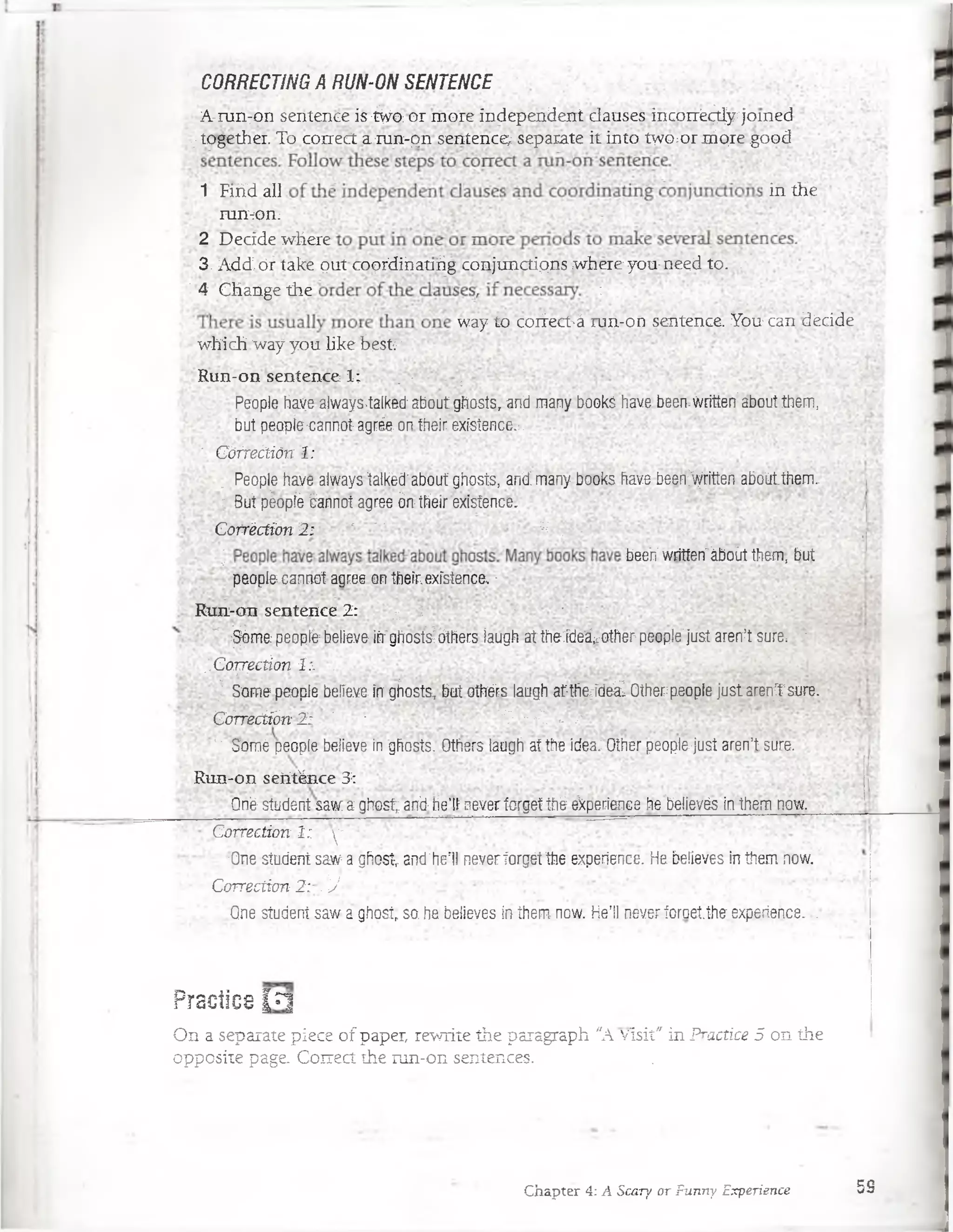
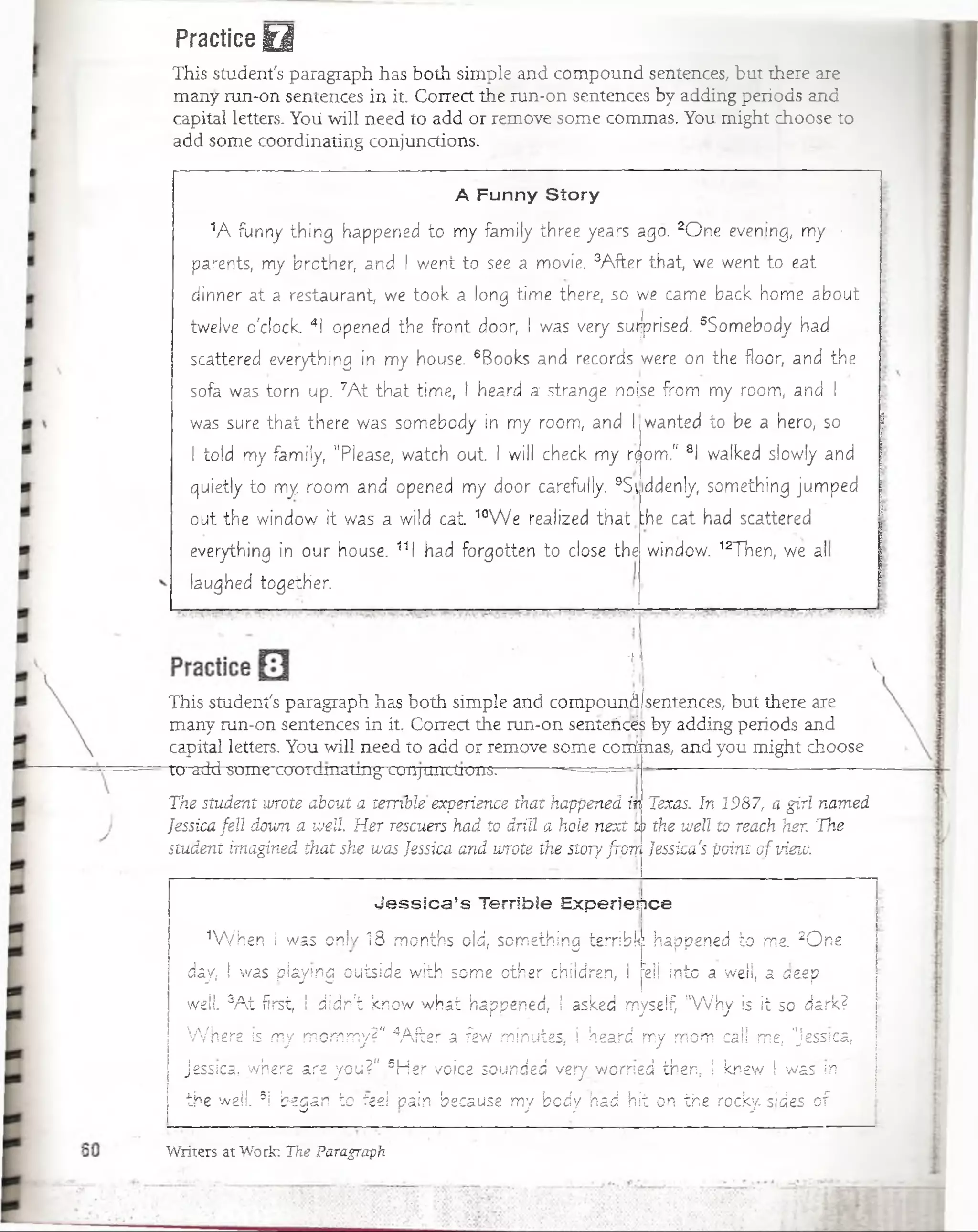



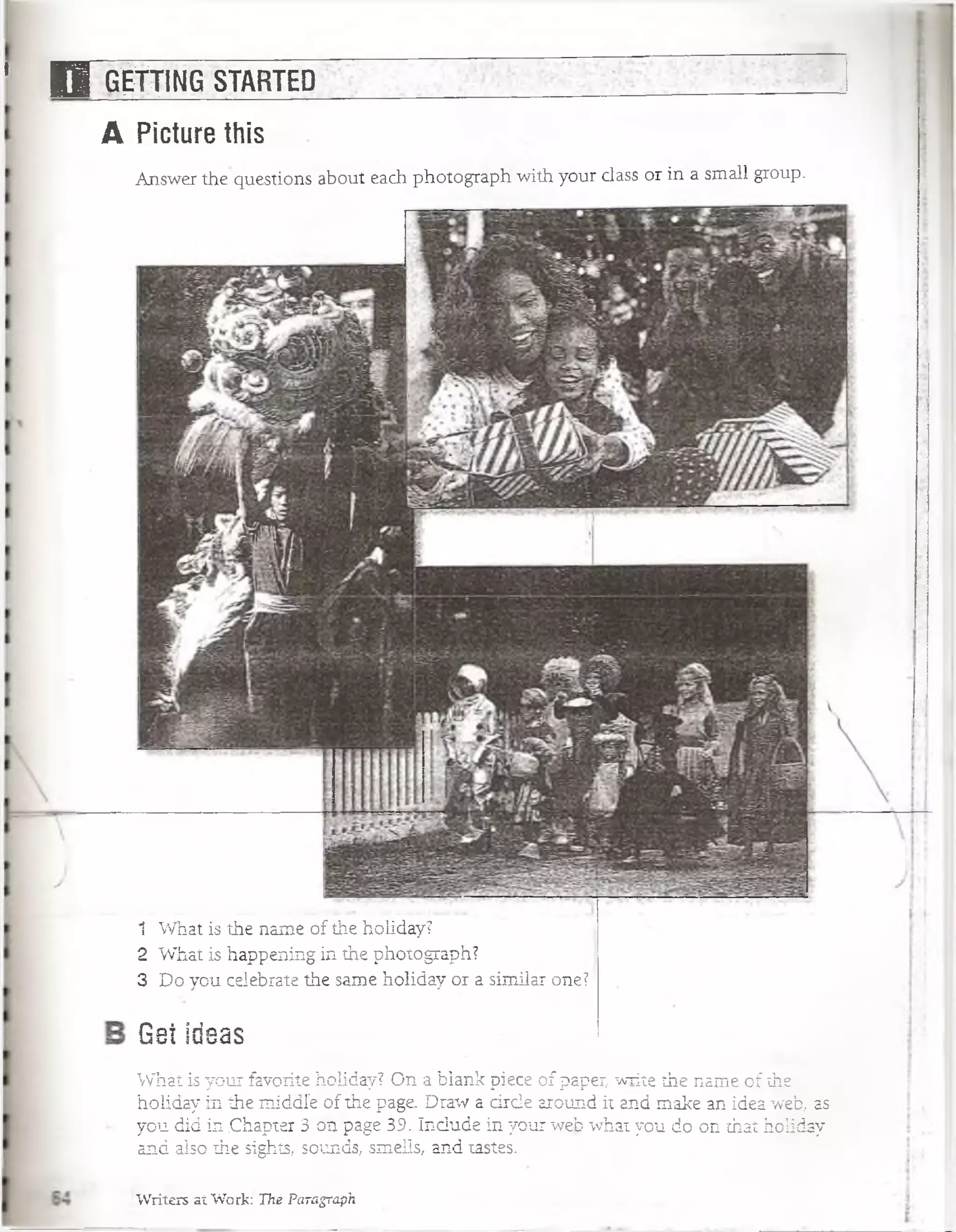
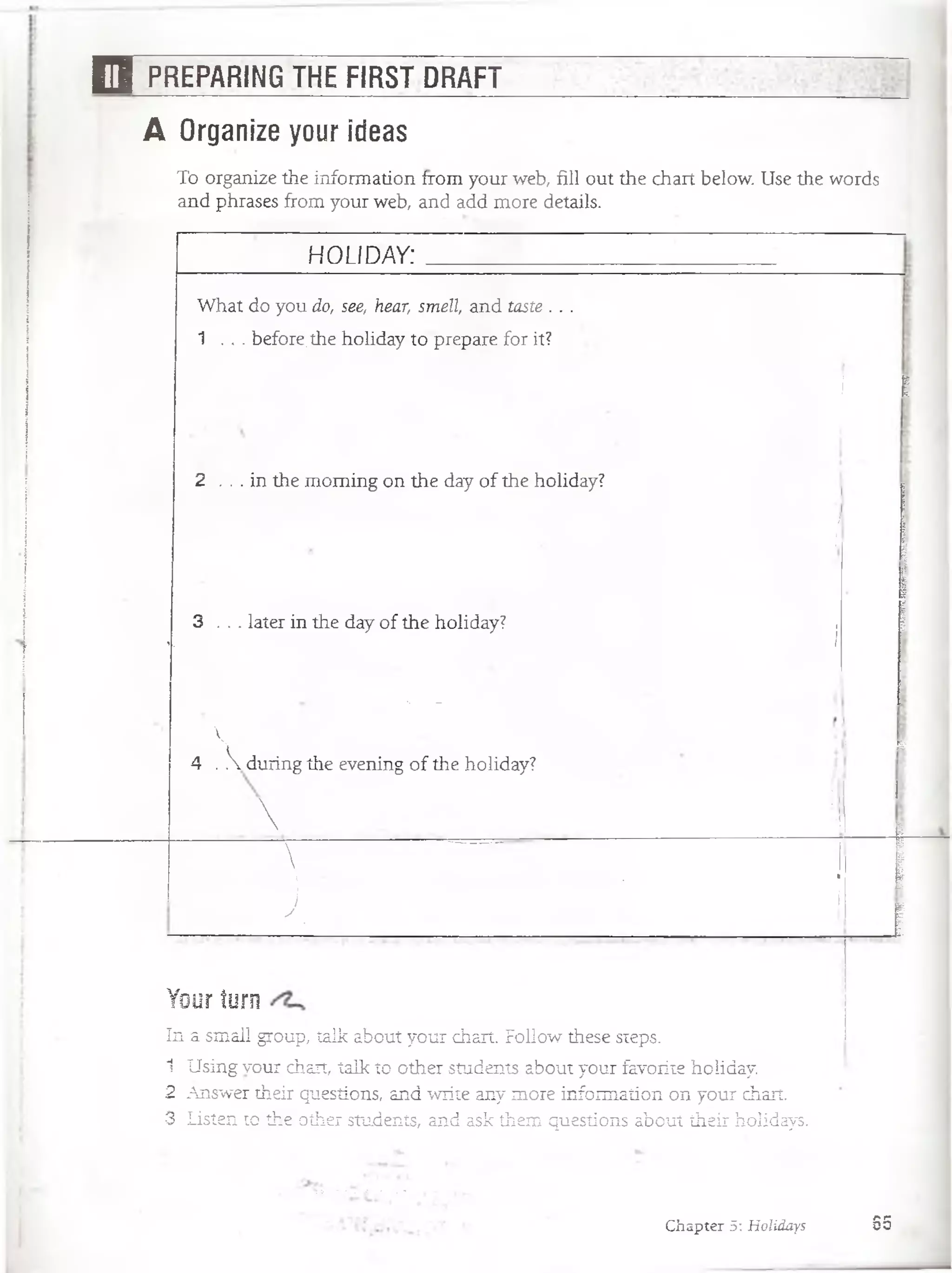
![B Pian your writing
THE CONCLUSION
ln English, a paragraph has three parts: abeginning a middle, and.an ejid- So far
we have studied the beginning tells the reader the
mam idea. Do you remember what that béginnmg sentence is;called? THe middle
óf a parágraph gives móre infonriation about the mám idea. Whát dÓ we call :
those sentences?. :
The érid ófá.paragraph is Called the concíitsion. It is usually Ae Jast sentence o£¿V
the páragráph. The.conclusión is ^as-$
sepárate;]ób'td doVThe coridusiÓn Can do sévéfal thirigí ;’ :
• ítcahrem ind the reader of the main idea. í;
. sentence in different words. •
;* lt caii tell the writers feelings or opihio’n about theideas in the paragraph.
•jt ; can do both of those things. ~ •,v;v B '^.v^V-. .
Practice
Read the paragraph below, and pay particular attention to the condusion. Then
answer the questions.
Eid al-Fitr
My favorite holiday oí the yearisE id al-Fitr. It is.the m ostfam ous holiday
o f the Mlislim religión;:and it comes after Ramadañ. At the end. o f Rarpadan v
before. Eidv people prepare for the hóliday. They gd ta the market to büysom e V.
new clothes and some sweets to e a t Mothers and
house;. Oh the. moming of Eid al-Fitr, people go tél;
tógéth-eirShftcfr
daughters also cíean the
he mosque to pray. After
T^get money from the ofder
/ísií éách other to;W ísIt each
staurahtsi Then ,'.theyigo
people to buy toys. In the aftemoon, peopíe gotoj
other a happy Eid. Fámilies also go q u ita eat in ré
and have a good time in the park. In the even ing.^people celebrate together
qntil m idnight Finally, they go to sieep because they have woken up early on
ih át day.: Eid aí-Fitr is the besí day of the yéár for rr>e..
1 What is the condusion of this paragraph?
2 Does it remind the reader of the main idea, tell the writers feelings or opinion
about Eid al-Fitr. or do both of those things?
68 Writers at Work: The Paragraph](https://image.slidesharecdn.com/writersatwork-130924081026-phpapp02/75/Writers-at-work-78-2048.jpg)
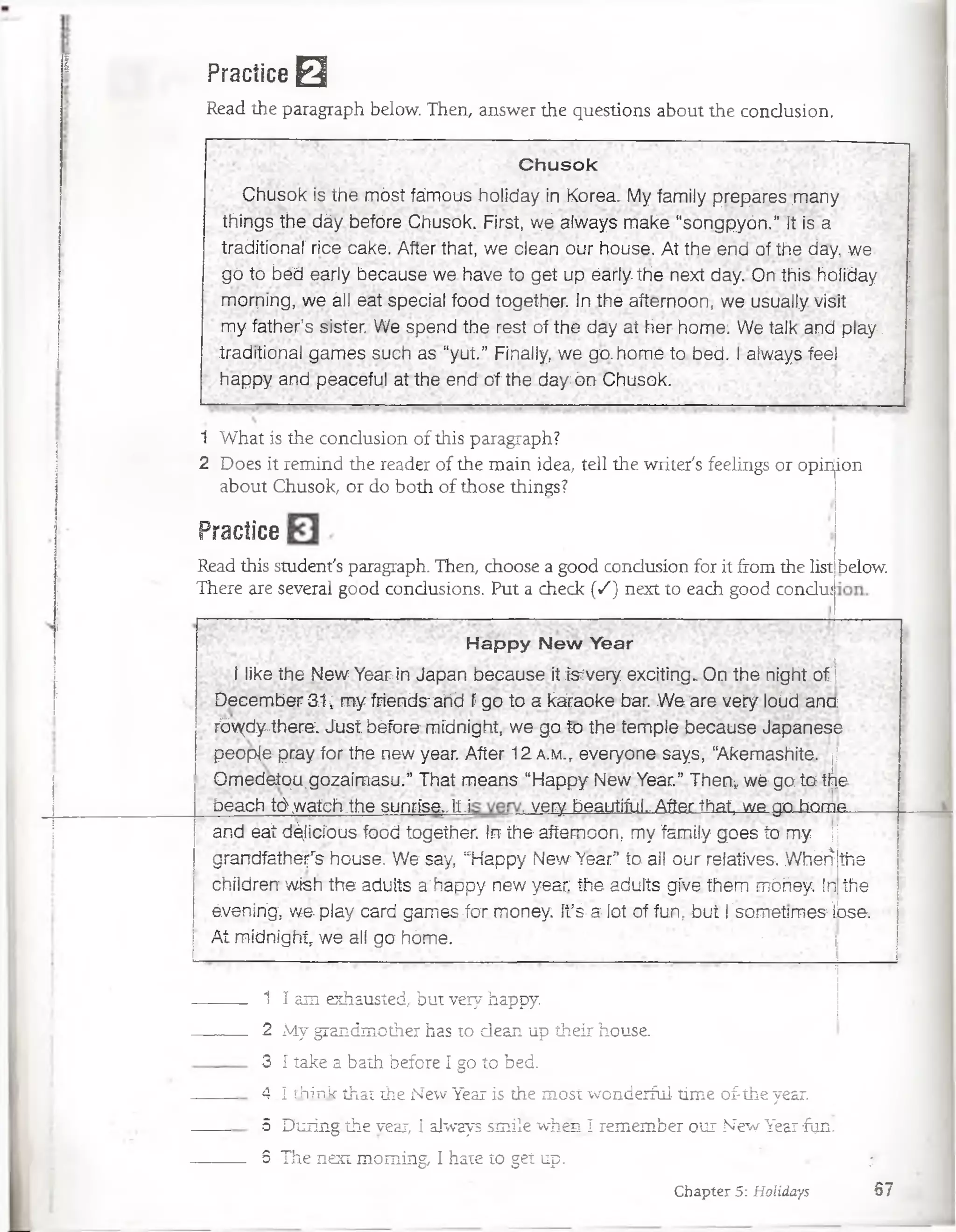

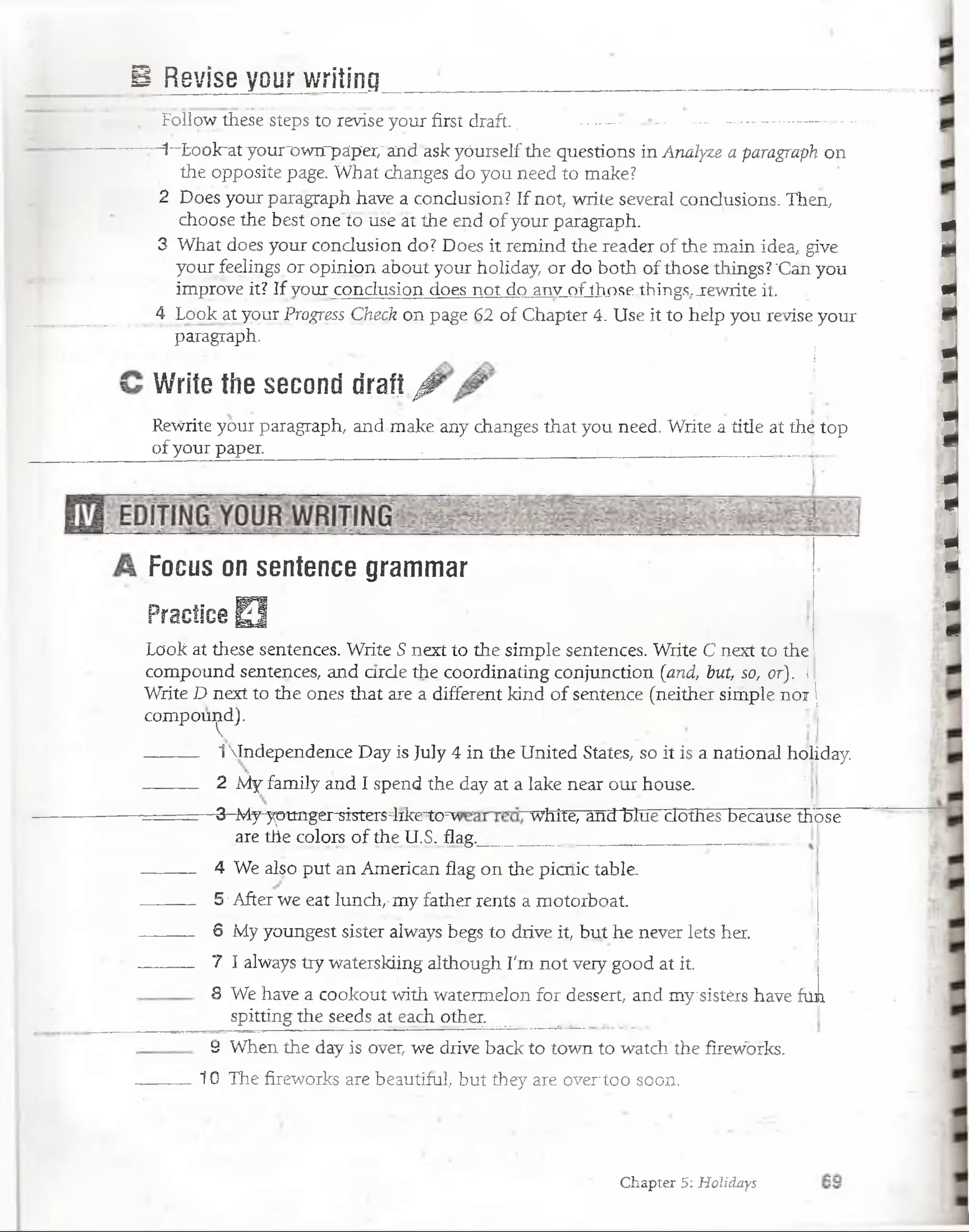
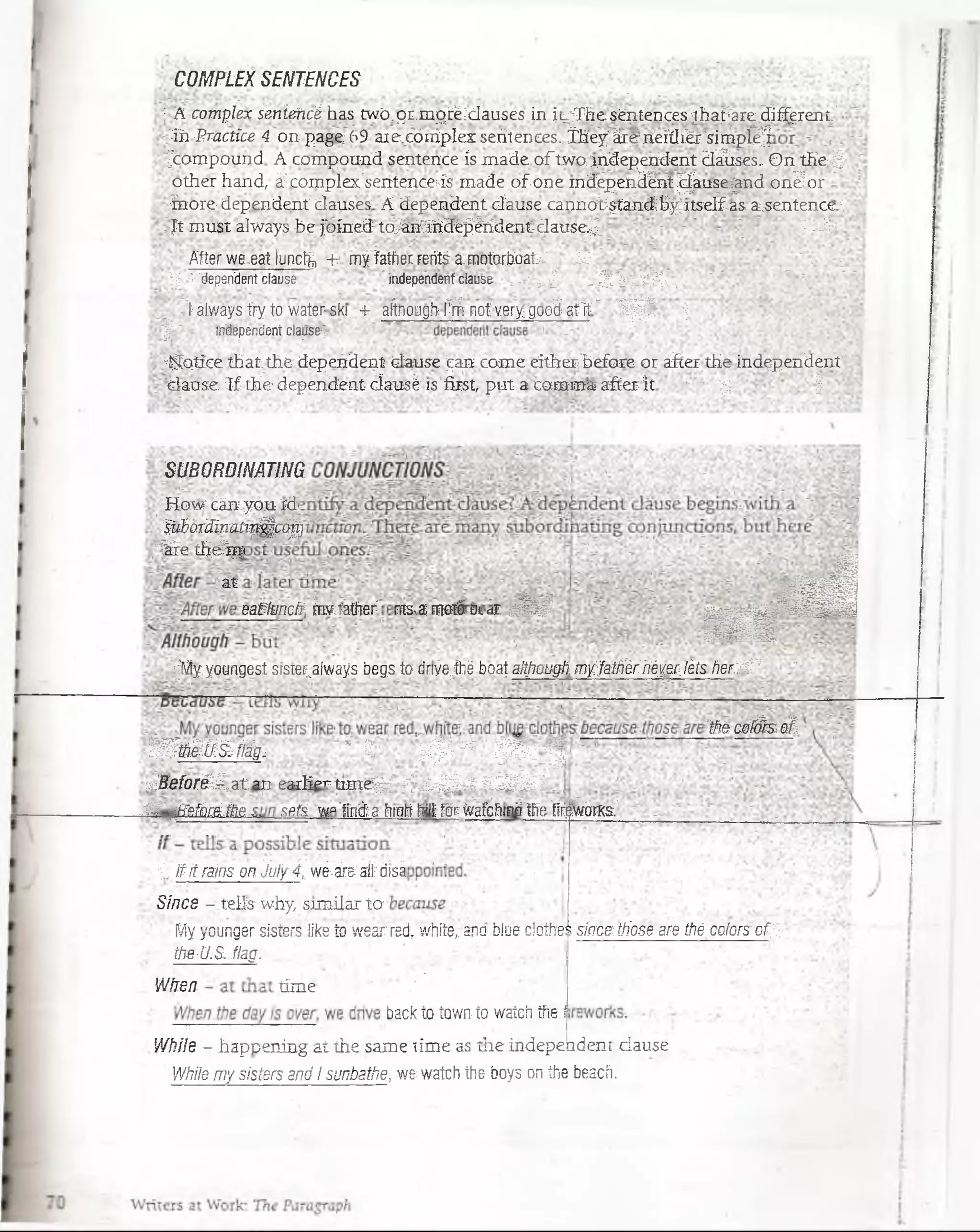
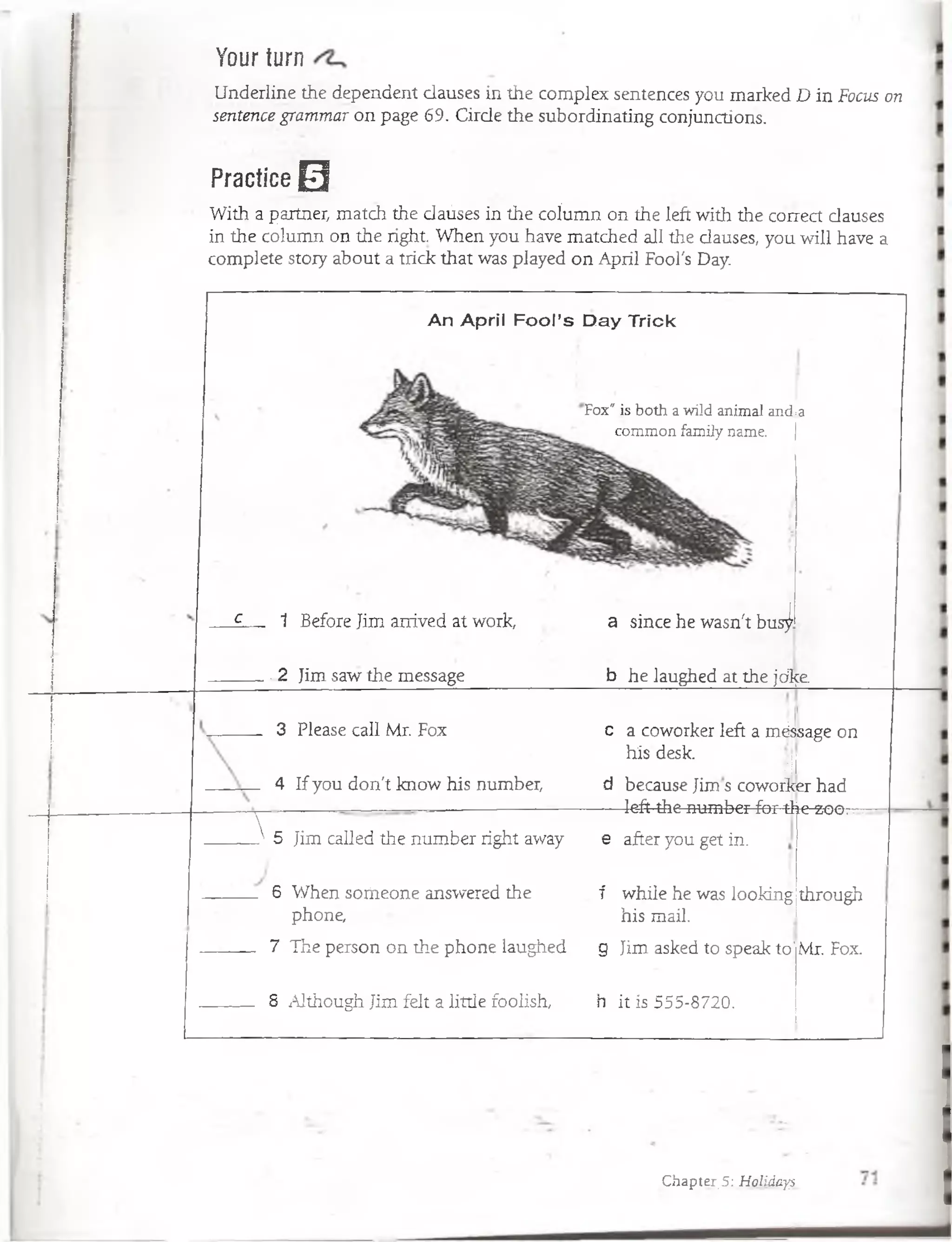

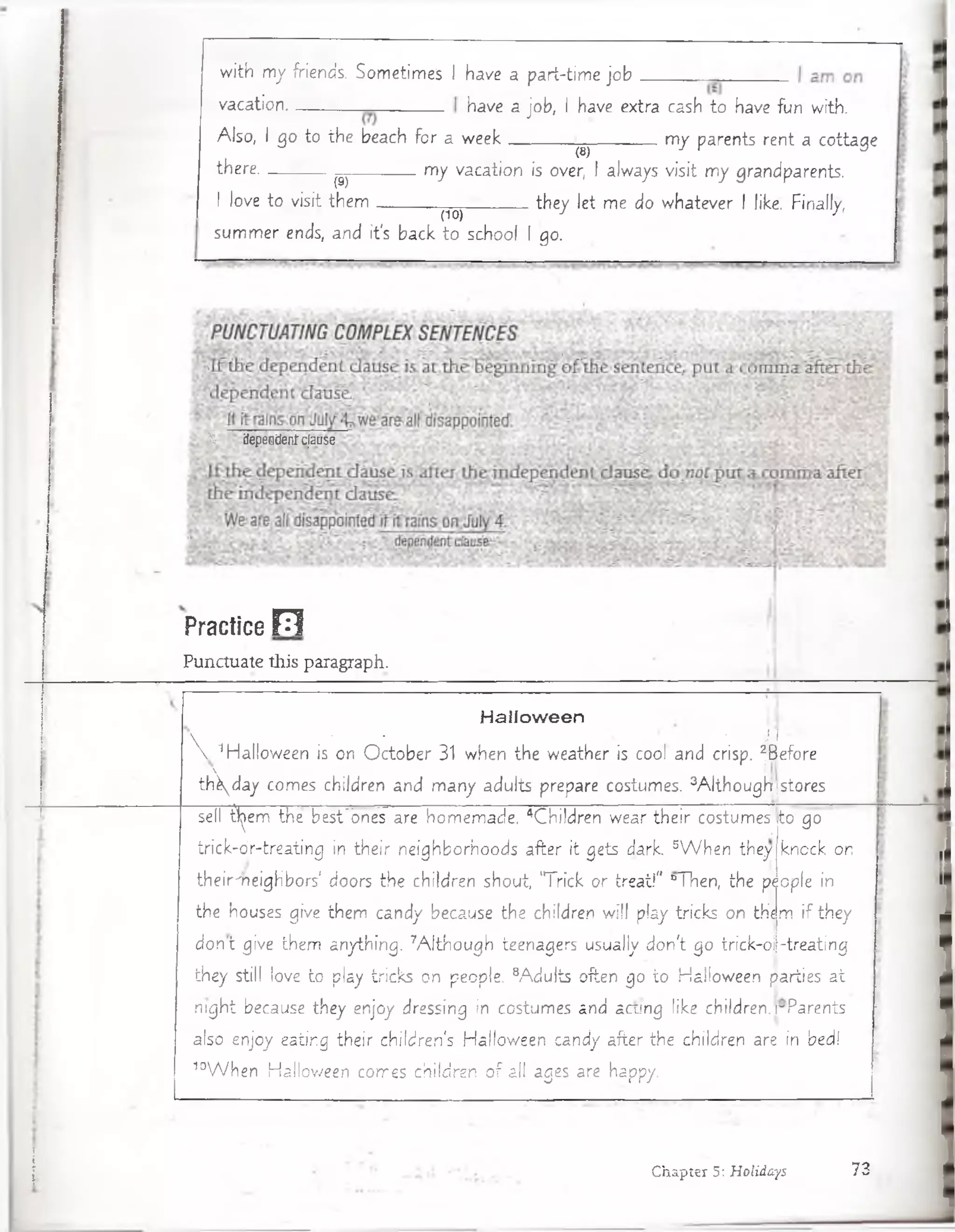
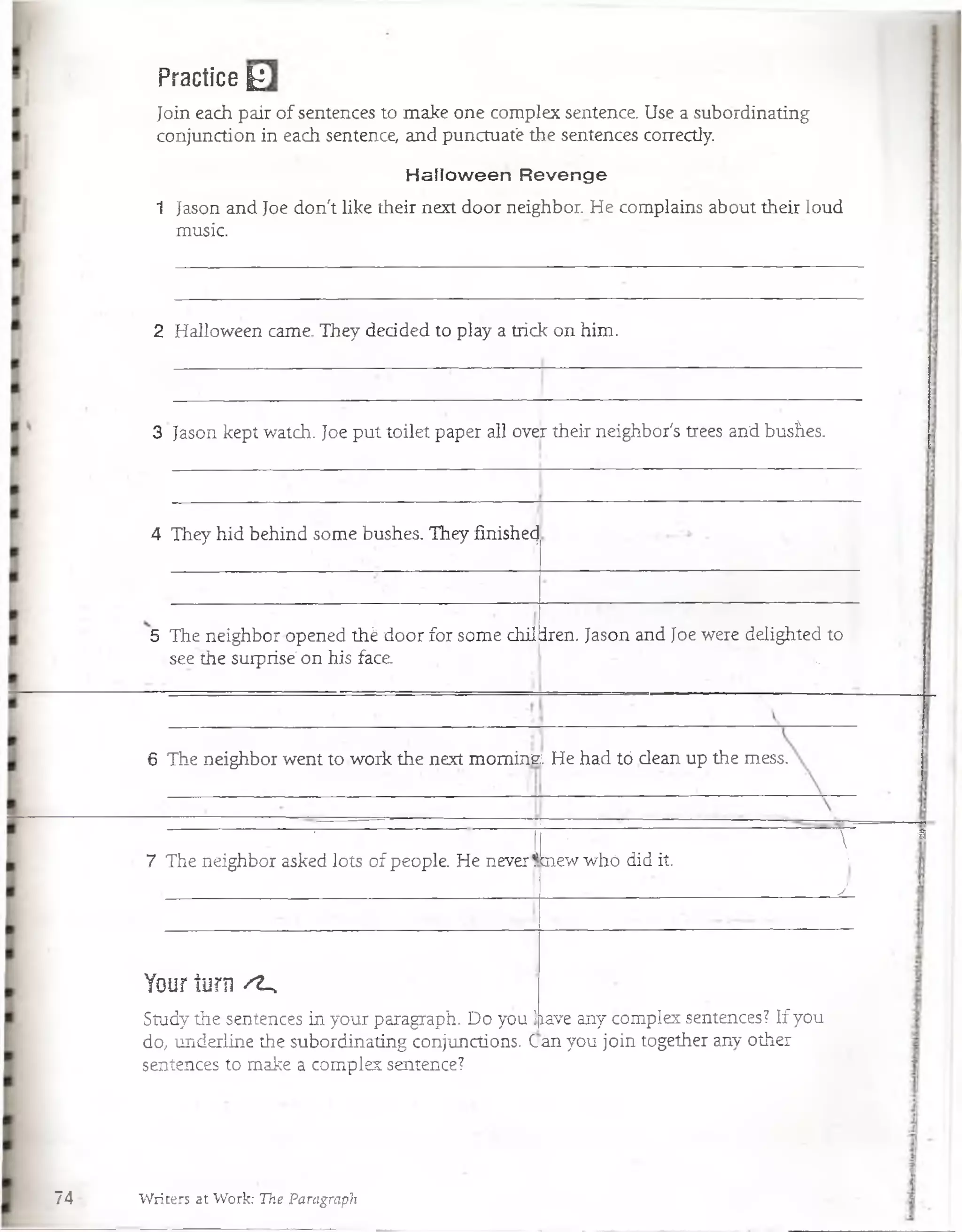
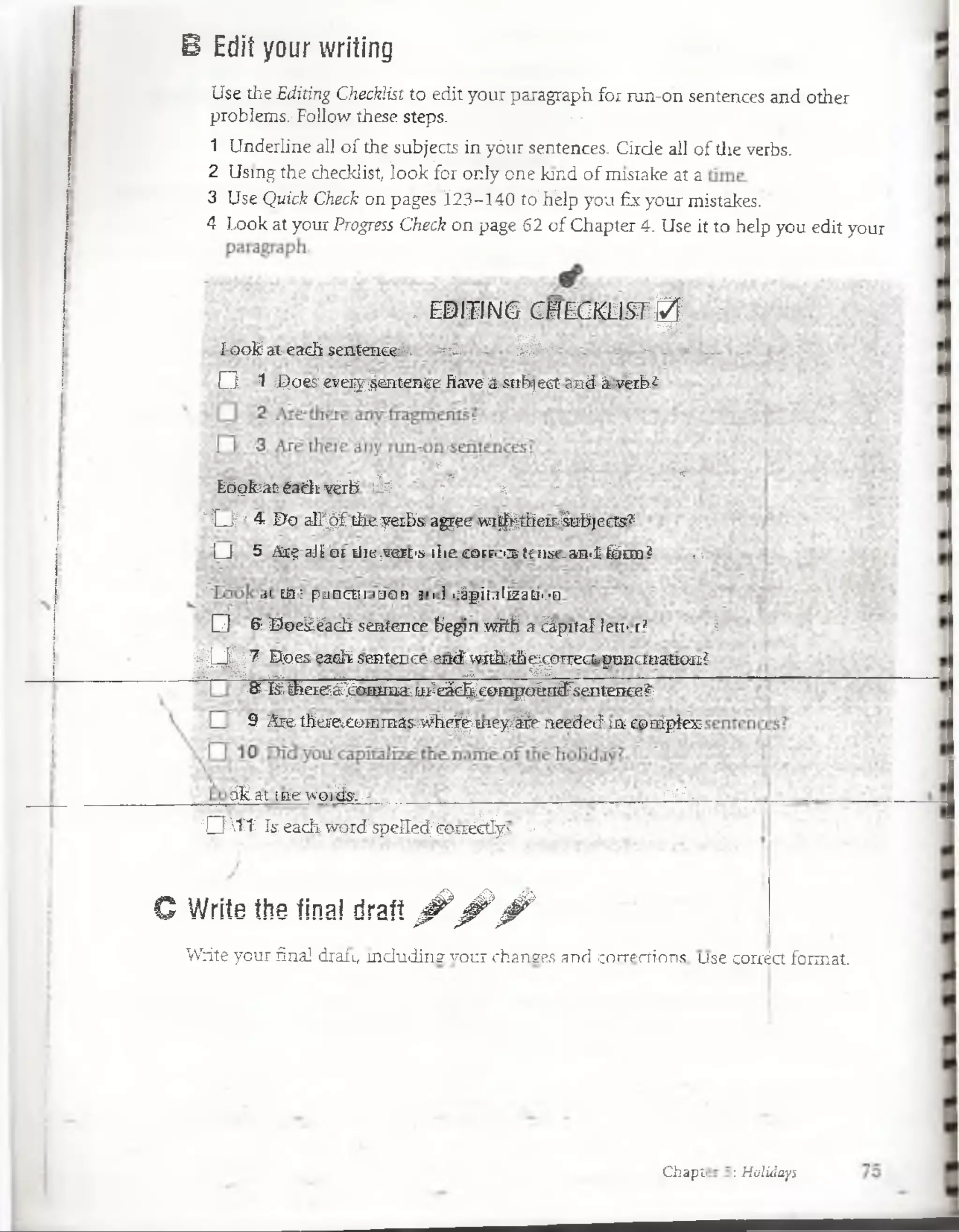

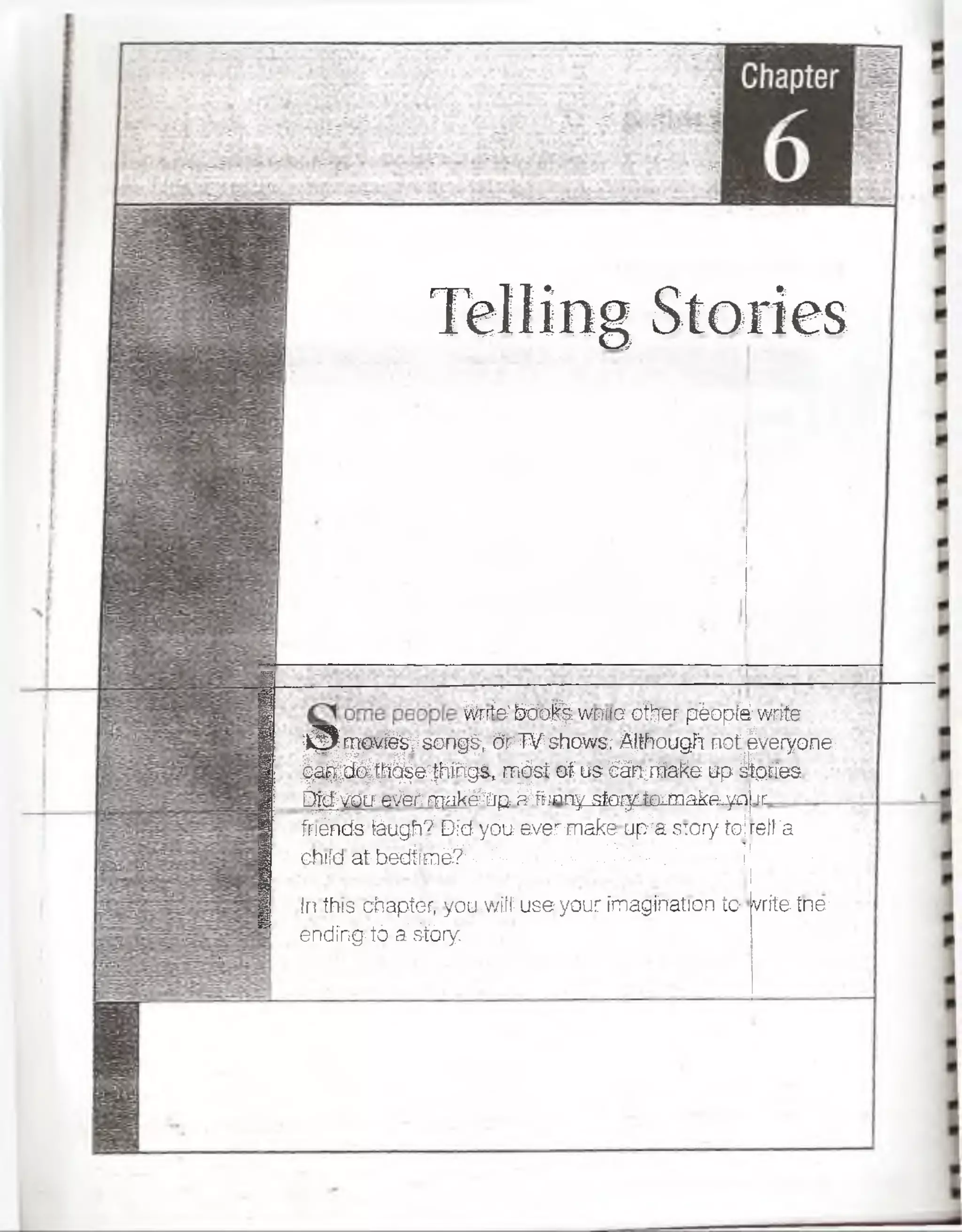









![A Favorite
1Place
'X/'QLfprobáWyIfaveafavorite,pFace|-.aplaceyou
X Jo-vetcrpe Maybeyoufeetsaféandpeacefat Fn
thatplacer Máyberfs anexcrongpfaaétíwheFeyoufeef
vervróucfoVOVe-. Ydárfayoríte^pfaná.mayhf¡ a rnnrn, a
o j * - ' e-írrtñé$l§|iKte; tfiéách.;
-or*Spi^ VS^afc.is^3^Si>0ítíe-place7]
>iearparagirapig](https://image.slidesharecdn.com/writersatwork-130924081026-phpapp02/75/Writers-at-work-99-2048.jpg)


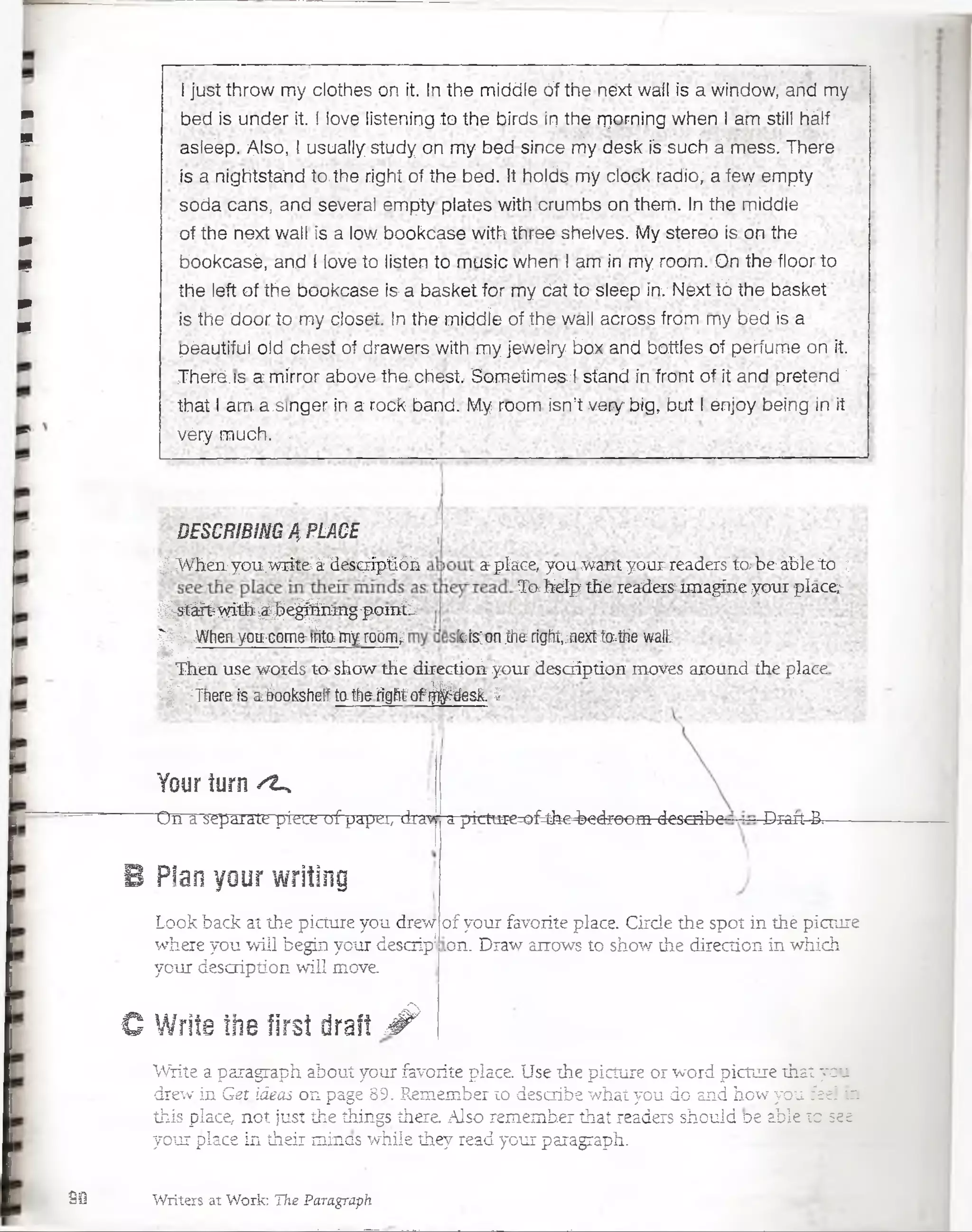
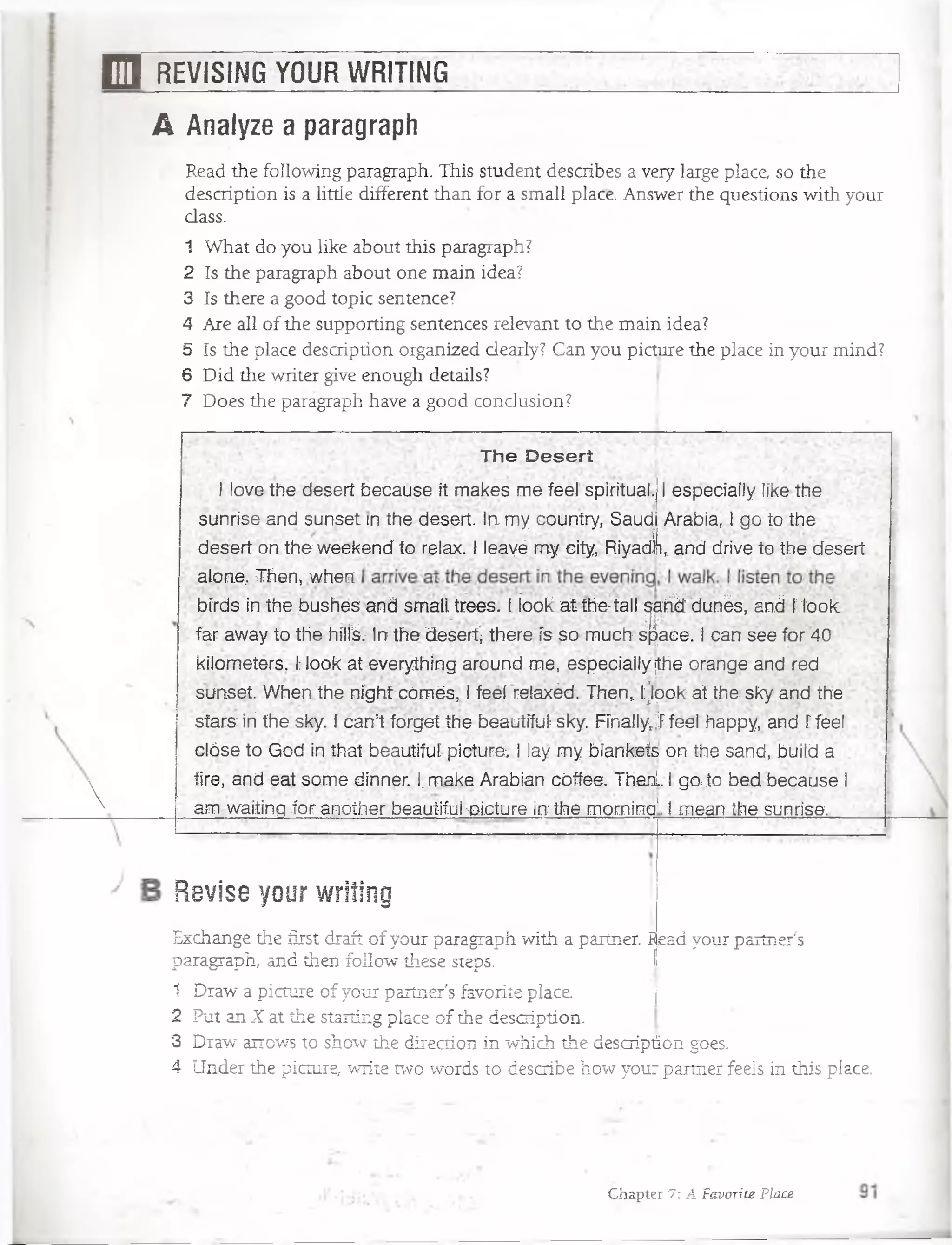



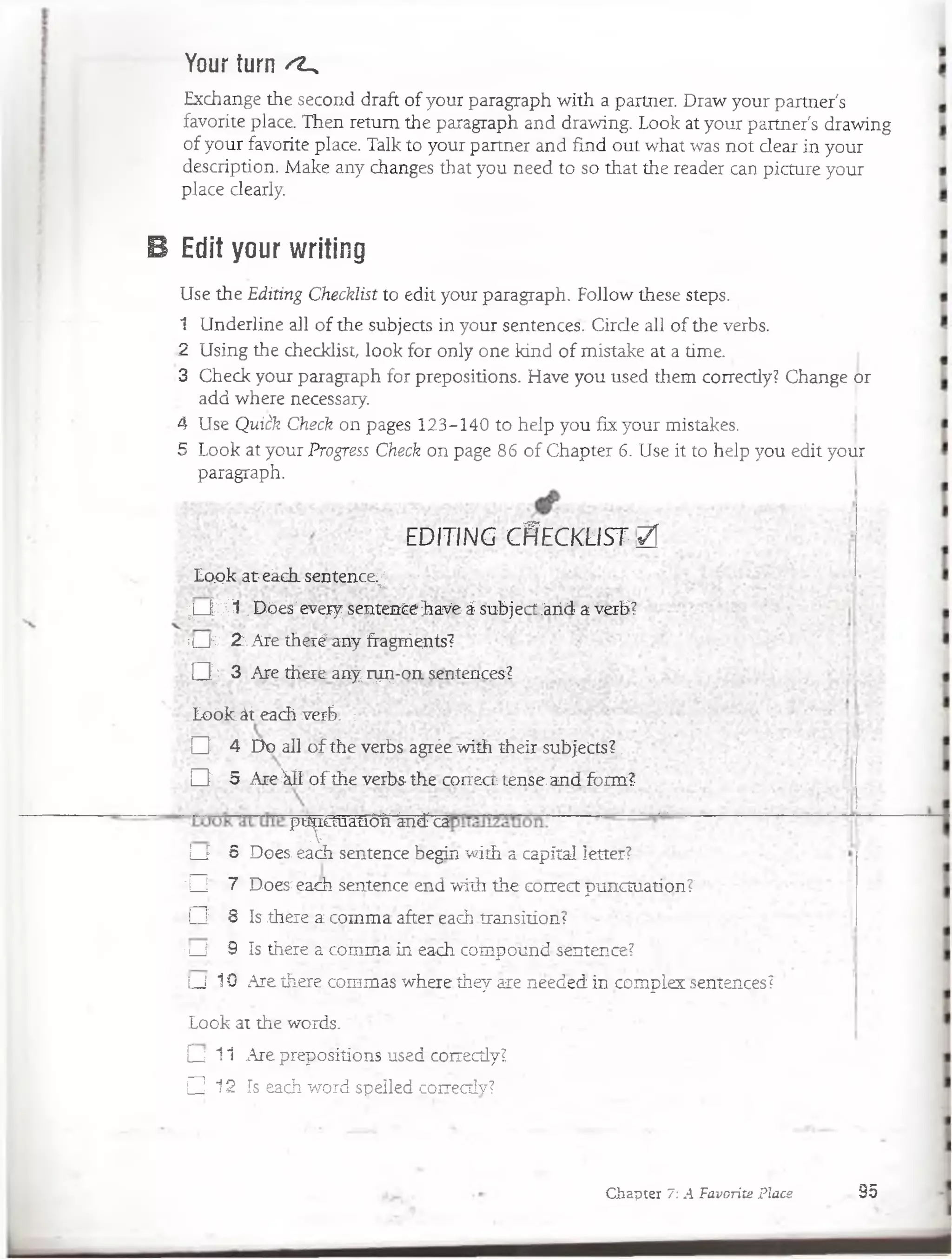
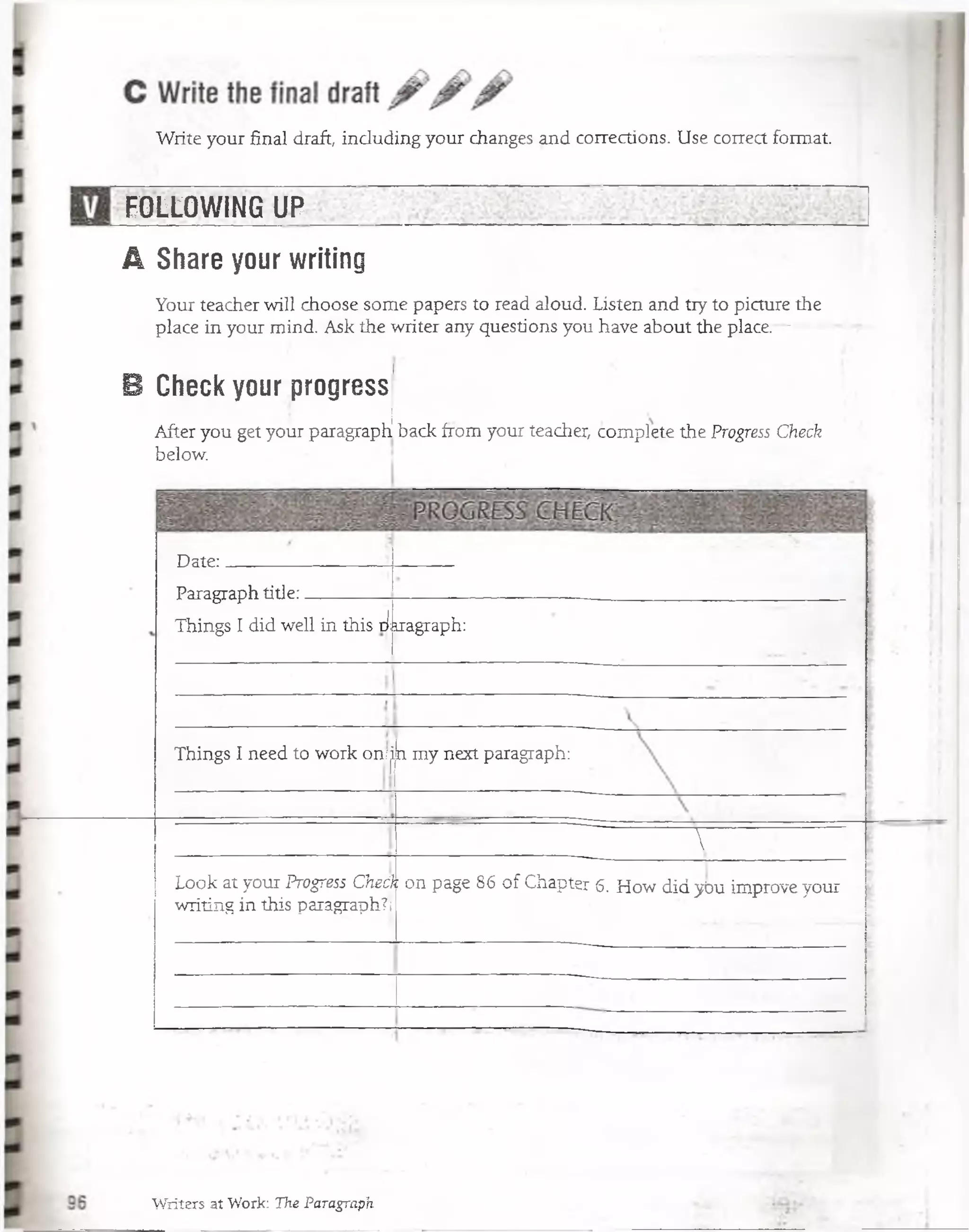
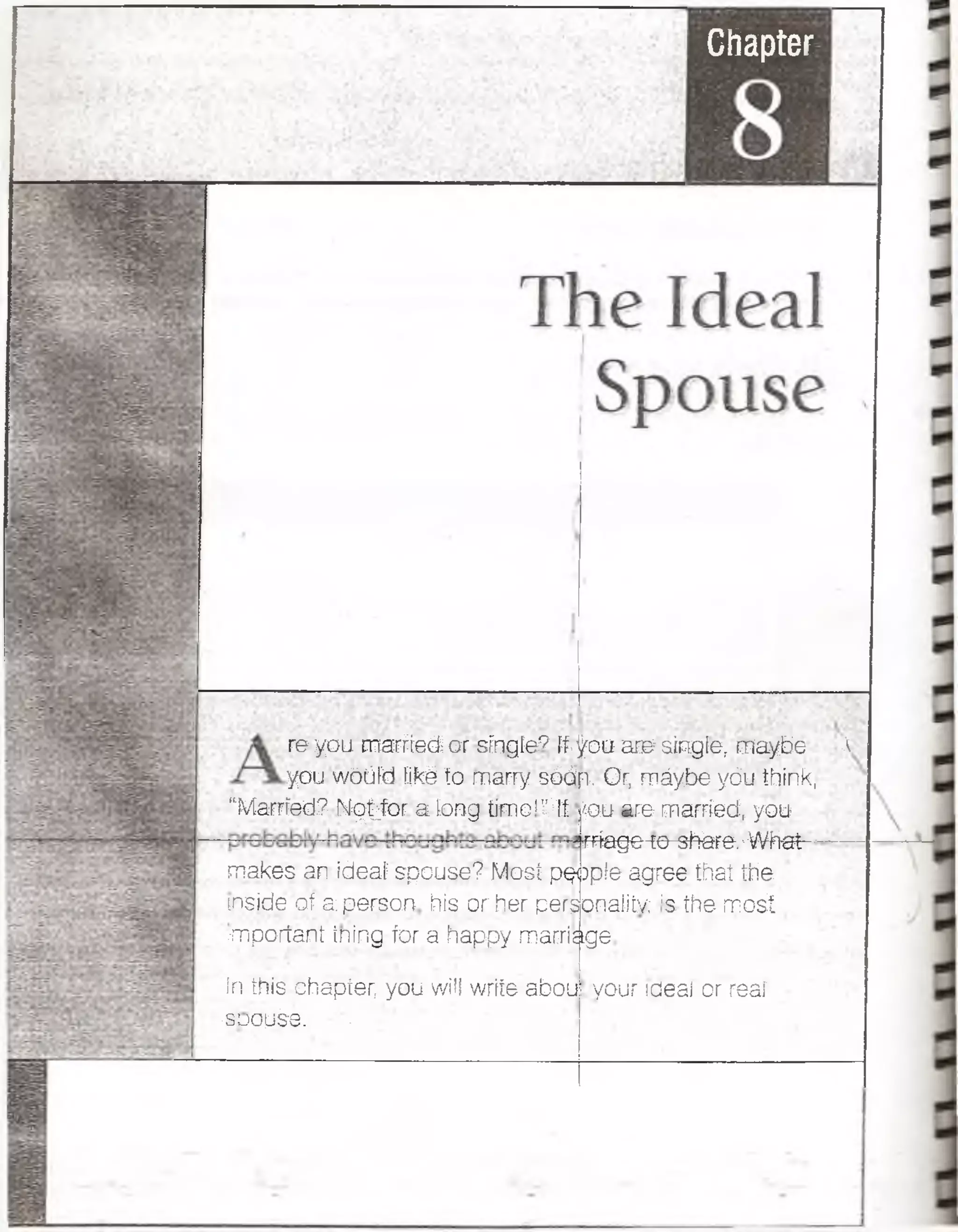


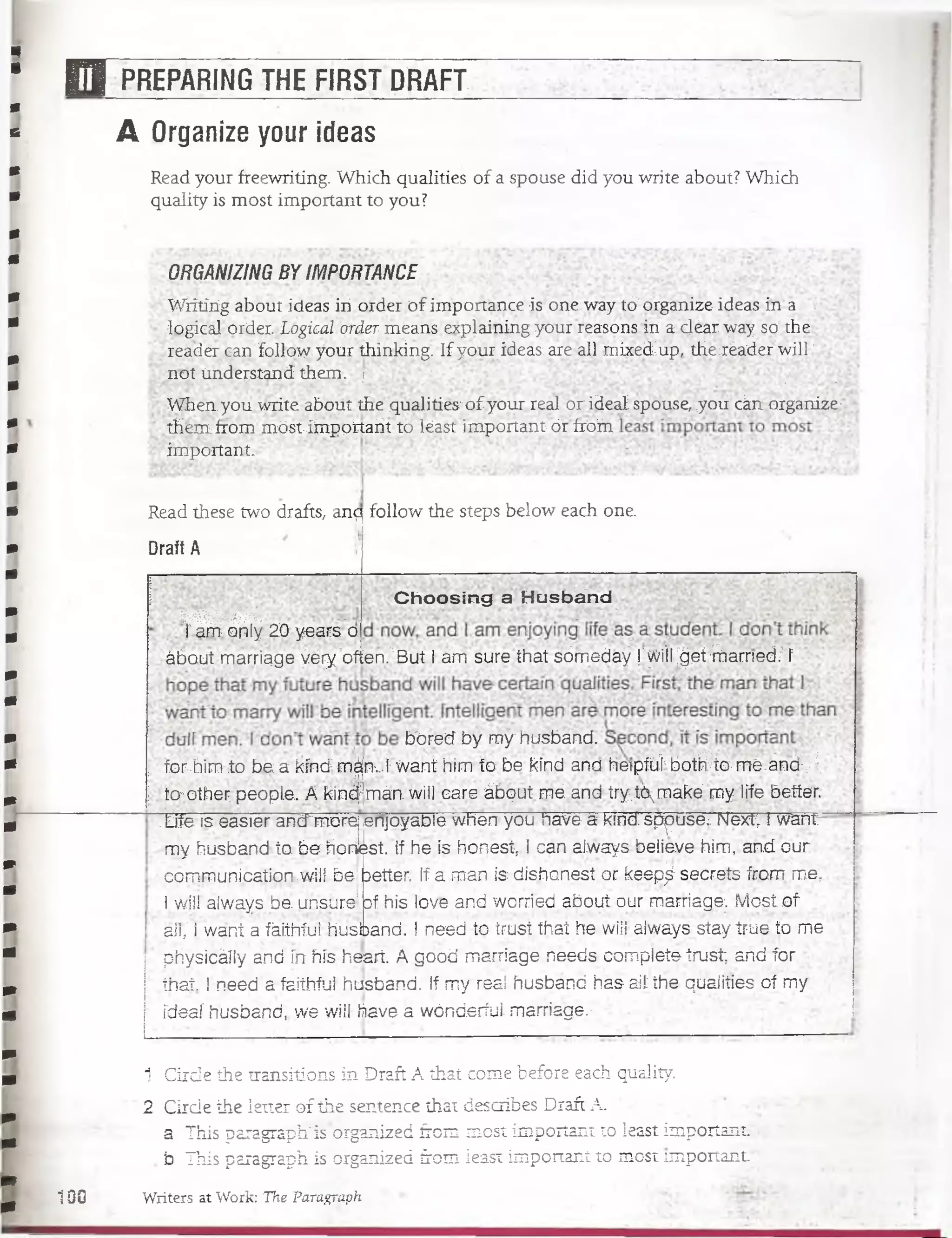
![Draft B
C h o o s in g a H u sb an ci
I am only 20 years oíd now, and I am enjoying my life as a student. I do'n't
think about marriage very, often.. But I am;sure tfiat someday I will get married.
I hipp'e that my future husband will have certain qualities, Most important, I
want a faíthful husband. I need to trust that he will.aJways stay trúe to me
physically. and stay true in his heart. A good marriage needs complete trust,
and for that, I néed a faíthful husband. Also, I want my husband to be honest.
If he is honest, I can always believe hím, ancf our communícation will be better.
If a man is dishonest ór keéps secréts from me -1 wilf always be uñsuré of his
lóve and worriéd about our marriage. In additjon,. it is important for hím to be
a kind man. I want him to be kind and helpful'both to me and to other people.
A •kind man wiít óare;about me and try to m ake my-jife better. Life'is easier and
more enjoyable when you have a kind spouse. Finally, the man that;I want to
marry will be Intelligent because intelligent mén are more interesting to me
than dull men. 1don’t want to be bbred by my husband. If my real husband
has all the qualities of my ideal husband, w é have a wonderful marriage.
1 Cirde the transitions in Draft B that come before each quality.
k 2 Cirde the letter of the sentence that describes Draft B.
a This paragraph is organized from most important to least important.
b This paragraph is organized from least impdrtant to most important
3 Which order do you prefer, the order used in Draft A or Draft B? Why?
Plan your writing j¡||
Look at the four qualities you arded in Get ideas]pn page 99. On the lines below,
write tne rour 'qualities tnat you nave cnosen to a<
them in a logical order. Then, arde the phrase th!<
1 _J
¡scnüe your íaeai or rearspouse. rut
it describes the order you are using.
2
3
4
Most important to least important
Least important to most important
Chapter 8: Tne Ideal Spouse_ 101](https://image.slidesharecdn.com/writersatwork-130924081026-phpapp02/75/Writers-at-work-113-2048.jpg)



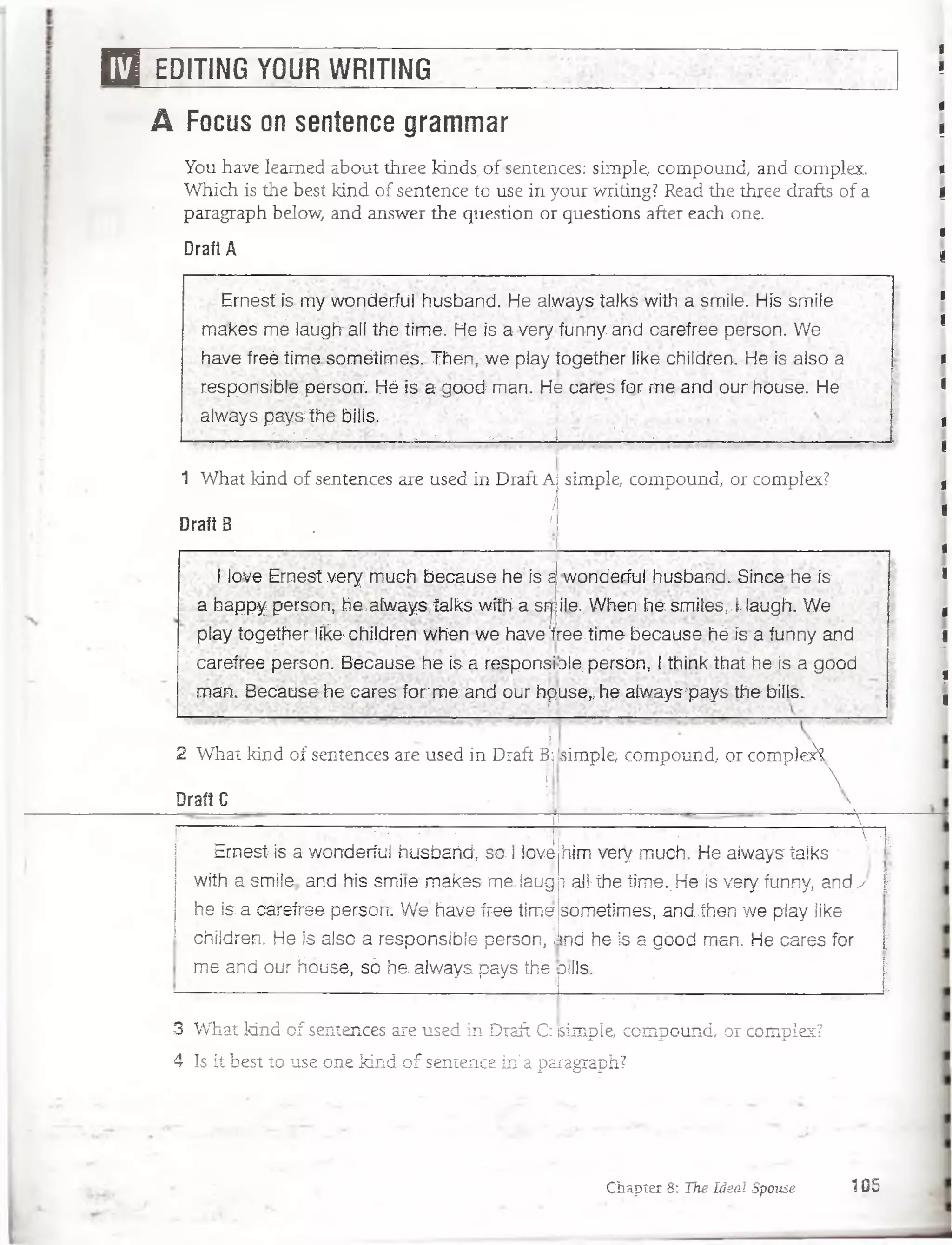
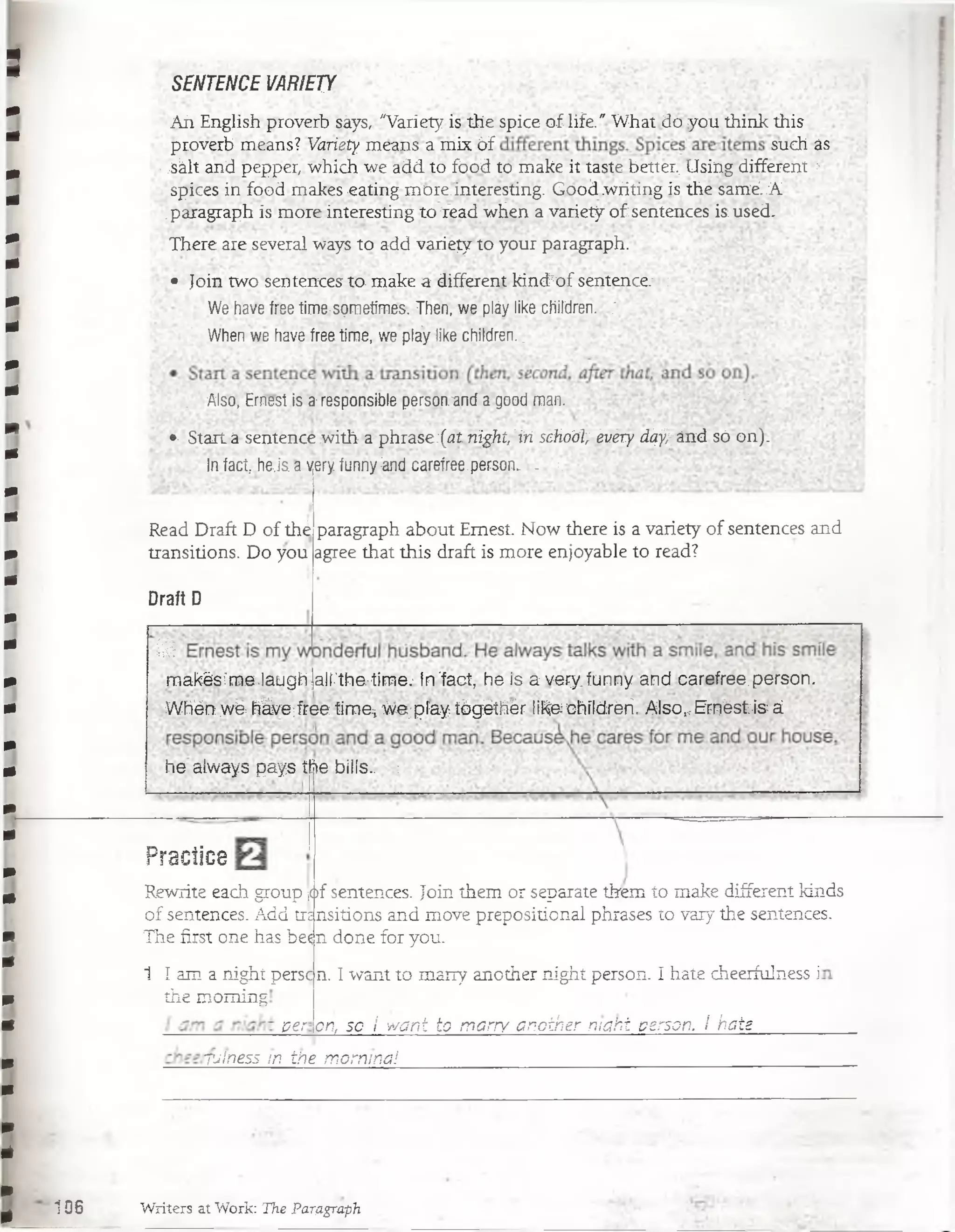


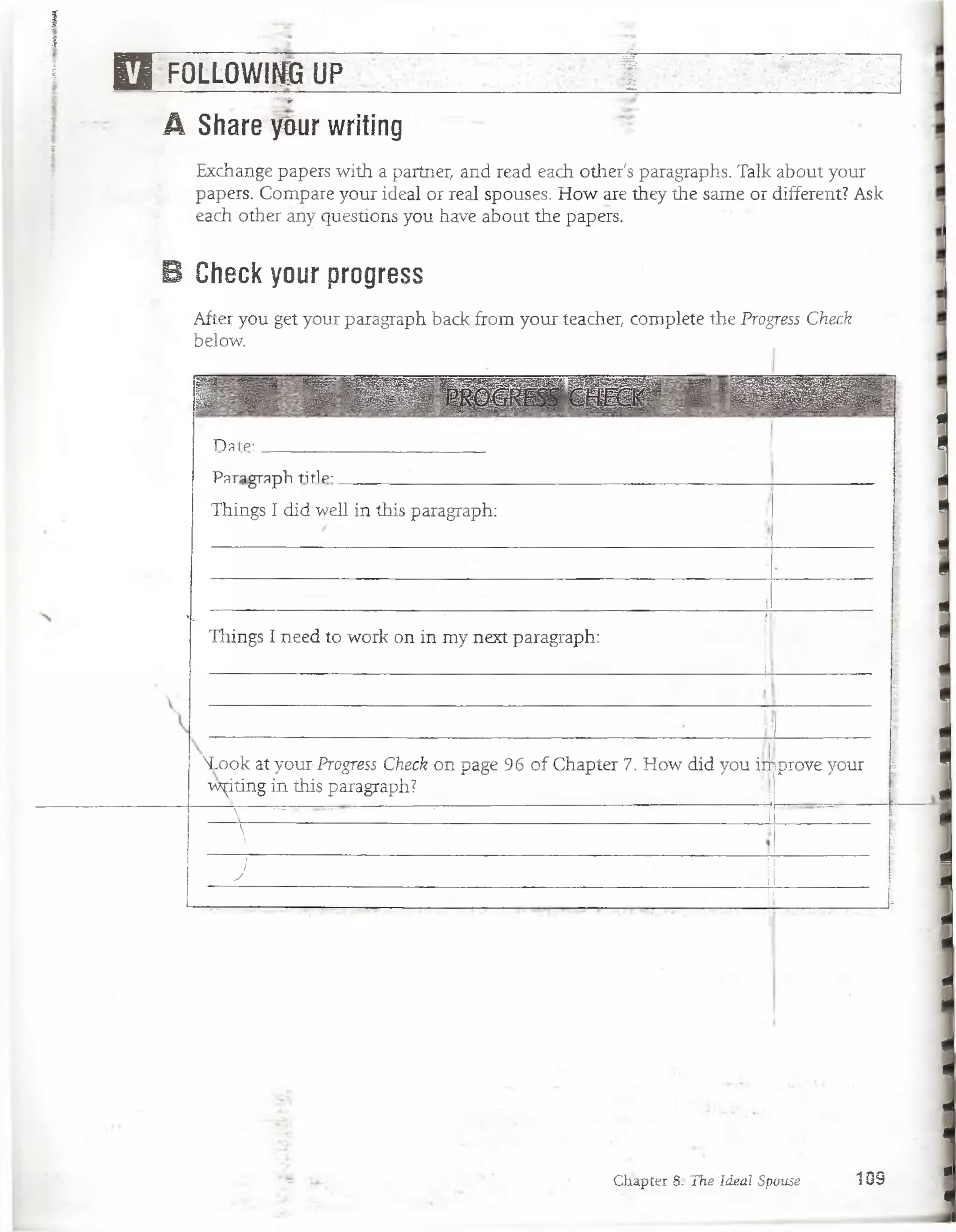
![What's You]
■ Opinión'
^ 1 ^tK R Bbs-' ^ ’ ’gffil' ¿X-1
.X j t p i H l
:b , . *It ¿$g -^||^ ¿ '’Í|
■*- -’v^ -- - vg-s* " '" “
^fjff'WJy ~¿&$$$ífi/W- w-|i V
fixpréss:aEí©piin:©n..fiás]ihts ever happenecfto-yóu? J
, "”_M'^1 ^ ^ : í r j s . r ? íÜ|kppüitóng;.
i ~i«wSpFrfejí^^&JwC.
°neofyoiigcpiníóns:
í.’pr.e * ■;•'* 3hthat exoresses.](https://image.slidesharecdn.com/writersatwork-130924081026-phpapp02/75/Writers-at-work-122-2048.jpg)

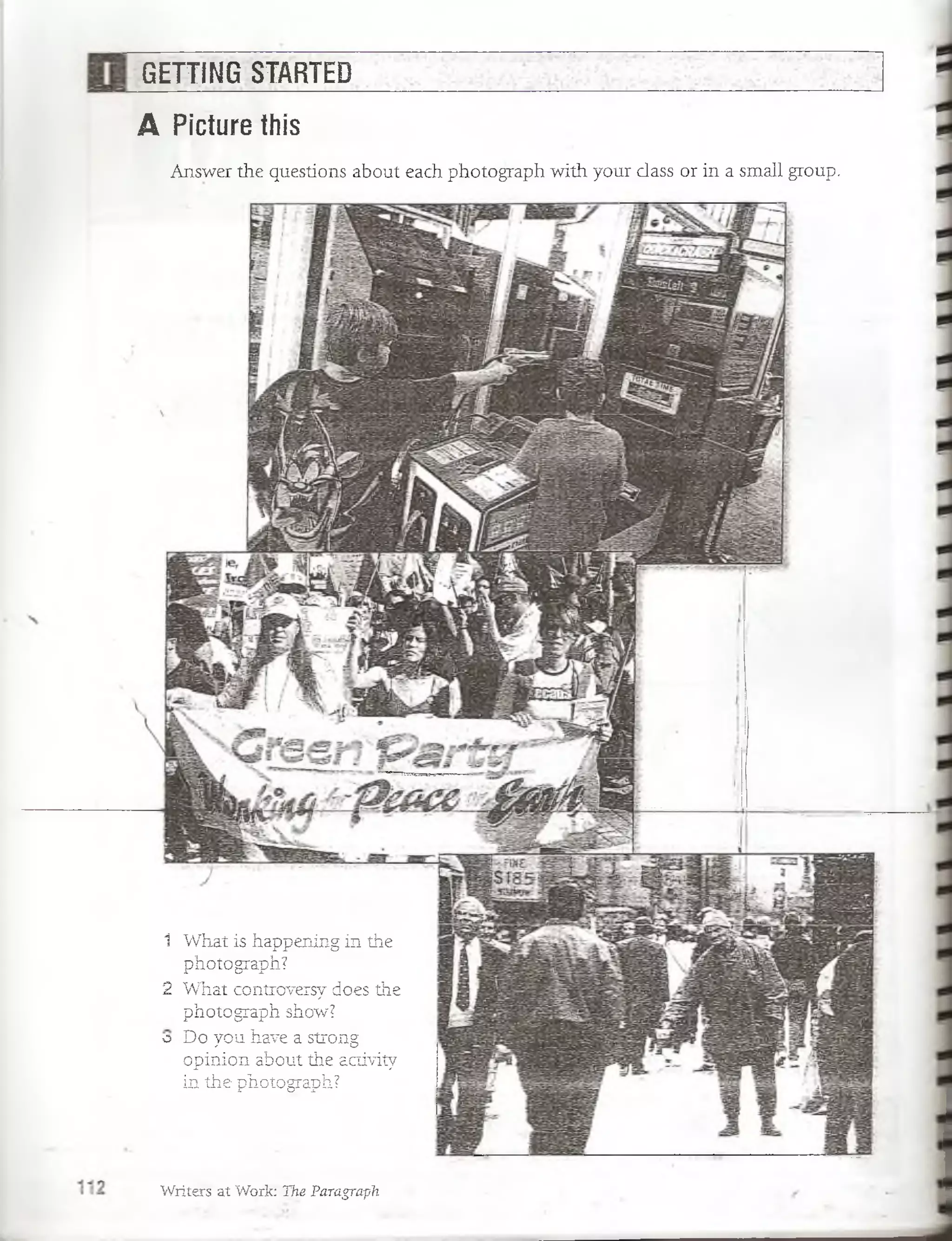


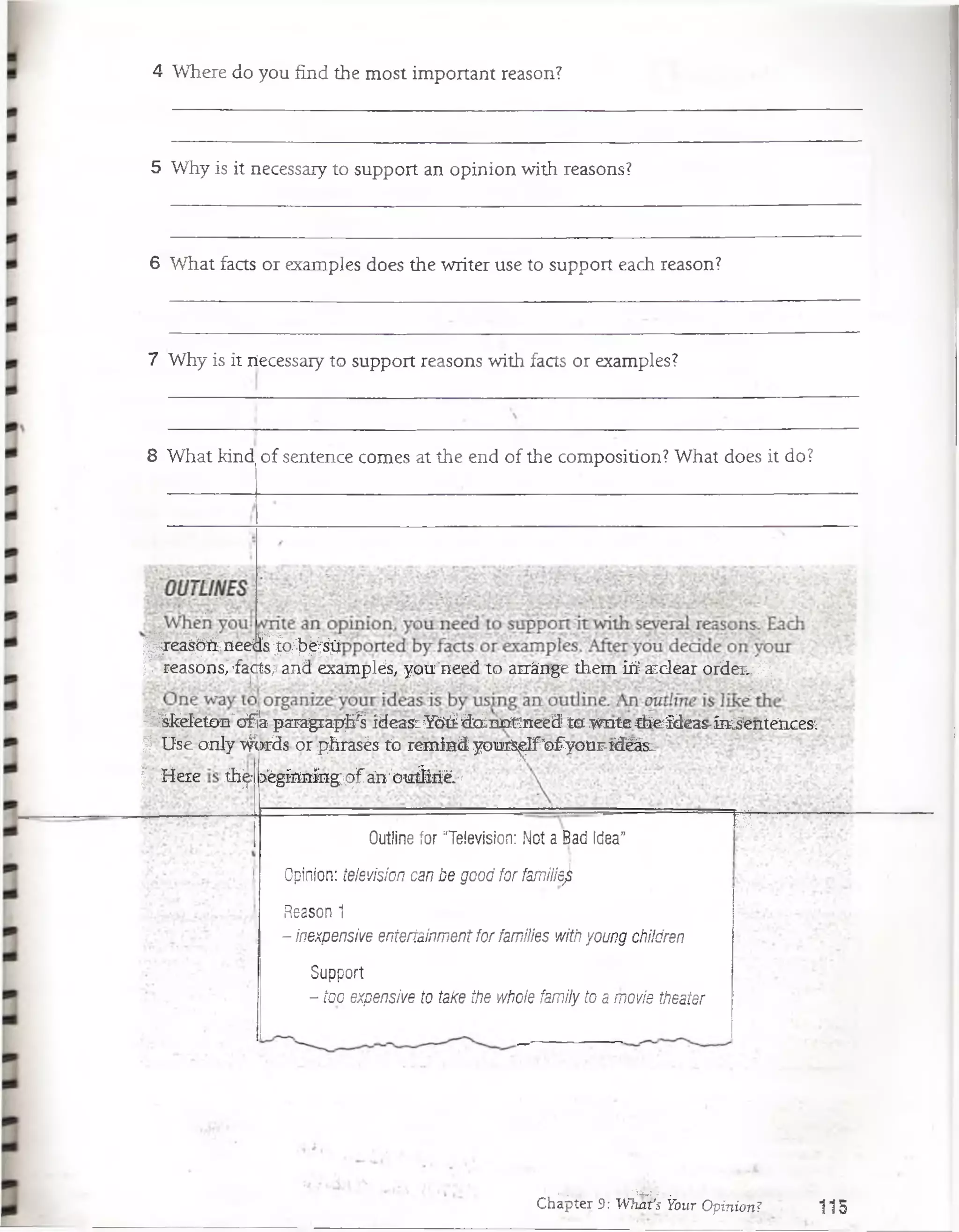
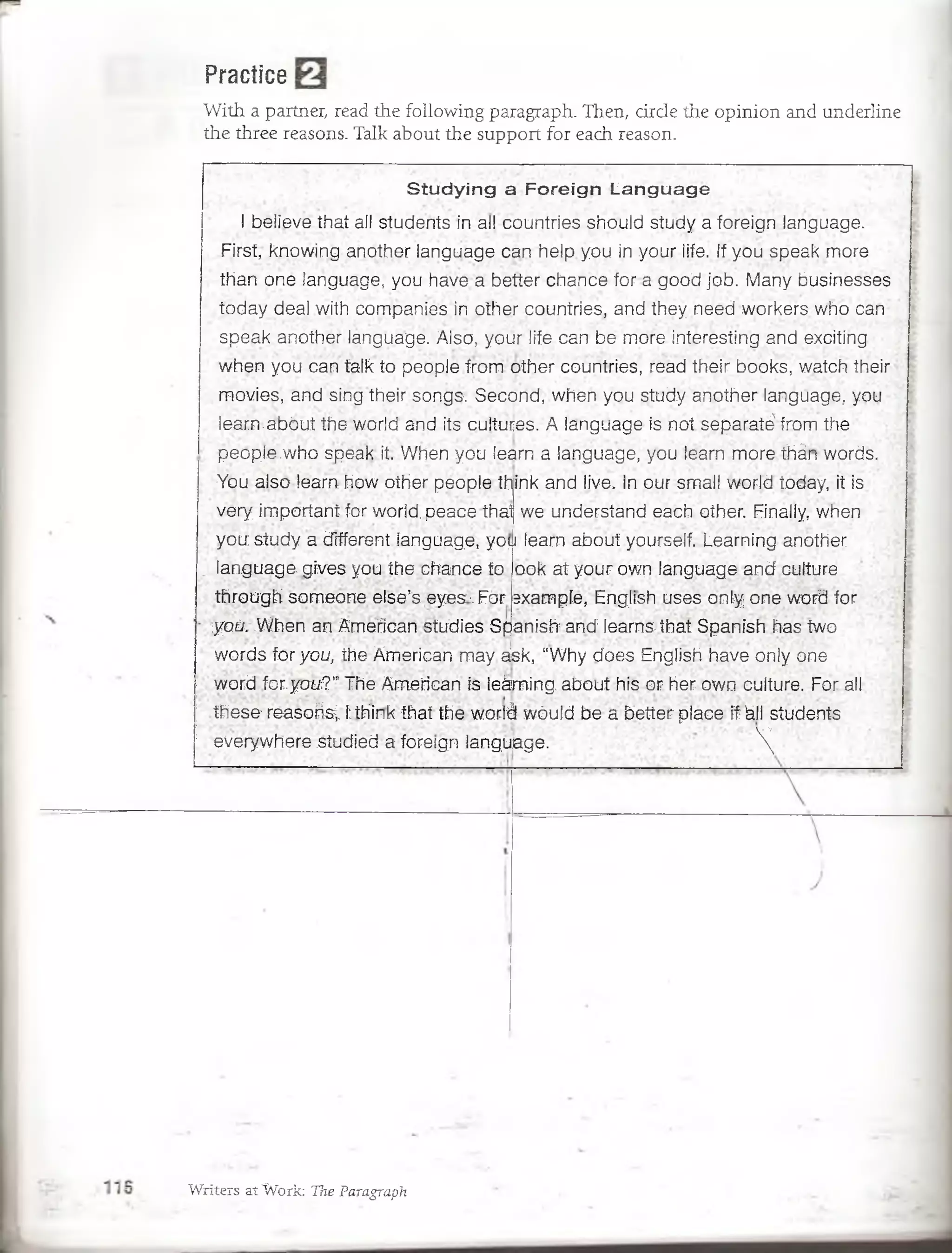


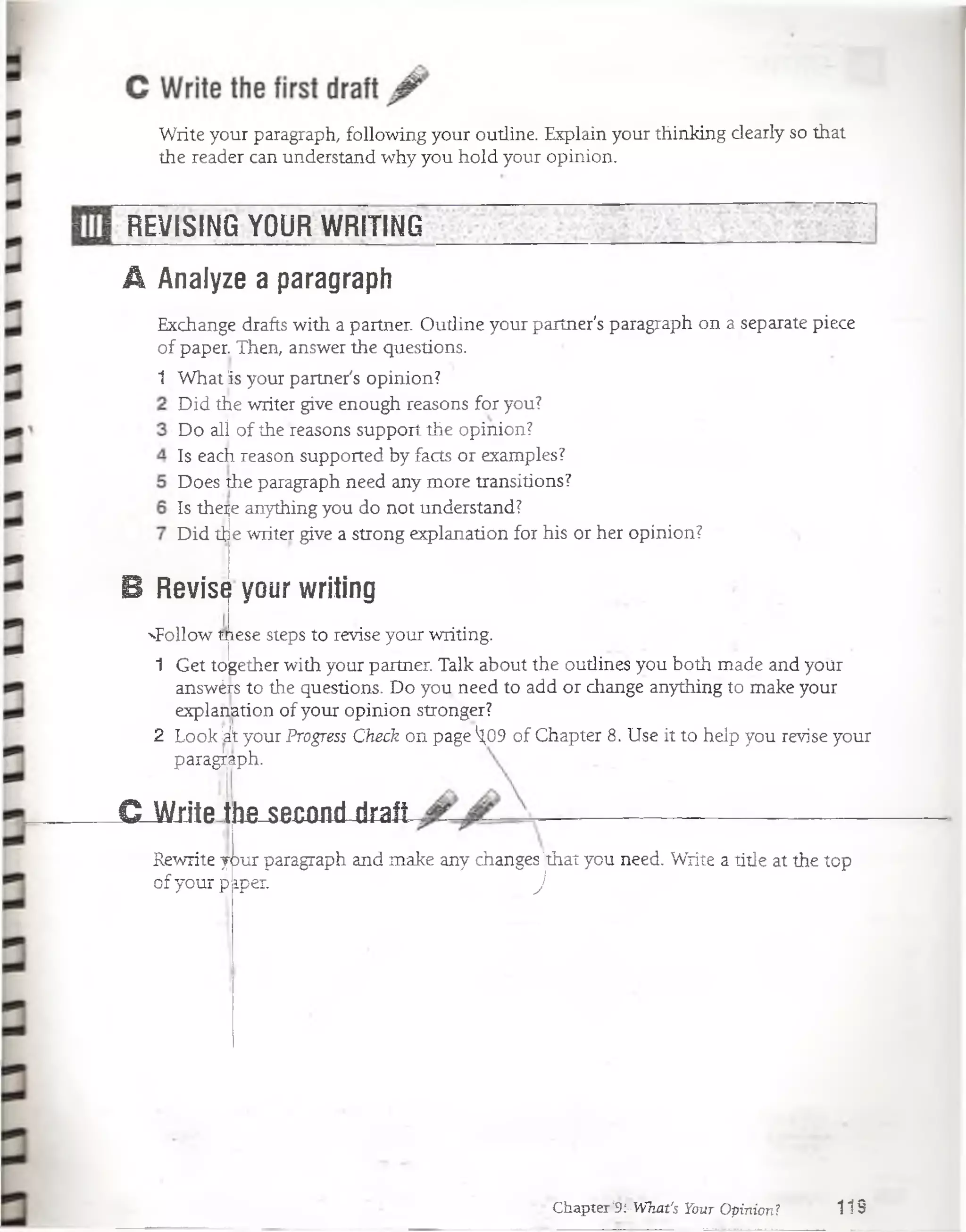
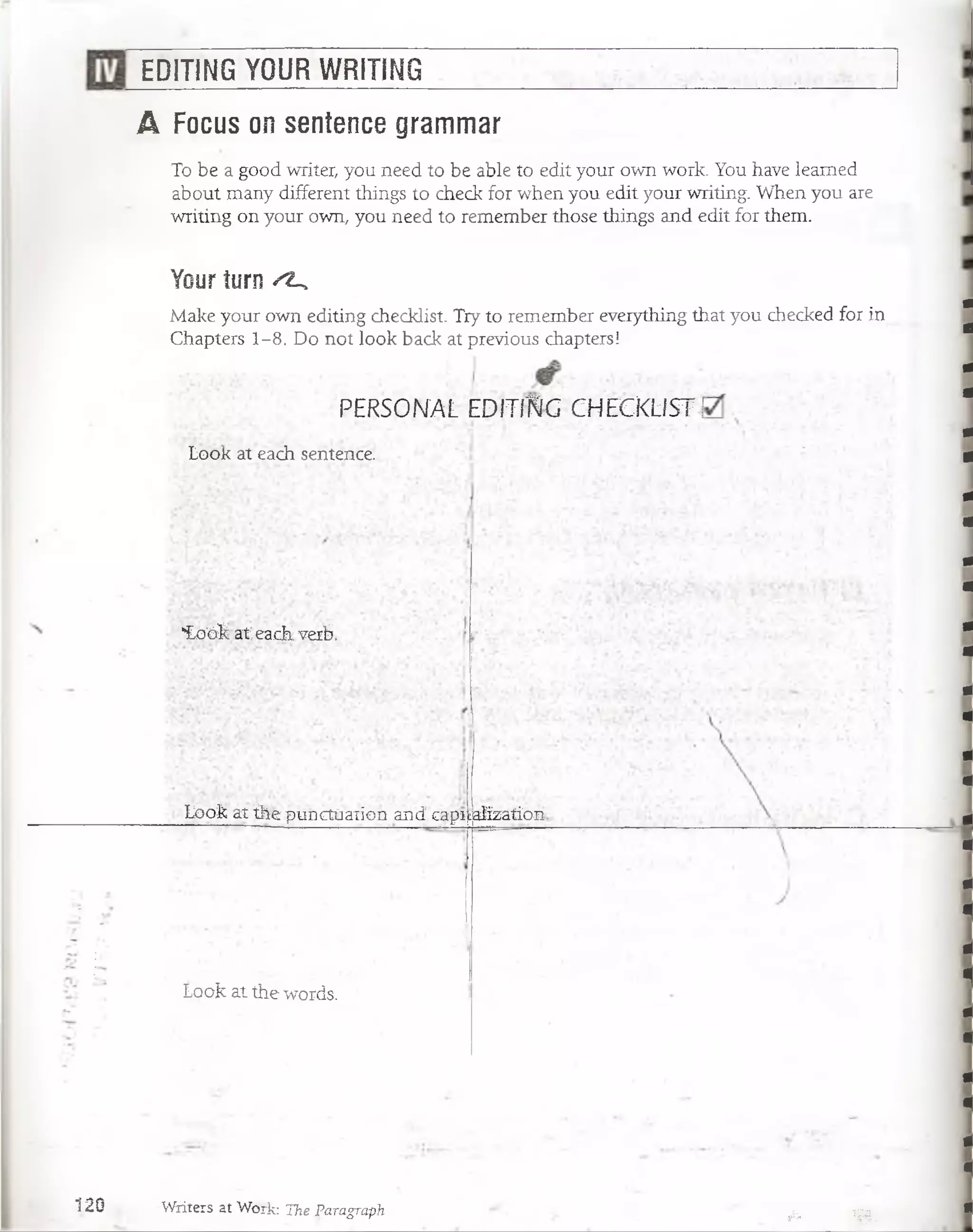


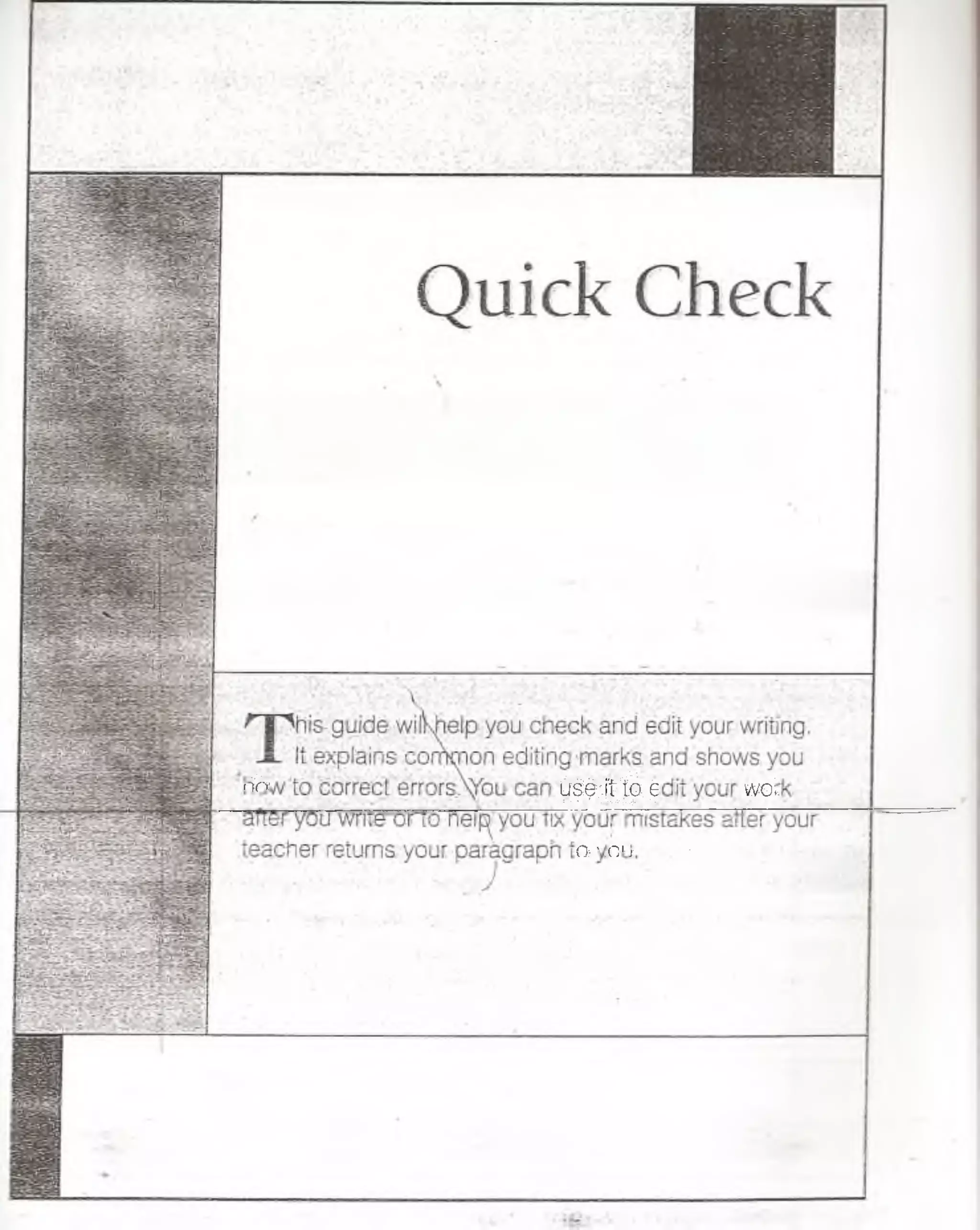

![n COMMON WRITING PROBLEMS
A Verb problem (V)
1 D o I need to use the simple presentí
a Use simple present for
habitual actions.
I sleep late every Saturday
morning.
b ]Jse simple present for
facts.
• L
They are brothers.
Élive in Toronto.
2 D
I, you, we, they talk
He, she, it talks
to do + not + verb
1, you, we, they do not talk
He, she, it does not talk
•1tievérb-íoíb^vf;- ‘ í. i
. 1am 1am not
You, we, theyare You, we, they are not
He, she, itis Hé, she, it is not
o I need to use the present Progressive?
Arijevént is happening at
tJiejtime o f speaking.
Loo|l It is snowing.
to be + verb + ring
am talking .W
Yoüywe, they are talking
He, she, it is talking
to be + 7iot + verb + -m&.
ta /77 not taiking
You, we, íhey are not talking
He, she, itis not talking
3 Dio i need to use ih.^~simpler p asli
m I B B I H ^ I
1 Anjivent happened and .
ñnished in the past.
! •
i calíed her iast night
■
!
verb + - e d _
i, you, he, she,it, we, they
talked
(For irregular verbs, see the
chart on the next page.)
did -i- not -í- verb ...
1, you, hé5she, it we, they did
nGttalk
The verb te be
1. he, she,.itwas
You, we.. they were jj £
1. he, she, tw a s ,m t¿
You, we, they weréñqHir
' -
Quíck Check 125](https://image.slidesharecdn.com/writersatwork-130924081026-phpapp02/75/Writers-at-work-137-2048.jpg)


